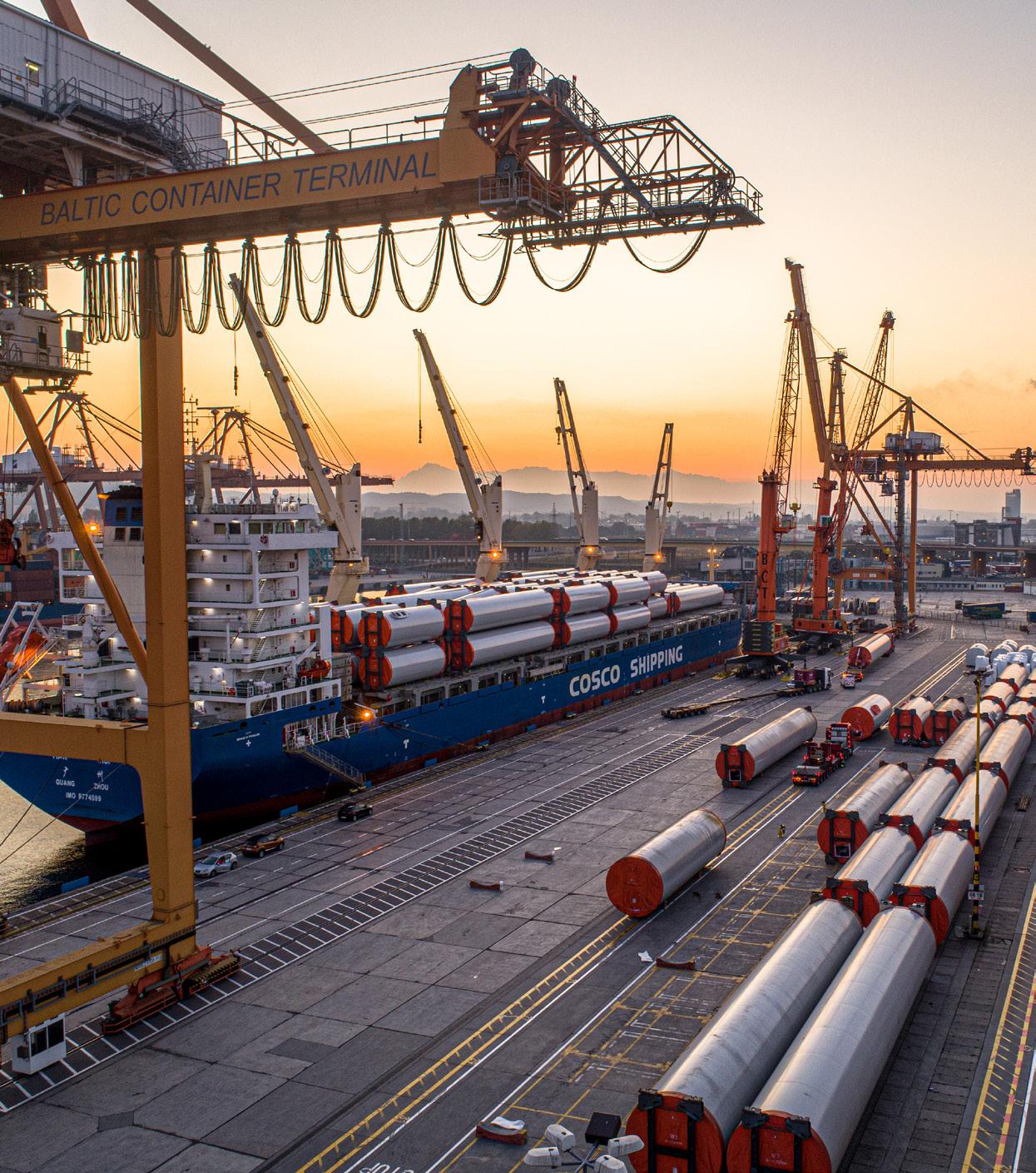
DECEMBER 2022 VOL 1022 ISSUE 10 portstrategy.com
INVESTMENT RISKS ESCALATE OFFSHORE WIND: Opportunities Build THE DOVER AGENDA AVOIDING RUSSIAN ROULETTE
Coastlink: The Road to Net Zero | Kaliningrad Tightrope | Market Share versus Profits

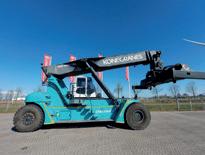
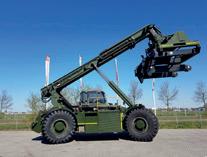

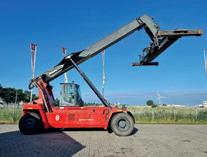

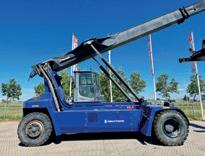
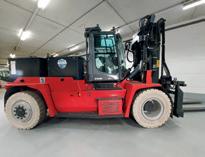
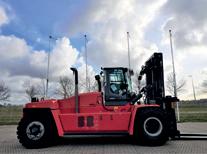


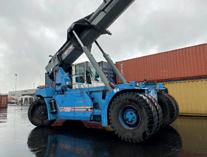
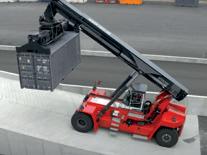
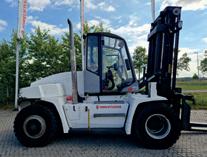

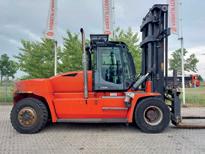
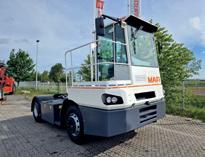

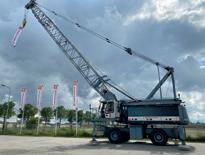
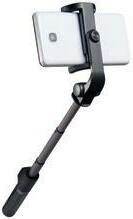
Formulating an effective development approach in the containerport sector is becoming inherently more complex – political risk considerations, effectively balancing public and private sector priorities and adapting to higher interest rates are all areas of challenge. On a more positive note, commitment to offshore wind projects is escalating bringing new opportunities to both frontline and secondary ports
VIEWPOINT
MIKE MUNDY
Plenty To Think About
There is no mistaking the fact that ‘Xmas’ is over in the container shipping sector. Lean times are ahead in the majority of world markets compounded by the age-old folly of too much new shipping capacity too soon.
Thinning demand is further complicated by the ongoing shock waves from Russia’s aggressive actions in Ukraine and the ensuing spike in energy prices. This brings the once largely remote spectre of political risk into the forward planning equation, as discussed in the article Investment Risks Build on p20. The wider uncertainties and industry specific factors are charted, as well as possible future scenarios in which port sector development activity will take place.
In a more specific context, the challenges regarding achieving a win : win in port and terminal development between public authorities and private sector terminal operators are considered on p50. Focusing particularly on the next round of development activity in mature markets, where neighbouring ports serve over-lapping hinterlands, the conundrum is examined of how to reconcile the economic impact-orientated agenda of port landlords with the profit motive of terminal operators?
Adding further perspective on the container sector, on p40 we review the latest thoughts of market consultancy Drewry on the short-term outlook for container shipping. Strikingly, Drewry states: “There is a palpable sense that things are falling apart. “ Drewry cites the world lurching from a once-in-a century global health crisis straight into an economic crisis with barely a pause and suggests that with energy and food costs rampant, consumers are likely to prioritise basics.
There are, nevertheless, some rays of sunshine outside of the container sector. A series of articles in this issue look at various offshore wind markets. There is a tangible sense that ‘offshore wind is coming’ and, as part of this, significant opportunities for the port and terminal sector – in conjunction with both the set-up and ongoing maintenance of offshore wind farms. This includes the opportunity for secondary ports to get in on the act. The one question mark is, will there be adequate heavy lift shipping capacity available to meet market needs? This issue is highlighted in the article Tough Times for Multipurpose Vessel Market featured on p33.
The end of 2022 leaves the global port industry with serious challenges looming and doubtless compounded by the recent elevation in interest rates. In short, plenty to think about and to factor into building a winning strategy.
Merry Xmas and safe navigation of 2023.
The international magazine for senior port & terminal executives
EDITORIAL & CONTENT
Editorial Director: Mike Mundy mmundy@portstrategy.com

Features Editor: A J Keyes keyesj186@gmail.com
Consultant Editor: Andrew Penfold andypenfold@yahoo.com

Regular Correspondents: Felicity Landon; Stevie Knight; John Bensalhia; Ben Hackett; Peter de Langen; Barry Parker; Charles Haine; AJ Keyes; Andrew Penfold; Oleksandr Gavrylyuk Johan-Paul Verschuure; Phoebe Davison
Production
David Blake, Paul Dunnington production@mercatormedia.com
SALES & MARKETING
t +44 1329 825335
f +44 1329 550192
Media Sales Manager: Arrate Landera alandera@mercatormedia.com Marketing marketing@mercatormedia.com
Chief Executive: Andrew Webster awebster@mercatormedia.com
PS magazine is published monthly by Mercator Media Limited, Spinnaker House, Waterside Gardens, Fareham, Hants PO16 8SD UK t +44 1329 825335 f +44 1329 550192 info@mercatormedia.com www.mercatormedia.com
Subscriptions
Subscriptions@mercatormedia.com Register and subscribe at www. portstrategy.com 1 year’s digital subscription with online access £228.50
For Memberships and Corporate/ multi-user subscriptions: corporatesubs@mercatormedia.com
©Mercator Media Limited 2022. ISSN 2633-4232 (online).
Port Strategy is a trade mark of Mercator Media Ltd. All rights reserved. No part of this magazine can be reproduced without the written consent of Mercator Media Ltd. Registered in England Company Number 2427909. Registered office: c/o Spinnaker House, Waterside Gardens, Fareham, Hampshire, PO16 8SD, UK.
For the latest news and analysis go to www.portstrategy.com DECEMBER 2022 | 3
PORTSTRATEGY INSIGHT FOR PORT EXECUTIVES
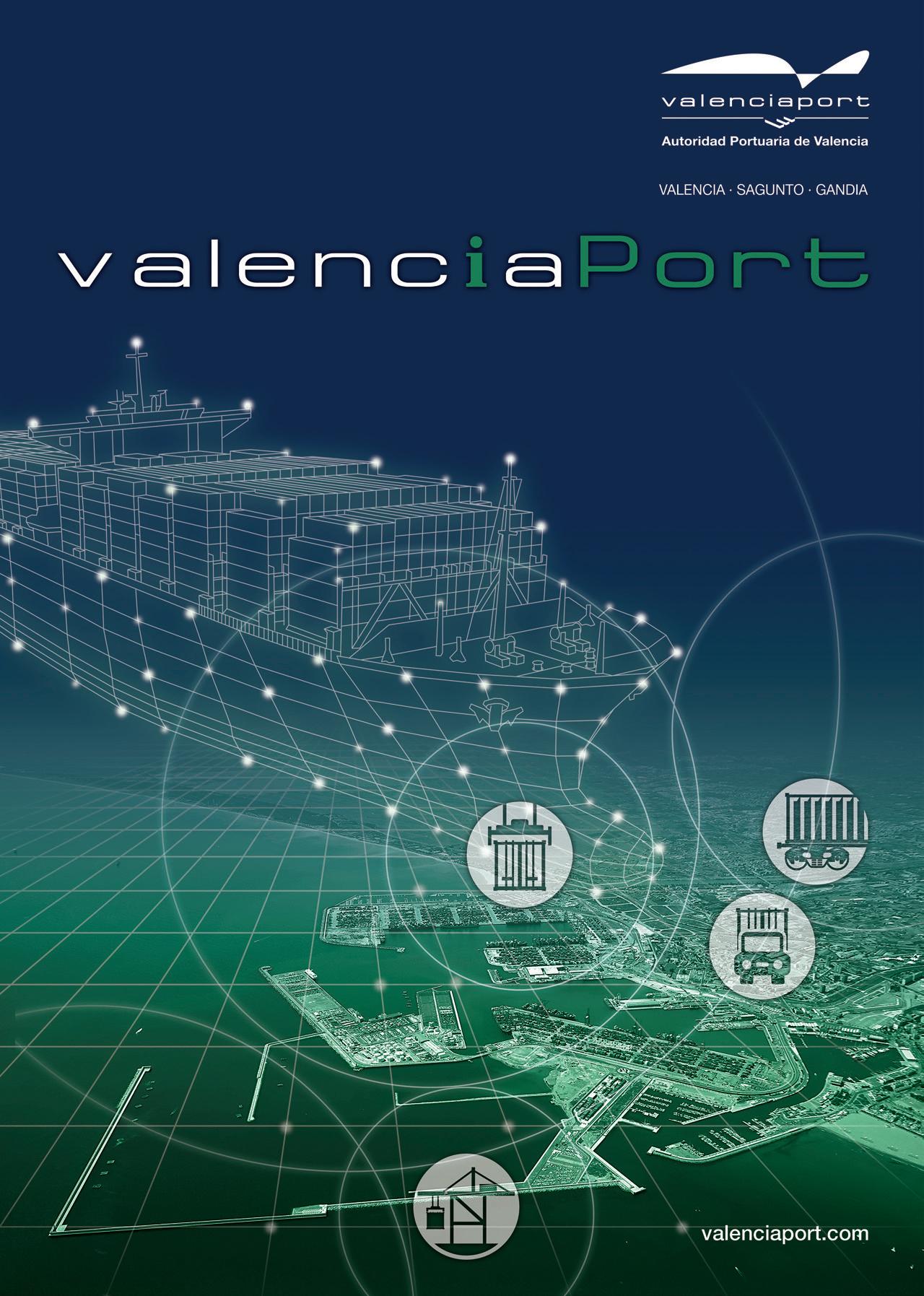
CONTENTS DECEMBER 2022
is a proud support of Greenport and GreenPort Congress
GreenPort magazine is a business information resource on how best to meet the environmental and CSR demands in marine ports and terminals. Sign up at greenport.com



The Congress is a meeting point that provides senior executives with the solutions they require to meet regulatory and operational environmental challenges. Stay in touch at greenport.com
Online
portstrategy.com 5 Latest news 5 Comment & analysis 5 Industry database 5 Events
Online
Social Media links
LinkedIn PortStrategy portstrategy YouTube
Social Media links
Weekly E-News
Sign up for FREEat: www.portstrategy.com/enews
Social Media links LinkedIn PortStrategy portstrategy
portstrategy.com 5 Latest news 5 Comment & analysis 5 Industry database 5 Events
Weekly E-News

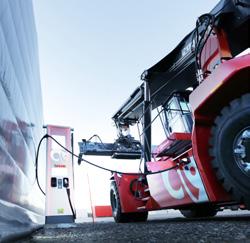
Sign up for FREEat: www.portstrategy.com/enews
LinkedIn PortStrategy portstrategy YouTube
The Congress is a meeting point that provides senior executives with the solutions they require to meet regulatory and operationalenvir challenges. Stay in touch at greenport.com
Join leading port executives in Athens, Greece from 14-16 October 2019 www.greenport.com/congress
The Congress is a meeting point that provides senior executives with the solutions they require to meet regulatory and operationalenvironmental challenges. Stay in touch at greenport.com
Join leading port executives in Athens, Greece from 14-16 October 2019 www.greenport.com/congress




the latest news and analysis go to www.portstrategy.com DECEMBER 2022 | 5
For
YouTube The Congress is a meeting point that provides senior executives with the solutions they require to meet regulatory and operationalenvironmental challenges. Stay in touch at greenport.com Join leading port executives in Athens, Greece from 14-16 October 2019 www.greenport.com/congress www.portstrategy.com/enews On the cover The Baltic Container Terminal, Gdynia is an established hub for handling components for the onshore wind market and has the expertise to smoothly transition to meeting the building requirements of the offshore wind
Russia’s aggressive actions in the
have provided added impetus to offshore wind farm development
prompting, in turn, new port sector opportunities NEWS FEATURE ARTICLES REGULARS 18 The New Yorker Pivotal Ports in Green Corridors 18 The Analyst Competitive Methanol? 19 The Economist After (New) Normal 19 The Strategist PSA in for Adani? 20 Investment Risks Build Political risk to the fore 22 The Road to Net Zero Challenges and Opportunities 24 Optimising Offshore Wind Logistical Challenges & Solutions 26 Starting Blocks US Offshore Wind 29 Russia Triggers Transition Baltic Offshore Wind 33 Tough Times MPV Market Issues 34 Dover Agenda Frustrations and Aspirations 36 Russian Roulette Baltic Box Port Strategies 39 Kaliningrad Tightrope Sanctions Issues 40 Market Fundamentals Container Shipping Challenges 42 Electric Power Play Reach Stacker Advances 44 Second Time Around Used Equipment Options 54 Postscript Public v Private Development Challenges DECEMBER 2022 VOL 1022 ISSUE 10 portstrategy.com Coastlink: The Road to Net Zero Kaliningrad Tightrope Market Share versus Profits INVESTMENT RISKS ESCALATE OFFSHORE WIND: Opportunities Build THE DOVER AGENDA AVOIDING RUSSIAN ROULETTE 17 Acquisition Activity Potential and Actual Deals 17 Baltimore Box Deal New MSC Terminal 19 Bagamoyo Project Back on the Agenda 19 SC Ports Investment State Funding Gained 11 Global Deployment Hapag-Lloyd signs Portchain 11 Digital Maritime View from Space 13 HHLA Next Optimising Calls 13 Santos 5G A LatAm Port First 15 Dual Fuel Trials Stockholm Tractor 15 ABP Mobiles Mobiles on the way 17 Major Upgrade San Antonio Invests
market.
Ukraine
in the Baltic
HOLY HYSTER, IT’S ELECTRIC
Hyster has a legacy of thinking big and turning our insight into industry breakthroughs. Our new Hyster ® Zero Emissions Container Handlers utilize hydrogen fuel-cell technology and integrated lithium-ion power to help lower emissions, fuel consumption and maintenance costs while delivering the ICE-like performance and efficiency your operation needs to tackle tough tasks.

ACQUISITION ACTIVITY SPIKES WITH PORT SECTOR DEALS PROMINENT
Acquisition activity in the ports and wider shipping and logistics sector is seeing something of a spike.
Singapore to take a stake in Adani? As discussed on p19, the bush telegraph beats that the Port of Singapore is closing in on buying a stake in Adani Ports & SEZ. The investment is reportedly to be used for expansion and acquisitions.
Also up for sale before the end of the current financial year is a 30 per cent stake in publicowned rail operator Container Corp of India (Concor), India’s largest container rail operator. The Indian Government is said to be showing new resolve to get on with the sale process with a number of pre-bidding sessions reported to have taken place with interested parties such as AP Moller Maersk.
Recently completed port deals include AD Ports purchase of Noatum, Stonepeak and Spirit Super’s acquisition of GeelongPort in the State of Victoria, Australia. Late October also saw an announcement that China Ocean Shipping Company (COSCO) had, around mid-year, disposed of its 30 per cent stake in the planned new Duisburg Gateway Terminal (DGT). The news of this transaction was released shortly after the German government approved the
acquisition of a minority stake of less than 25 per cent in HHLA’s Container Terminal Tollerort GmbH by COSCO.
The Noatum disposal also involved COSCO, the company having acquired a 51 per cent stake in the ports, maritime and logistics sector focused group in 2017 for US$228 million. Noatum was acquired by AD Ports on a 100 per cent ownership basis for EUR660 million. The company’s port sector portfolio includes major container terminals in Spain in Valencia and Bilbao and overall a total number of 15 terminals spanning general cargo, ro-ro, container and other facilities.
AD Ports purchase of Noatum also followed hot on the heels of
8 AD Port’s 100 per cent purchase of Noatum will see it take over container handling operations in Spain including in the leading ports of Valencia and Bilbao
its November purchase of an 80 per cent stake in Dubai-based Global Feeder Shipping and September purchase of a 70 per cent stake in Transamar, the Middle East/East Africa regional container shipping company and terminal operator.
The Geelong port purchase has been undertaken by two essentially financial entities. Stonepeak is a US-based investment company specialising in infrastructure and Spirit Super a pension fund. The transaction is expected to close around the end of the first quarter of 2023.
MSC TO BUILD NEW BALTIMORE BOX TERMINAL
MSC’s port sector operating subsidiary, Terminal Investment Limited (TIL) in partnership with local property developer Tradepoint Atlantic, is set to establish a new container terminal in Baltimore on the site of a former steel mill.

The terminal will occupy 67ha on the brownfield site at Coke Point, a component of the Sparrows Point area of the port which formerly housed the Bethlehem steelworks and shipyard, an area which Tradepoint Atlantic has a remit to develop.
The terminal is planned to possess on-dock rail with complementary works on
BRIEFS
Panama Alternative
A project to establish a cross Colombia underground tunnel as a rival to the Panama Canal is now seeking initial funding of US$75m. The scheme, being promoted by Florida-based Zergratran – a transport infrastructure company, envisages the tunnel using Maglev technology to transfer containers between the Pacific and Atlantic coasts in under 30 minutes. Both ends of the tunnel will be served by a fully automated port.
Newcastle Handcuffs Off
The recently enacted Port of Newcastle (Extinguishment of Liability Bill) 2022 opens the door for the removal of restrictions placed on the Australian east coast port that have prevented it from entering the theatre of container operations. In 2013 the New South Wales State Government applied a TEU cap to the port with the objective in mind of focusing container traffic on the port of Botany Bay and to a lesser extent Kembla. It is anticipated that the port of Newcastle, better known for coal export operations, will revive plans to attract investors interested in establishing a container terminal operation.
PAV Solar Initiative
expanding the Howard Street Tunnel, the rail line that runs under the city of Baltimore connecting the port to the hinterland, seen as integral to the project viability. The tunnel is being enlarged by CSX with the
The Port Authority of Valencia (PAV) has fixed a contract for the installation and maintenance of solar energy plant at the port of Gandia which it says will make the port Europe’s first energy self-sufficient port. A EUR1.7 million project, the construction of the solar power plant is expected to take approximately eight months to complete.
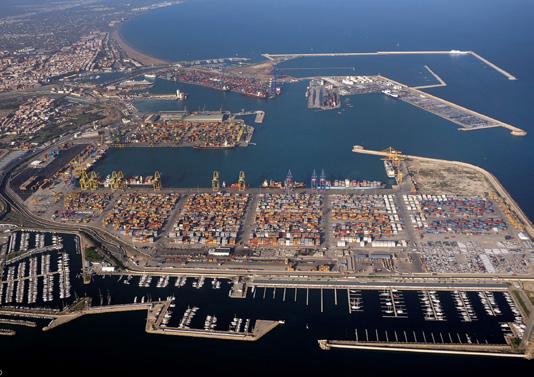
For the latest news and analysis go to www.portstrategy.com DECEMBER 2022 | 7 PORT & TERMINAL NEWS
objective of facilitating use by double-stack trains.
8 MSC’s Terminal Investment Limited is partnering with property developer Tradepoint Atlantic to develop a new container terminal in the port of Baltimore, USA
FREELANCE WRITERS WANTED
Port Strategy magazine, published 10 times a year and supported by an on-line news service, is looking for freelance writers with specialist skill sets as part of a programme to expand its coverage.
The magazine covers all critical aspects of port and terminal activities right through from planning and development to the port’s role in the supply chain and the latest requirements of port users and investors. Applications from candidates are invited with one or more of the following skill sets: 5 A detailed knowledge of cargo handling plant – its specification, operation and maintenance across different cargo sectors – container, general cargo, ro-ro, dry bulk etc. 5 A detailed knowledge of marine infrastructure design, specification and maintenance spanning both the broad aspects of port design and terminal development.
5 An understanding of the digital world and processes as applied to the port and terminal sector and the supply chain as it effects port activities.

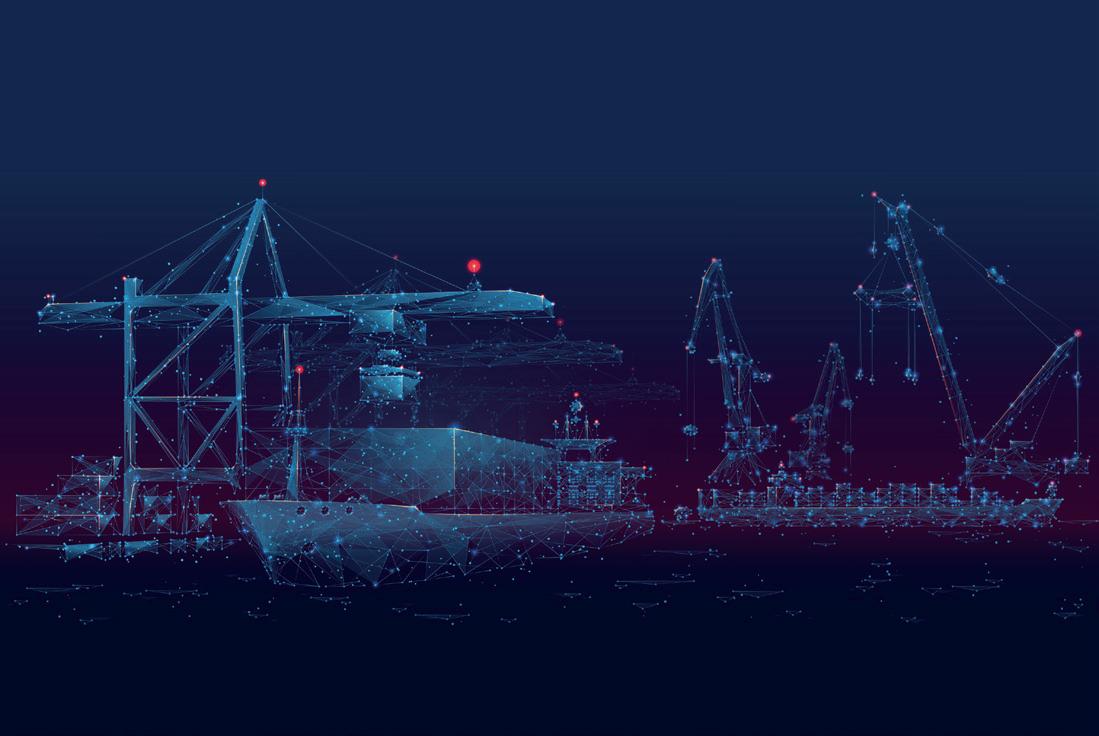
Interested parties are invited to forward their CV, highlighting relevant experience, to: Mike Mundy, Editorial Director, Port Strategy mike@mikemundyassociates.co.uk



YOUR PREFERRED SOLUTIONS PARTNER TRUSTED INDEPENDENT EXPERIENCED WCS ALSO OFFERS OPERATIONAL & QHSE BASED CONSULTANCY SERVICES SPECIALISING IN PORTS & TERMINALS & IS UNIQUELY POSITIONED TO PROVIDE SOLUTIONS TO OVERCOME ISSUES ENCOUNTERED BY CLIENTS IN THESE CHALLENGING TIMES. www.worldcraneservices.com & www.wcs-consultancy.com WORLD CRANE SERVICES OFFERS SPECIALIZED SERVICES FOR PORT EQUIPMENT IN THE SHIPPING, MARITIME & OFFSHORE INDUSTRIES WORLDWIDE - BASED IN DUBAI & SHANGHAI, WITH KEY PERSONNEL GLOBALLY AVAILABLE. JOB ADVERTISEMENT PORTSTRATEGY MAGAZINE Mercator Limited
TANZANIA’S MEGA BAGAMOYO PROJECT BACK ON THE AGENDA
South Carolina Ports Readies State-Funded Projects
South Carolina Ports (SC Ports), USA is the beneficiary of US$550 million in state funding which is to be used for setting up a near dock intermodal rail yard and establishing an inner harbour barge operation.
The near dock rail facility, designated the Naval Base Intermodal Facility, will serve the port of Charleston and is located approximately one mile from the Leatherman Terminal.
Connection between the two facilities is via a dedicated road.
Under the phase one development of 80,000ft of rail track will provide capacity for up to one million rail lifts. Working in conjunction with Palametto Railways, Class 1 railroads CSX and Norfolk Southern will provide service to/from the facility.
The Tanzania Ports Authority (TPA) reports that the Bagamoyo Port project is back on its agenda following a period of it being shelved due to cost considerations.
The view is that the new port of Bagamoyo will be required with the prospect in sight of the country’s main port of Dar es Salaam eventually running out of available capacity.
The intention is to seek out an investor for the project but with the TPA also financing part of the project.
China Merchant Holdings
International has previously expressed interest in the project, which overall is expected to cost in the order of US$10 billion but this interest closed in 2018 with Tanzania reporting that it had been unable to agree terms, including regarding arrangements relating to setting charges for the use of the port. Today, however, according to Plasduce Mbossa, Director General, TPA, there are a number of interested parties that TPA will engage with as it ramps up efforts to get construction work underway in the next financial year.
8 An artist’s impression of the planned new Bagamoyo Port where the introduction of substantial new container capacity is planned

The Bagamoyo port project, located 75 kilometres from Dar es Salaam, is an ambitious scheme with an ultimate vision of providing capacity sufficient to handle 20 million TEU by 2045 – 25 times the amount of cargo that Dar es Salaam port handles today. It will sit in the Bagamoyo Special Economic Zone which is additionally intended to attract a large scale cluster of diverse industries.
The total cost of development of the new intermodal rail yard is put at US$400 million.
The inner harbour barge operation is intended to complement the Naval Base Intermodal Facility by moving containers between the Wando Welch Terminal and Leatherman Terminal via a prescribed marine highway. Total project cost for this project is put at US$150 million.
The start-up of operations with both projects is targeted for 2025.
BRIEFS
Innovation
Hub UK ports are collaborating via the Maritime Innovation Hub and sharing non-commercial data with the aim of promoting efficiency and best practice in conjunction with activities such as clean energy, decarbonisation, cyber security, asset management and health and safety. Founding members include: Aberdeen; Associated British Ports, Belfast, Bristol Port Company, Forth Ports Poole and Shoreham with further ports expected to join imminently.
Drone Deployment
The Port of Rotterdam is to run trials with drones to achieve sea-going and inland shipping inspections as part of efforts to reduce pollution. Particular emphasis will be on coverage of air pollution (smoke etc), shipto-ship transfer, shore-to-ship transfer, zoning for hazardous substances and onboard vessel repairs. Drones are to be supplied by Netherlands-based Avy and specifically its Avy Aera 3 which possesses a cruise speed of 90kmh per hour.
Saudi Seeks US$10bn
Saudi Arabia has announced that is looking for up to US$10 billion in supply chain investments. The aim is to make the Kingdom a key location for supply chain focused investors and to secure up to US$10 billion in investments in the first two years. Under a programme called the Global Supply Chain Resilience Initiative investment opportunities for investors will be identified and various special economic zones established.
Fast Track Sydney
The Government of New South Wales is fast-tracking a project to develop renewable energy shore power at the Glebe Island and White Bay facilities in Sydney. As a result, two berths are now targeting ships being able to plug in by the end of 2024, with a further three bulk berths offering the same facilities by 2030. A significant reduction in both carbon emissions and noise pollution are expected.
For the latest news and analysis go to www.portstrategy.com DECEMBER 2022 | 9 PORT & TERMINAL NEWS
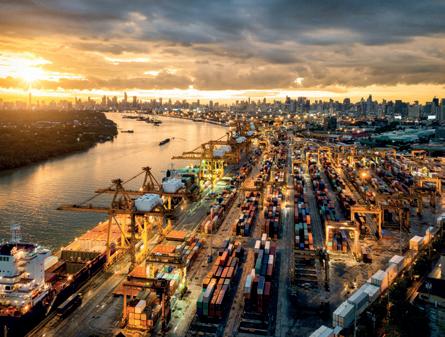





is the leading international finance and strategy consultant in port business solutions
value in the maritime & transport industry
Feasibility Business Case Value Creation & Protection Financial Modelling & Analysis Project Structuring & Packaging Risk Valuation, Allocation, Mitigation STRATEGY Port Policy Port Sector Reform Value & Business Strategy Public Private Partnerships (National) Port Master planning Institutional & Regulatory Change Organisational Reform & Alignment
Financial Solutions Transaction Strategy Transaction Management Documentation & Contracts Tendering & Negotiated Solutions
Diligence Project Financing Financial Structuring Procurement of Finances Investment/Divestment Merger & Acquisition
MTBS
Unlocking
MTBS.NL VALUATION
TRANSACTION
FINANCE Due
Leading German shipping line, Hapag-Lloyd, has signed a new five-year partnership with Portchain Connect. The agreement will see the Portchain platform deployed across all of the shipping line’s global operations.
Portchain Connect offers a digitalised process that aligns berths between ocean carrier vessels and terminals, which then allows earlier and more frequent scheduling decisions to be made. This is in-line with the recent International Maritime Organization (IMO) view that both of these elements can be decreased by a combined 5.9 per cent in the 24-hour period before a vessel arrives.
Hapag-Lloyd is planning to utilise the Portchain Connect service to transition from the existing email and telephone communication approach into a digital information flow that will
SINAY – ESA
Sinay has signed a new €1.6 million contract to create a digital maritime platform with the European Space Agency (ESA).
HAPAG LLOYD SIGNS WITH PORTCHAIN FOR GLOBAL DEPLOYMENT
provide its terminal network portfolio with real-time and immediate access to shipping
schedule updates and key information about the vessels in service.
MARITIME DIGITAL PLATFORM
The French maritime tech company states that the new Digital Port Platform will show how the integration of space assets can be a “key enabler” for maritime sustainability and port system evolution. This will be achieved by transforming space and maritime data into key indicators, and thereby enabling data-driven management to solve major environmental and performance issues.
This new platform will contain
Secure Rotterdam
The Port of Rotterdam is implementing a quantum communications system that it says will ensure communications for all port customers cannot be compromised. The central hub situated at the port authority is connecting users and other maritime logistics companies, through the system created by QuTech, a collaboration between the Delft University of Technology and TNO.
a range of different industryrelated modules, each of which address key bottlenecks and/or ongoing challenges for a wide range of industry stakeholders. This includes predicting the time of ship arrivals in order to reduce port congestion and vessel delays, real-time monitoring of maritime equipment, and port business intelligence to help the Smart Port ecosystem and collaborate on daily activities. Organisations expected to benefit are port authorities, terminal operators, shipping companies, Harbour Masters, and offshore/marine contractors.
JLT Validated
The VERSO Series of highperformance vehicle-mounted terminals (VMTs) has gained Navis Ready Validation for the latest version of the Navis N4 terminal operating system. VERSO is produced by JLT Mobile Computers, a specialist in supplying IT solutions across the port environment. The company states that its VERSO Series is a robust mobile IT platform designed for use in the harshest and most demanding port operating environments.
Alessio Maglio, Project & Business Manager, Sinay, notes: “Gathering powerful information from the ESA will allow Sinay to help maritime corporates to build business efficiency with ocean sustainability.”
Rita Rinaldo, Head of Projects and Studies Implementation Division at ESA similarly states: “The Digital Port Platform will play a crucial role in helping to better understand, monitor and forecast the port ecosystem. The developments targeted in the project are ambitious but necessary given the scale of the issues to be addressed.”
Project 44 Gets More
Project 44, a supply chain visibility provider in which AP Moller Holding has an interest, has secured additional funding of US$80 million. This latest injection led by Generation Investment Management and AP Moller Holding, increases the company’s valuation to US$2.7bn and will help drive several key initiatives, including upgrading its system that measures supply chain emissions across different modes of transport.
Andrew Allen, Director –Terminal Partnering, Hapag-Lloyd notes: “We believe in the power of leveraging automated data flows to optimise our Port Calls and create transparency and efficiency for our Marine and Port Operations teams globally.
He underlines that Portchain will be able to “digitise and streamline” the operator’s “berth alignment processes” to the benefit of not only the shipping line, but also terminal partners.
Hapag-Lloyd currently operates a fleet of 252 ships and transported 11.9 million TEU in 2021. For the first nine months of 2022 volumes were recorded at just under 8.99 million TEU, which compared to 8.98 million TEU for the comparable period in 2021.

BRIEFS
Kingston’s DATAVIEW
DATAVIEW from DSP has been selected by Kingston Freeport Terminal Ltd as its business intelligence system. The DATAVIEW platform provides live performance indicators relating to port operating metrics to identify trends and help support business decisions and investments. In Kingston, operating data will be consolidated into live dashboards to optimise and monitor performance at all times and offer support on a continuous basis.
For the latest news and analysis go to www.portstrategy.com DECEMBER 2022 | 11 DIGITAL NEWS
8 Hapag-Lloyd will deploy Portchain on a global basis to digitise and streamline its port arrival and berthing processes

HHLA NEXT LAUNCHES HEYPORT TO OPTIMISE PORT CALLS
HHLA Next has developed a new product called heyport that is designed to synchronise all planning activities in real-time, thereby giving operational decision-makers more information to make informed and accurate decisions.
There is a particular focus on berth and ship planning activities, especially to aid changes required at short notice, while generating improved communication and coordination overall.
Approximately a year ago, Hamburger Hafen und Logistik AG (HHLA) established what it dubbed as ‘HHLA Next,’ a new strand to its business that could quickly and precisely identify and advance innovation across the transport and logistics sectors of its service offering, and, potentially, the wider industry.
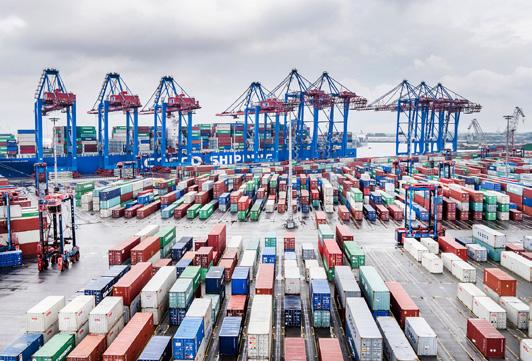
The approach of HHLA Next is to develop the climate-neutral transportation of goods and products on a global basis, by establishing its own affiliated companies employing original business models or by investing in innovative organisations, at an early stage of the company or product development.
A previous example of this strategy from HHLA is its interest in the HyperPort technical concept that utilises HyperLoop technology. The company is still progressing its aim of furthering this concept which could eventually see up to 2800 containers moving daily in a closed environment without any traffic involvement or impact on the environment.
Angela Titzrath, Chairwoman of HHLA’s Executive Board, highlights the rationale behind such product launches: “We see innovation and technical excellence as crucial elements in
8 HHLA has launched Heyport, offering a specialised focus on digitalising port call information
developing sustainable solutions, being environmentally responsible and operating successfully in line with our self-image as the ‘gateway to the future’. Through HHLA Next, we are thus investing in innovative businesses like Heyport at an early stage, and our aim is to take advantage of the potential in shaping a sustainable future for our industry – both under our own strength and by interconnecting with other operators in the logistics sector.”
5G PARTNERSHIP FOR THE PORT OF SANTOS
The first 5G private port network in Latin America is being implemented. A partnership involving Santos terminal operator Brasil Terminal Portuário (BTP) and telecommunications providers TIM and Nokia aims to take advantage of the release of increasing bandwidth for the City of Santos, as scheduled by national regulator, Anatel, during 2023.
BTP states that one of its main objectives of utilising the network access is to enable the implementation of various solutions that can increase equipment connectivity, while also boosting operational efficiency. This includes the remote and real-time monitoring of equipment, such as cranes and all other
operational activities at the time, with monitoring maintained from a dedicated central location.
Improved communication between terminal departments and personnel is also a primary objective.
Ricardo Arten, CEO, BTP, states: “We want to increase our operational capacity within the current limits of the terminal and
8 Brasil Terminal Portuário (BTP), Port of Santos, plans to tap the inherent advantages of 5G
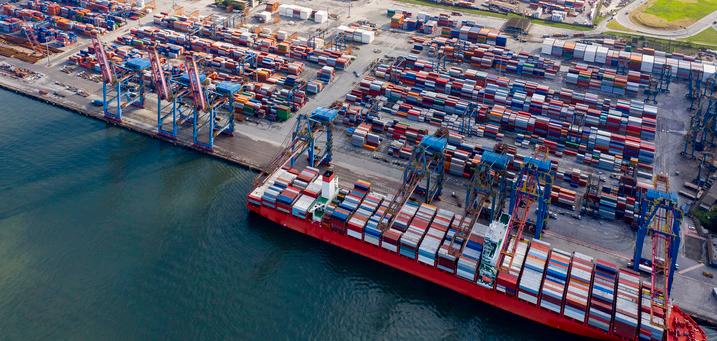
technology is key in this process. We believe technology has the power to make the port sector more efficient, safe, and sustainable. We are continually investing in the development of new digital tools and technologies.”
BRIEFS
UK Drone Funding
Associated British Ports (ABP) is among a consortium of six partners that have received funding for the construction and testing of drones. The UKbased consortium is known as ‘Intelligent Drones for Port and Highways Technology (InDePTH)” and along with ABP consists of BT, Robok, HeroTech8, Kier and Connected Places Catapult. The UK government funding is through UK Research and Innovation (UKRI), with the overall project aiming to monitor and control critical national infrastructure such as highways and ports.
Driverless Technology
Huawei has developed an AI-based horizontal system of L4 driverless technology designed for use in the port of Tianjin, China. The company reports the use of China’s BeiDou navigation satellite system ensures better use of AI and promotes self-sufficiency in green electricity and zero carbon emissions. Remotely controlled quay cranes are complemented by container trucks that to travel to the automatic locking/ unlocking stations by following an optimal driving route calculated in real time.
Allread Funding
Allread, the Spanish startup providing artificial vision software to the shipping and logistics industry, has confirmed closure of a €2.5 million funding round to expand its European and American markets. The company, established in 2019, has developed software that connects to any fixed, mobile or drone camera to detect and identify assets in use, including freight containers, wagons, security seals, license plates and dangerous goods.
For the latest news and analysis go to www.portstrategy.com DECEMBER 2022 | 13 DIGITAL NEWS
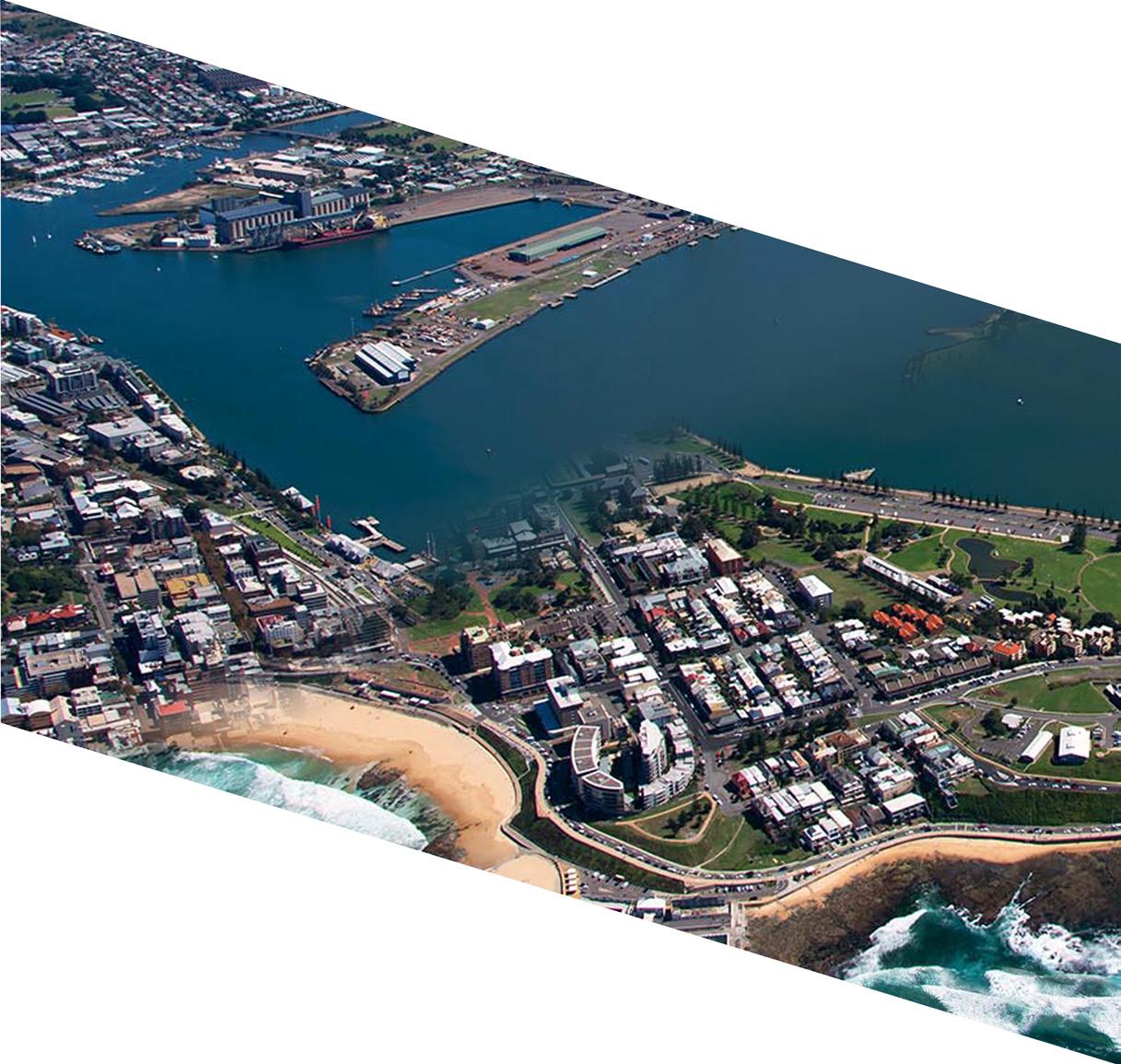








Balancingenvironmentalchallengeswitheconomicdemands #GPCOceania 15 17 TO FEB 2023 Newcastle Australia Newcastle Oceania Host port: Supported by: Gold sponsor: Silver sponsor: Sponsor: Join us & benefit from: • Two day conference • Full documentation in electronic form • Lunch & refreshments throughout • Welcome Reception • Conference Dinner • Port Tour tel: +44 1329 825335 email: congress@greenport.com visit: portstrategy.com/greenport-congress-oceania Early bird available - book now The inaugural Greenport Congress Oceania will bring together environmental managers from port authorities, terminal operators, shipping lines and logistics operato to learn about the latest sustainable developments and environmental practices in the Oceanic region and beyond. Book now and save 15%
DUAL-FUEL TRACTOR TRIALS AT PORTS OF STOCKHOLM
Hydrogen-diesel dual fuel tractors are to be piloted as part of roll-on, roll-off (ro-ro) activities at the Ports of Stockholm, Sweden.
Ports of Stockholm, Volvo Penta and CMB.TECH are collaborating on the initiative as part of Ports of Stockholm’s objective to achieve fossil-free operations by 2030.
In this partnership, CMB.TECH will supply a modified newbuild ro-ro tractor, powered by Volvo Penta’s D8 engines, with a hydrogen system before the machine is then delivered to Ports of Stockholm for the pilot programme to commence in 2023.
Johan Wallén, Chief Commercial Officer at Ports of Stockholm, provides insight into the objectives of the project. “Hydrogen fuel will play a decisive role in the transition to
8 A new hydrogen-powered ro-ro tractor will commence trials at Ports of Stockholm in 2023
fossil-free transport, both on land and at sea. We are therefore incredibly excited about the partnership with Volvo Penta
and CMB.TECH. Together we can put into operation some of the first ro-ro tractors in the world that run on hydrogen fuel.
ABP PURCHASES MORE MOBILE CRANES
The Port of Immingham on the northeast coast of England, and part of Associated British Ports (ABP), is awaiting delivery of three new Liebherr 420 mobile cranes which will go into service handling bulk, scrap, heavy lift, and other cargoes.
This order represents an investment of £9.7 million (US$11.4 million), with an additional £500,000 (US$588,360) being spent on new Nemag grabs. Delivery of the mobiles is
Kalmar for Forth
A total of 12 new low-emission Kalmar straddle carriers have been delivered to Forth Ports’ container ports at Tilbury and Grangemouth in the UK. Seven units are for Tilbury and the remaining five are for Grangemouth. All 12 machines are Kalmar ESC440 models, with each unit offering lowemission engine technology to accommodate the transition to non-fossil fuels, as part of reducing greenhouse gas emissions when operating.
scheduled to take place during the current month.
Each unit has been specified with the Liebherr hybrid system which comprises of a diesel generator which runs on hydrotreated vegetable oil (HVO), but retains an option to switch to fully electric, for optimised performance and fuel economy.
Simon Bird, Regional Director of the Humber Ports, ABP, outlined the rationale for the purchase of the new equipment: “It offers our customers a range of
Electric Virginia
The US-East Coast Port of Virginia and Current Trucking have confirmed the deployment of four MAFI T 230e Electric Yard Tractors during December 2022. The units are capable of offsetting 266 metric tons of carbon per annum, equivalent to more than 300 acres of forest sequestration, according to the two companies, and represents a step towards Virginia’s ongoing aim of being carbon neutral by 2040.
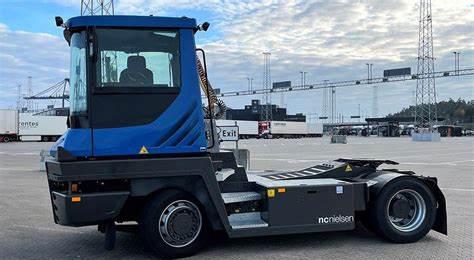
equipment, these being specially optimised for vessels in the postpanamax class. It is also part of our wider strategic investment in future proofing the Humber ports and giving our customers the confidence that the ports remain resilient, and we are giving them what they need in having reliable and efficient cranage.”
The arrival of these cranes represent another step forward in Immingham’s transition to zeroemissions technology, while also improving operational reliability.
Hybrid GMP
Générale de Manutention Portuaire (GMP) in Le Havre, France has confirmed that a repeat order for 12 Kalmar Hybrid Straddle Carriers has been placed during Q3 2022. Delivery is expected by the end of Q3 2023 and increases GMP’s fleet of Kalmar equipment to 50 units, of which 24 are hybrid straddle carriers. A preventative maintenance contract has also been signed, as part of the deal.
The hydrogen investment is in line with Ports of Stockholm’s ambitious environmental goal of running a fossil-free operation from 2030,” he states.
Volvo Penta, a provider of innovative industrial power solutions, confirms a growing interest in hydrogen. “We are at a point where the rapid development in hydrogen powertrains is meeting the exploratory demand in industrial applications as part of the journey to decarbonise.” says David Hamilton, Director Industrial Sales Volvo Penta.
BRIEFS
Pier J Conversion
A multi-year project to convert nine ZPMC diesel-electric 1000 hp rubber-tyred gantry cranes (RTGs) to 100 per cent grid-tied electric at Pier J in the Port of Long Beach (CA) has been completed. Terminal operator, SSA Marine, states that this is the largest deployment of eRTGs in North America and represents 100 per cent of the RTG fleet at the facility. The conversion work was supported by a US$9.7 million grant from the California Energy Commission.
For the latest news and analysis go to www.portstrategy.com DECEMBER 2022 | 15 EQUIPMENT NEWS
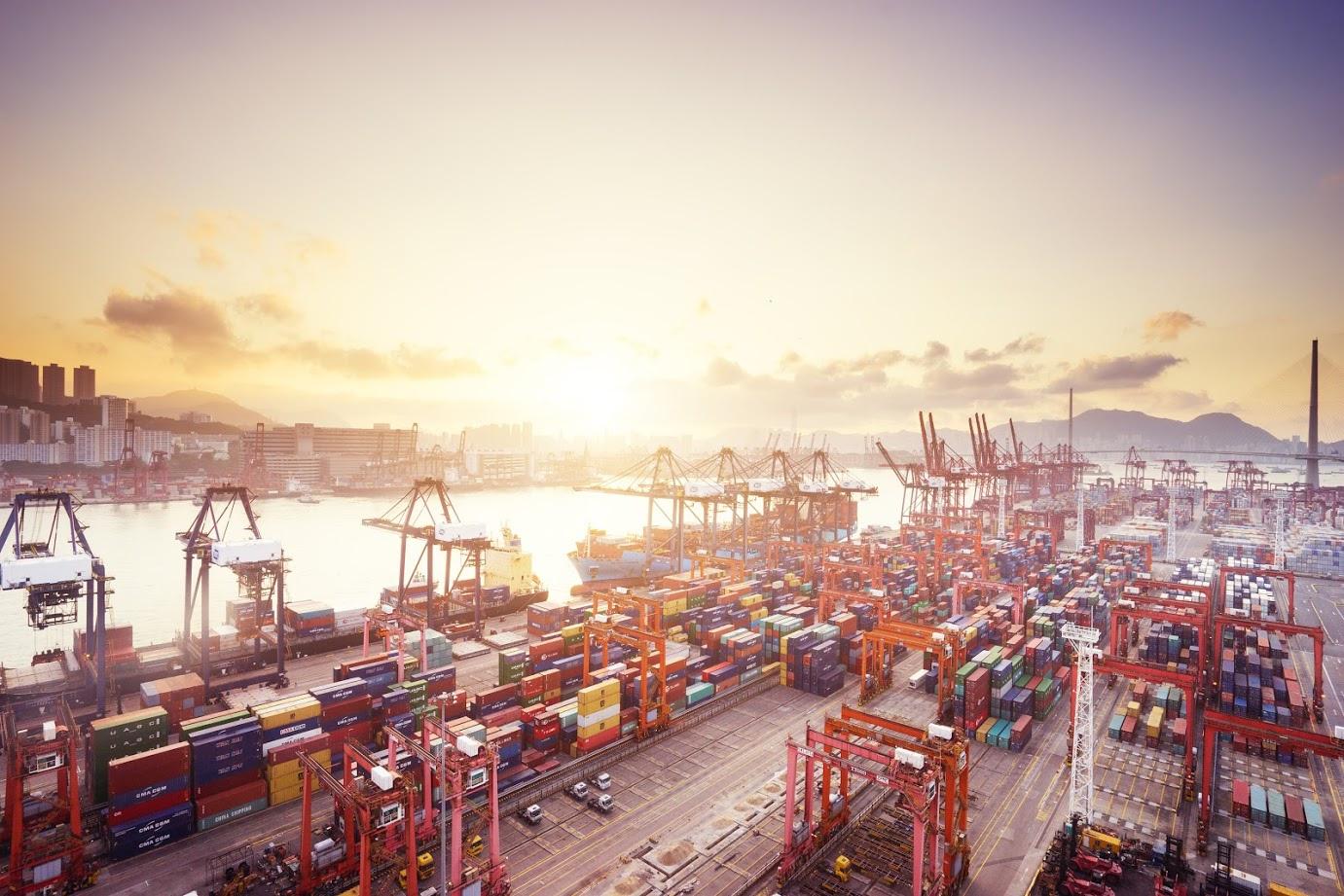
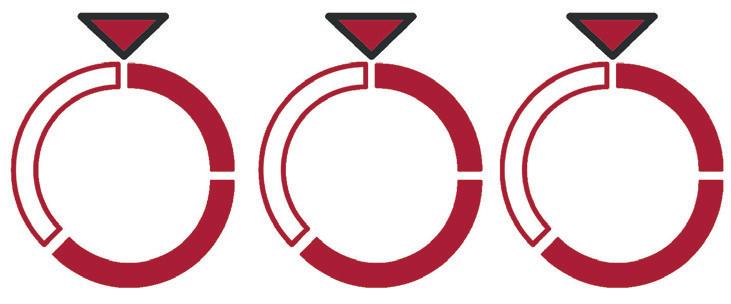
Arrate Landera, Brand Manager t: (+44) 1329 825 335 e: sales@portstrategy.com www.portstrategy.com Contact us today PORTSTRATEGY INSIGHT FOR PORT EXECUTIVES MAGAZINE RECIPIENTS DECISION MAKERS PAGEVIEWS PER MONTH 19,000 72% 42,700 Reach industry professionals with Port Strategy Promote your business to the right audience in the right place at the right time. Engage with our international audience of decision makers and buyers. The Port Strategy multi-media platforms offer our commercial partners a wide range of opportunities for campaign delivery. We provide bespoke marketing packages with quantifiable ROI. Port Strategy’s valued content is dedicated to the international ports and terminals business and is delivered through multiple channels.
STI, SAN ANTONIO, PROCEEDS WITH MAJOR EQUIPMENT UPGRADE
San Antonio Terminal Internacional (STI), located at the Port of San Antonio in central Chile, is undertaking a large-scale equipment upgrade programme.
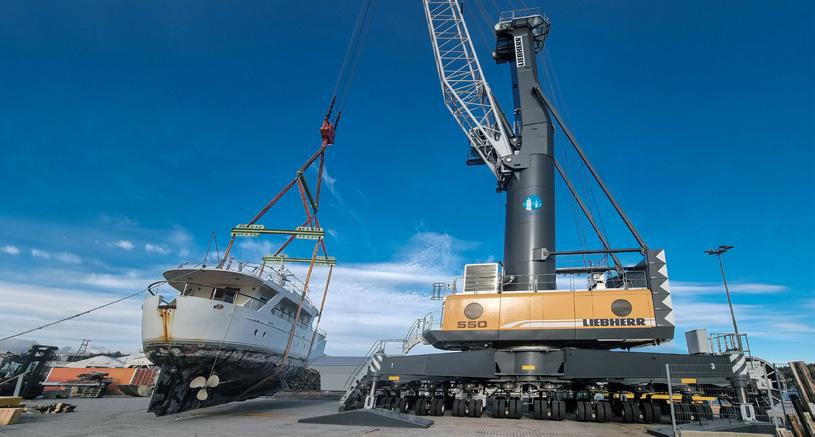
The terminal operating company, a joint venture between SAAM Puertos S.A and SSA Marine (SSA), has commenced taking delivery of 19 Konecranes Liftace reachstackers and one Konecranes Liftace empty container handler, while also announcing a forthcoming delivery of two new Super Post Panamax Ship-To-Shore (STS) cranes and two electric RubberTyred Gantries (RTGs).
The first delivery of six reachstacker units was completed in July 2022, the second is expected before the end of 2022, with a third batch scheduled for early 2023.
Each of the 19 reachstackers is a Konecranes Liftace 4532 TCE 5, featuring a strong box-type frame and a wide drive axle with a long wheelbase, with the empty container handler a Konecranes Liftace 6/7 ECC 9 unit that can lift up to nine tons.
All hoists are equipped with a HLL (Hydraulic Long-Life) fine
filtration system, which extends the oil change interval up to 12,000 hours, saving time and costs due to fewer oil changes.
Konecranes confirms that an AR (augmented reality) 3D sensor and a 2D camera with on-screen alerts provide wider visibility on all machines.
With the additional units, STI will be operating eight STS and eight RTG cranes. All equipment is currently en route from Changxing Island, China, with operations expected to commence before the end of January 2023.
The new machinery is expected
to reach Chile by the end of December 2022 and slated to become operational by the end of January 2023, taking the terminal’s annual capacity to 1.6 million TEU.
The new cranes are part of commitments agreed by STI with Empresa Portuaria de San Antonio to extend the terminal’s concession to 2030 and represent ongoing investment upgrades totalling US$66 million.
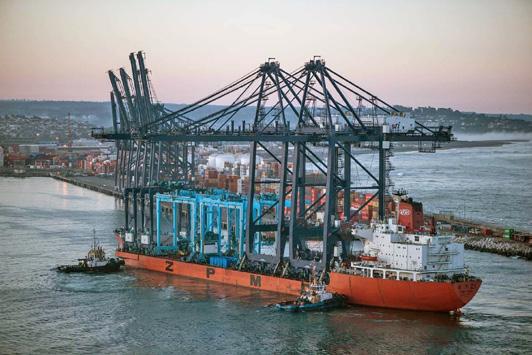
BRIEFS
Poland Production Gain
Cargo handling equipment specialist, Kalmar, appears set to commence the series production of electric reachstackers at Stargard in Poland. This is already the company’s established operations production centre and where it switched the manufacture of forklift trucks approximately two years ago from Sweden in order to gain more cost competitive production. Poland is already one of Kalmar’s largest production locations, along with the US, China, Finland, Malaysia, and Sweden.
More GCT Konecranes
GCT Canada has confirmed it has placed an order for an additional 10 rubbertyred gantries (RTGS) from Konecranes. The new equipment is for the GCT Deltaport container terminal in Vancouver (BC) and will be added to the existing fleet of 12 Konecranes RTGs already in use. Delivery of the new equipment, which will all be equipped with Tier4f diesel engines and Konecranes’ Diesel Fuel Saver technology, is expected in Q1 2024.
Hueneme
Addition
8 Liebherr has delivered a new LHM550 mobile crane to the Port of Arundel, Norway. The four-rope version of the new unit provides flexible applications for cargo and material lifting. With a lifting capacity of up to 144 tonnes the port is able to handle larger project and special cargo. For increased efficiency in handling bulk cargo, a suitable grab that is coupled with Liebherr’s SmartGrip technology optimises the filling rate of the grab in a self-learning manner. In this way, SmartGrip learns, after just a few lifting cycles, how to optimise capacity utilisation of the grab.
The US West Coast Port of Hueneme has received a new electric-hybrid mobile crane. The arrival is part of US$7 million of investment being undertaken by terminal operator, Ports America, and will replace older equipment that will be decommissioned as part of the port’s planned transition to zero-emissions technology. Ports America handles Chiquita and Del Monte’s weekly fresh fruit vessel arrivals to the port with three mobile harbour cranes.
For the latest news and analysis go to www.portstrategy.com DECEMBER 2022 | 17 EQUIPMENT NEWS
8 STI San Antonio is investing in new quay and landside cranes as well as mobile handling equipment to raise annual capacity to 1.6 million TEU
BARRY PARKER
As a writer on maritime business, I am frequently asked, “What are you writing about these days?” For the past few years, my answer has always been “digitalisation and decarbonisation”, or what I call “D and D” (not that other one –demurrage and detention, which others have covered very well).

While my D and D opining has been focused on the vessel side, it’s been very clear that forward thinkers and industry influencers are indeed talking about the central role of ports. This is a recognition that their role in the “data lake” (some would call it a “data stack”) mirrors the place of ports in real life - they are central to the movement of cargo, quite literally. This was highlighted recently at the SHIPPINGInsight2022 conference, held at a venue in suburban Connecticut- about an hour, outside of New York.
The conference keynote, the top executive at American Bureau of Shipping (ABS), provided an insightful view, from

PIVOTAL ROLE FOR PORTS IN MAKING GREEN CORRIDORS WORK

a high level, of how the shape of maritime commerce will evolve in the coming years. In his remarks at the event, he put the spotlight on governmental entities - which, certainly in the case of landlord structures, or direct operators, are central to the port business. The speaker told the audience (composed of shipowners and service providers, mainly), “… we need regulatory clarity and consistency. It is not just about the tank-to-wake vs well-to-wake issue. It is also very much about
THEANALYST
DE LANGEN
the port to ship issue since port inefficiency will directly impact ship efficiency in terms of CO2 emissions…”
In the introduction to a new ABS publication on “Green Corridors” (which will be the subject of a future article in Port Strategy), the Class Society writes: “The creation of green shipping corridors, defined as a shipping route between two major port hubs (including intermediary stopovers) on which the technological, economic and regulatory feasibility of the operation of zero-emission ships are catalysed through
public and private actions, offers the opportunity to accelerate progress in tackling the challenges of decarbonising shipping.” The creation of these corridors (also the subject of considerable high level attention at the COP 27 meetings in Egypt) requires a multi-pronged approach, but the key take-away for readers here is an obvious one- with a port on each end of the pathway, the ports are integral to the process (and will need to be fully linked into the relevant supply chains). With the early corridors providing the building blocks for more extensive networks, the port entities will be integral to the journey of shipping (sometimes called a “hard to abate” industry) toward a decarbonised and digitalised commercial future.
Link to the ABS publication is here: https://ww2.eagle.org/en/ publication-flip/green-shippingcorridors-leveraging-synergies. html
Leading container line Maersk is clearly an early mover when it comes to transitioning to clean fuels. It has decided to opt mainly for green methanol and now has 19 ships on order with dual fuel engines capable of sailing on methanol. In addition, Maersk is focusing on securing the supply of green methanol, and currently has seven partnerships with clean methanol providers in various continents.
However, even with these seven, Maersk is still short on methanol fuel supply; the agreements will generate over one million tons of methanol, but Maersk’s demand is around the six-million ton mark. Thus, Maersk is taking further steps,
METHANOL -
ASSET FOR MAERSK AND PARTNER PORTS?
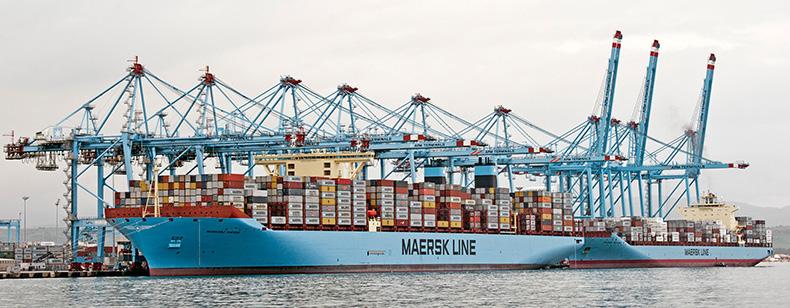
levels as Maersk. In that sense, it is relevant to note that Maersk’s potential partnership in Spain would involve massive investments in wind and solar energy, which may benefit substantially from EU funding as part of the EU’s greening policies (fit for 55).
including exploring a partnership in Spain, which would be the largest of its kind, and may be able to generate two to three million tons of methanol.
The huge efforts of Maersk demonstrate that unlike the current fuels, where there are various established suppliers, for methanol there is no open market. Thus, Maersk’s choice to
be an early mover may pay off when methanol becomes the go-to clean shipping fuel. In that scenario, competing companies may face an uphill battle to secure the supply of methanol, and may not be able to source methanol at the same price
In the same way that Maersk may aspire to gaining a competitive edge as an early mover, Spanish ports may aspire to benefit from moving early, by strengthening the ties with Maersk through expanding their role as bunkering ports. Thus, the Spanish ports may need to remind themselves: if you want to be an early mover, you need to move fast!
18 | DECEMBER 2022 For the
to www.portstrategy.com
latest news and analysis go
THENEWYORKER
8 Maersk is exploring a partnership in Spain which could deliver green Methanol on a large scale
Ports are key to the advance of the green corridor concept
COMPETITIVE
8
PETER
BEN HACKETT
We are entering a new world with little clarity of the future as we face either a return to the old ways or live in a state of perma-crisis.
During the height of the Pandemic, it was popular to discuss the shift from “normal”, i.e., pre-2020 to the “new normal” from 2022 on. There was much hype about the changes that were taking place in the way we work, how we shop and spend.
By late 2018, according to UNCTAD, the global economy was slowing down after peaking in mid=2017. Partly to blame was the tariff war instigated by the Trump Administration, tariff policies and the tensions in stability of international trade that this caused. According to the World Trade Organisation, global trade grew by just 3.8 percent in 2018, down from 5.4 percent in 2017.
Leading up to 2021 ship values and charter rates were low and ports also faced significant regional competition due to overcapacity. At the end of 2019
WHAT COMES AFTER NORMAL AND NEW NORMAL?
Moody’s classified Maersk as a lower to medium term investment risk with the rest of the liner industry falling into either the “non-investment grade speculative to highly speculative” investments categories.
Profitability was not a factor and the orderbook for ships was depressed. This was the normal pattern in the economics of
THESTRATEGIST
MIKE MUNDY


The India-headquartered Adani Group, which includes Adani Ports & SEZ, is reportedly engaged in raising US$10 billion in lower cost green bonds. At the same it has launched equity fund raising plans as part of what it calls its “systemic capital management programme,” which has been in place since 2019 and under which QIA and Abu Dhabibased International Holding Co have previously invested in Adani.
It is interesting to speculate where this search for further investment in its group companies will lead – an initiative which it says is quite separate from its debt raising plans. Discussions are being held in conjunction with sovereign wealth funds including
8 A return to the old normal or the state of perma-crisis with a lack of certainty, profitability and stability?
shipping, short bursts of optimism followed by longer periods of pessimism.
Then along came the COVID-19 pandemic and the new normal behaviour patterns and massive inflow of cash to boost the economies that had come to a
virtual standstill. The new normal was born and consumers, flush with unexpected cash, used to working from home, began to spend which resulted in a massive trade boom resulting in port congestion, supply chain distribution failures and, unexpectedly from Quarter 2 2021, massive profitability of containership carriers and vessel owners. This continued into the third quarter 2022 but as world trade begins to tank as a result of inflation, high interest rates and expectations of a global recession, excessively high freight rates have collapsed from their meteoric peaks.
We are now facing the dilemma of a return to the old normal whose only bright side is that the logistics supply chain will finally recover, or perhaps the state of perma-crisis with a lack of certainty, profitability and stability. Either way, nothing to be cheerful about.
PORT OF SINGAPORE TO TAKE A STAKE IN ADANI PORTS?

Singapore’s GIC Pte and Temasek Holdings Pte, as well as a range of other parties such as the Abu Dhabi Investment Authority, the Qatar Investment Authority and pension funds like the Canada Plan Investment Board.
The big question is, however, will this search for funding lead to investment in Adani’s ports division by a global terminal operator? As previously noted, Adani has said publicly it is willing to consider selling stakes in its diverse companies and certainly as far as Adani Ports & SEZ is concerned there may well be a number of suitors, not the least of which will be operators with working associations with their respective wealth funds and investment authorities – for
instance, the Port of Singapore with Temasek, Abu Dhabi Ports with the Abu Dhabi Investment Authority and Q Terminals with the Qatar Investment Authority.
It may indeed be that by the time this commentary hits the streets there will be an announcement in this respect, with the Port of Singapore identified by informed sources as closing in on securing a stake in Adani’s ports division with this investment reportedly to be used for expansion and acquisition.
The Adani Group has recently come in for some criticism regarding its debt position, with an August CreditSights report in particular identifying the company as over-leveraged. Indeed, even after adjustments,
made in September, to its original report following engagement with Adani Group finance and other executives, CreditSights continued to express concerns about the Adani group’s overall debt levels. For its part, the Adani Group has made clear that it considers its debt position, in each of the sectors it is active in, is line with standard industry metrics.
The move to raise US$10 billion in debt takes place following a period of massive expansion in the Adani Group, with some big cash transactions, and against a background of interest rate hikes – for example the 2029 bond issued by Adani Ports now yields 9.4 per cent, more than double the rate at issue.
For the latest news and analysis go to www.portstrategy.com DECEMBER 2022 | 19
THEECONOMIST
INVESTMENT RISKS BUILD
Political risk is much more to the fore nowadays and this promises to be the case for the short-term at least. Andrew Penfold charts the risk environment and considers the implications for port investors
A very clever man once said, ‘Prediction is very difficult, especially if it’s about the future!’. A quick look at how the port market has developed in the past three years can only confirm Niels Bohr’s profound words.
Long term planning is always subject to ‘Black Swan’ events and – indeed – we can see that these are what really move the market. How then does an investor looking at major commitments (often with a ten year-plus returns horizon) cope with all of this? A shipowner always has the possibility to sail away his assets if the unexpected is realised – not so the terminal investor.
As we begin to emerge from the COVID-19 crisis we now find ourselves in the midst of political uncertainties (and risks) far higher than seemed likely in the comfortable days before the pandemic. However, demand continues its, somewhat patchy, expansion and new investment is essential. In the short term, a limited consensus seems to have emerged with the major international bodies – the IMF, OECD, etc. – confirming a slowdown in 2023 but a general return to a more restricted expansionary trend in later years. However, for investors this really isn’t good enough.
TYPES OF RISK
There are some issues facing port and terminal investors that lie way outside their ability to influence. Here, the investor can only take a view of how things will develop and – where possible – take the required mitigating steps (risk spreading, insurance, etc.). Other issues are much more closely related to initial investment decisions. These risks are summarised in Table 1.
The port and terminal business faces greater uncertainties now than at any time since the bulk and container handling revolutions started in the late 1970s. These are systemic risks that could dramatically impact the outlook for port demand, profitability and investment in the next ten years. It is worth a close look at some of these.
EXTERNAL FACTORS
9 Globalisation and protectionism: containerisation has ridden the wave of globalisation – indeed, the container system has been the facilitator of this more than any other factor, allowing freight costs to fall to negligible levels in relation to the value of the commodity for most manufactured goods. Supply-chain uncertainty and political risks are changing this view. Protectionism is becoming an important driver. Deepsea container flows are directly in the firing line of this trend.
9 Financial instability: the recovery since the Financial Crisis and the subsequent Covid period has been built on massive increases in debt. Quantitative Easing has disguised a fundamental imbalance in the world economy. Inflation and higher interest rates will be the new normal.
9 Structural demand change: consumption in the developed economies has reached very high levels and there are concerns about the future scope for per capita increases. This has seen the link between GDP and trade decline. The scope for other economies to pick this up is unclear.
9 Near-sourcing: recently, pressures have increased to
repatriate production to the major OECD economies. This is a compound effect from greater protectionism, post-COVID-19 supply chain reassessments and political risks. The degree to which this a simple case of China substitution or a deeper trend is unclear. The impact on containerisation could be profound.
9 Technological change: there are two clear issues here: the blockchain process (digitisation) and 3D printing. These are nascent technologies whose development is uncertain. Blockchain has the potential to place the trade ecosystem under a single data source – with this offering major potential benefits for goods flows. ‘3D Printing’ is shorthand for a whole new set of technologies that could well result in a dramatic modernisation of the logistics chain. The potential for order-specific, bespoke production of consumer goods and industrial components will see production move nearer to consumption with price alone no longer being the key determinant of sales potential.
9 Environmental pressures: for many years international shipping and terminal development largely escaped from environmental pressures. This is no longer the case. In the shipping sector emissions are now the subject of direct regulatory pressures. The port and terminal sector is much more visible and has been under pressure for some years. These pressures will intensify further and minimising a project’s environmental footprint will be central to development – this can only mean higher costs.
The port/terminal developer has no direct control over any of these risks.
Also, the invasion of the Ukraine has reintroduced risks not seen in fifty years. The risk of an uncontained war will take all bets off the table.
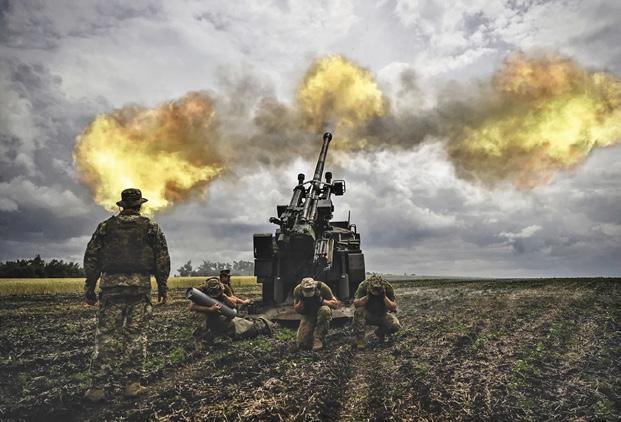
INTRINSIC FACTORS
As if these uncertainties were not enough, the port investor has a whole set of specific issues that are directly related to the sector itself. These include:
9 Shipping over-capacity and instability: container shipping
8 Russia’s attack on Ukraine highlights the new era of increased political and economic instability
PORT INVESTMENT 20 | DECEMBER 2022 For the latest news and analysis go to www.portstrategy.com
Structural
Technological
Unrealistic
Concession
is a very difficult market. Recent returns will see overordering and a new downturn. The rush to larger vessels has also had far-reaching effects. The impact on the terminal sector is complex – demand has grown but the needs of the lines have shifted. The pressure is on for much longer and deeper quays to berth these vessels and a massive increase in yard size and productivity to handle these much larger consignments. With a collapse in freight rates customers will be under renewed financial pressures. This mismanagement of the shipping sector will impact terminal investment.
9 Alliance instability: investing in a new terminal is a longterm project. Renewed instability in the shipping sector leads to uncertainty in demand forecasting. As growth slows, the risks here become much greater. When securing financing for expansion or greenfield terminals, this is an increasing focus of attention.
9 Shipping line terminal investment: this has been an accelerating trend. It’s always the case that a line will seek to control its own stevedoring but how this plays out when alliances shift has been very problematic. Lines under financial pressure will face difficulties here.
9 Larger vessels and cascading: the pressure to deploy large vessels on secondary trades (‘cascading’) has been driven not by a careful and rational consideration of optimum vessel sizes and service structures on these trades but by the need to find some employment for otherwise redundant tonnage. Providing required port investment is already problematic.
9 Unrealistic expectations and overcapacity: assumptions that recent growth rates will continue are highly risky. Resulting expansion has been encouraged by Port Authorities anxious to maintain market shares. This places great pressures on terminal operators who may see their utilisation rates – and, therefore, unit revenues – contract. This is a high-risk issue in some places.
9 New company involvement: the port sector has been driven by specialist shipping companies and stevedoring concerns. Infrastructure funds have taken a central role of late and driven up prices. The degree to which some of these investments can be justified is unclear. Specific
issues such as investment driven by the Chinese ‘Belt and Road Initiative’ provide further uncertainties.
9 Tightening regulatory framework: the room for development has been increasingly curtailed by government involvement, either at the policy level, for example, the continuing push for a ‘European Seaport Policy’ or requirements to invest in supporting infrastructure such as road and rail links. This means much higher costs of development.
POSSIBLE SCENARIOS
Port investment is a complex process. The pressures and risks associated with development are multiplying rapidly. Very careful navigation of these issues is increasingly central to future profitability. At present the following long-term scenarios may cover the risks:
5 Returned Stability. It is possible that the pattern of global trade recorded since the Financial Crisis and following the recovery from the Covid pandemic is largely regained. This would generate fairly stable growth on the main arterial trades – with this continuing to be funded by manufactured goods shipped from China and (increasingly) other lowcost Asian producers. However, the overall level of trade growth will decline under these conditions. Nevertheless, this generates the highest growth rates for port demand.
5 Increased Protectionism. Protectionist trends have become a much more significant issue following the economic upheavals of the Covid period and global political uncertainties. As these forces gather further strength this will impact on the level of deepsea container flows –especially from China to the US and Europe. This will see continued demand growth but at a slower pace.
5 Cyclical Downturn & Recovery. It’s clear that we are open to the risk of a more prolonged global economic slowdown – especially as geopolitical tensions worsen. Forecasting such an event is inherently problematic, but the impact on the container sector of another crisis would be dramatic. This scenario would significantly upset the port and shipping markets. This case projects a much steeper short-term downturn followed by a more rapid economic recovery.
I think we can say that Mr Bohr was quite correct, and Mr Putin has confirmed this.
PORT INVESTMENT
Table 1: Risk Categories – Some External and Intrinsic Factors For the latest news and analysis go to www.portstrategy.com DECEMBER 2022 | 21
8
External Factors – zero/very limited control
protectionism
Globalisation and
Pace of demand growth
Financial instability Short term volatility in demand
demand change
Maturation of the market will moderate container growth Near-sourcing
Reduced overall significance for deepsea operations
change
Increased supply chain integration - higher investment
Environmental pressures Higher capital and operating costs
limited
Intrinsic Factors -
direct influence
Shipping over-capacity Pricing pressures on stevedoring
Alliance instability Short-term shifting in demand
Shipping line terminal investment Increased competition for third party operators
Larger vessels & cascading Large scale investment to handle larger tonnage
expectations
over-capacity
company
and
Danger of excess capacity driven by Port Authorities Automation Increased costs and uncertain benefits New
involvement New players in the market
renewal/extension
An area of increasing concern and difficulty
Tightening regulatory framework Government policies and increased access investments
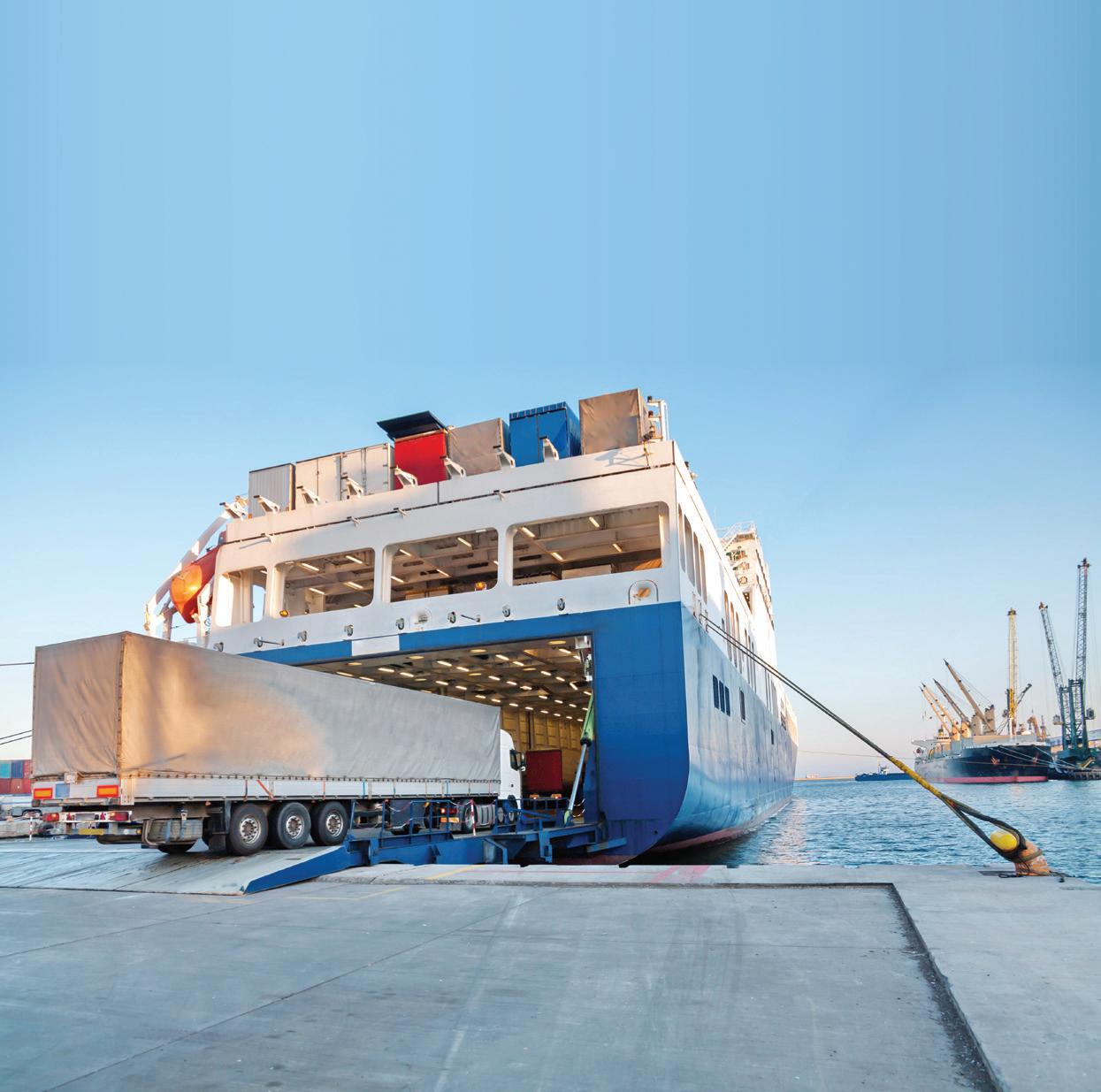






Media partners: GREENPORT INSIGHT FOR PORT EXECUTIVES MOTORSHIP MARINE TECHNOLOGY THE Supporters: visit: coastlink.co.uk contact: +44 1329 825335 email: info@coastlink.co.uk #Coastlink Hosted by: Growing Sustainable Supply Chains: Short Sea Shipping & Intermodal Networks Provisional Programme Royal Liver Building, Liverpool, UK A neutral pan-European network dedicated to the promotion of short sea and feeder shipping and the intermodal transport networks that support the sector. Chairman: Nick Lambert, Co-Founder & Director, NLA International Ltd
1329
DAY ONE – Wednesday 3th May 2023
08:30 Coffee & Registration
09:00 Chairman’s Welcome
Nick Lambert, Co-Founder and Director, NLA International Ltd
SESSION 1: MARKET SECTOR OVERVIEW - THE NEW NORMAL IN AN ADAPTING MARKET
Considering Trends, Market Forces and emerging Opportunities for Short Sea Feeder Services
09:10 Port’s Welcome Address
Claudio Veritiero, CEO, Peel Ports Group
09:25 Gold Sponsor’s Address
09:35 Keynote Presentation
Robert Clegg, Short Sea Director United Kingdom, Containerships CMA CGM GmbH
09:50 Speaker To be Announced
10:05 Presentation title - to be confirmed
Koert Luitwieiler, CEO, BG Freightline*
10:20 Q&A
10:40 Coffee & Networking
11:15 PANEL DISCUSSION: Post-Brexit & Post-Pandemic: Are we where we need to be?
Panel Moderator: Richard Ballantyne OBE, Chief Executive, British Ports Association Panellists include: Doug Bannister, CEO, Port of Dover Howard, Knott, IEA Logistics Consultant, Irish Exporters Association Speaker To be Confirmed, Port of Bilbao
12:30 - Lunch & Networking
14:00
SESSION
2: HOW TO PROMOTE GROWTH AND DELIVER RESILIENT END TO END SUPPLY CHAINS
A look at the changing landscape in end-to-end intermodal networks & the just in time supply chain.
14:00 Opening Address
Logistics UK Logistics UK will highlight the opportunities in the supply chain for innovation and modal shift to benefit the environment and consumers as well as operators throughout the supply chain.
14:15 What mode of transport uses Ports?
Stephen Carr, Group Commercial Director, Peel Ports Group
We explore why the true answer to that question defines why both industry and consumers need to think differently about the role and the functions of modern ports.
14:30 Practical examples of building resilience into a supply chain using intermodal services
Geoff Lippitt, Chief Commercial Officer, PD Ports
14:45 Port of Antwerp-Bruges – providing total intermodal connectivity solutions
Justin Atkin, UK & Ireland Representative, Port of Antwerp-Bruges
With excellent connections to the hinterland by estuary and inland barge, rail, road, and pipeline, discover how the Port of Antwerp-Bruges provides totally integrated transportation solutions, helping shippers ‘green’ their supply chains.
information
Book Online at coastlink.co.uk/buy or fax form to +44
550192 For further
please call +44 1329 825335 or email info@coastlink.co.uk
Book Online at coastlink.co.uk/buy or fax form to +44 1329 550192
15:00 Q&A
15:20 Coffee & Networking
15:50 PANEL DISCUSSION: Freeports: Driving change for coastal shipping and the supply chain? A discussion on the impacts and benefits of Freeports. How will supply chains adjust? Xx
Panel Moderator: Richard Ballantyne OBE, Chief Executive, British Ports Association
Panellists include:
John Lucy, Freeport Director, Liverpool City Region Combined Authority Nolan Gray, Freeport Director, Tees Valley Combined Authority
17:15 Conference Day 1 Wrap-Up – Conference Chairman
17:30 Conference Close
17:30 Evening Drinks Reception at the Royal Liver Building
18:45 Conference Dinner at the Royal Liver Building
DAY TWO – Thursday 4th May 2023
08:45 Arrival: Coffee
SESSION
3: SUSTAINABILITY & THE ENERGY TRANSITION – A ROUTE TO SHIPPING FREIGHT SUSTAINABLY
Sponsored by Peel Ports - Liverpool
The journey and challenges for ports, shipping & logistics in achieving net zero
09:10 Chairman’s Opening & Summary of Day 1
09:15 Keynote Presentation
David Browne, General Manager, MAERSK
09:30 A Green Port’s Journey to Net Zero
Tanya Ferry, Green Port Consultant, Royal Haskoning DHV Learn how Royal HaskoningDHV is helping the world’s ports embrace digital innovation, decarbonisation, and new-found resilience. And discover the challenges, savings, and operational benefits to be found on the journey to Net Zero.
09:45 Port of Amsterdam – At the forefront of the transition
Mark Hoolwerf, Deputy Director, Port of Amsterdam International The port of Amsterdam is a global energy hub, meaning that it stands for a significant decarbonisation challenge. This presentation will focus on how the Port of Amsterdam approaches the energy transition, with a focus on its overall strategy and recent initiatives and developments. This will include subjects such as the role of hydrogen, clean shipping, and the collaboration with different parts of the value chain.
10:00 Lessons learned with shore power
Jacob Bjarkam Head of Shore Power, PowerCon Shore power is expected to be scaled tremendously. PowerCon will provide key insights and lessons learned on how to best to implement this technology successfully, by sharing hands-on experience from past projects plus the latest news and innovation.
10:15 Q&A
10:40 Coffee & Networking
11:20
PANEL DISCUSSION – Driving Efficiency through Data & Port Collaboration
Improving supply chain efficiency through data, collaboration, and digitalisation
Panel Moderator: Tim Morris, CEO, UK Major Ports Group
Panellists include:
Richard Willis, Technical Director - Port Operations & Technology, Royal HaskoningDHV
Eleni Bougioukou, Innovation Manager for Energy & Sustainability, Port of Tyne
12:35 Conference Wrap up by Conference Chairman
12:45 Lunch & Networking
14:15 – 16:30 Technical Visit & Working Group
Delegates can enjoy a tour of the Port of Liverpool, hosted by Peel Ports Group, or take the opportunity to collaborate in one of the afternoon working groups.

further information please
For
call +44 1329 825335 or email info@coastlink.co.uk
*invited
Further information call +44 1329 825335 or email info@coastlink.co.uk. Book online at coastlink.co.uk/buy
Booking Online coastlink.co.uk/buy or complete and fax the booking form below to +44 1329 550192. On receipt of your registration, you will be sent confirmation of your delegate place

Contact Us For further information on exhibiting, sponsoring, or attending the conference, contact the Events team on: +44 1329 825335 or info@coastlink.co.uk

BOOKING FORM
BOOK ONLINE OR COMPLETE THIS FORM AND FAX TO +44 1329 550192 (Please copy this form for additional delegates)
Please tick all that apply :
Please register me for the Coastlink Conference 2023. I will attend the following: Conference dinner (3rd May 2023) Technical Visit (4th May 2023)
Members of supporting associations will receive a discount
I am a member of
HOW TO PAY *UK registered companies will be charged the standard rate UK VAT
Bank Transfer: Mercator Media Ltd, HSBC Bank plc, GBPaccount, Sort Code: 40-21-03, Account number: 91894919 SWIFT/BIC8: HBUKGB4B BRANCH BIC11: HBUKGB4131C, IBAN: GB61 HBUK 4021 0391 8949 19
Bank Transfer: Mercator Media Ltd, HSBC Bank plc, EURaccount, Sort Code: 40-12-76, Account number: 70235247 SWIFT/BIC8: HBUKGB4B BRANCH BIC11: HBUKGB41CM1 IBAN: GB35HBUK40127670235247
Prepayment is required in full for entry to the conference. Full terms & conditions are available at mercatormedia.com/our-business/terms-and-conditions
Please fax form. Do not send by email as we cannot guarantee the security of card information.
Family Name
Name
Title
Fax Email
Address
–
TODAY!
terms
Signature Credit Card Billing Address Security Code Name on Card Expiry Date Card Number Please charge my card (delete as appropriate) Mastercard/Visa/Amex I have paid by bank transfer Credit/Debit Card: Complete the form with your card details (3 Numbers on the reverse/ AMEX 4 numbers on front) Venue Royal Liver Building, Pier Head, Liverpool L3 1HU,
Visit coastlink.co.uk
Fee
Package
Cost per delegate
Cost per delegate Fee Includes
Conference attendance including lunch & refreshments
Electronic documentation
Package)
download (Premium Package)
First
Title Mr/Mrs/Ms/Dr/Other Company Job
Country Telephone
Signature Company
Company VAT No. SPACE AT THE CONFERENCE IS LIMITED
RESERVE YOUR PLACE
Book online at coastlink.co.uk/buy or fax booking form to +44 1329 550192 Registered in England. Company Number 2427909. Mercator Media Ltd reserve the right to alter the timing, content or speeches of this conference at any time. Full
& conditions are available at mercatormedia.com/our-business/terms-and-conditions
UK
Conference
Premium
£625GBP/ €750euro
Standard Package £590GBP/ €710euro
•
•
• Technical Visit 4 May 2023 • Conference Dinner 3 May 2023 (Premium
• Presentation
THE ROAD TO NET ZERO
The challenges and barriers along the road to Net Zero, as well as new business opportunities, were discussed in-depth at a recent Coastlink webinar. Felicity Landon reports
“Despite what’s happening in the global economy with its trials and tribulations, there can be no bigger issue for us to face than the impact we have on the environment:” these were the opening words of Stephen Carr, Commercial Director, Peel Ports, UK as he delivered his presentation to the Coastlink webinar: The Road to Net Zero.
As evidenced by all the speakers, the road to Net Zero is far from smooth – it’s littered with contradictions, uncertainties, risks and frustrations – but Net Zero also brings opportunities for ports, shipping and the wider supply chain.
As Carr noted in relation to the fuels of the future for vessels and the mainstream grid supply: “It is hard for any port operator to invest a significant amount of capital when we don’t know which model we will be going forward with. Who takes the commercial risk when the future is so uncertain?”
And then there are the impacts on cargo flows through ports and into the hinterland; Alexandra Herdman, Public Policy Manager for Logistics UK, pointed out that while carbon-related cargo moved by rail (coal, etc), is steadily reducing, other cargoes are not rapidly occupying the resulting available capacity; hence rail freight levels have stayed relatively stagnant overall with a 10 per cent modal share.
When the UK government set its target for the country to be Net Zero by 2050, about 40 per cent of cargo moving through UK ports was carbon-related, said Carr. “That gave us 30 years for half of our marketplace to disappear. As we exit 2022, with 27 years left, it has fallen to 37 per cent. So, the good news is that a little bit of progress has been made – but the bad news is there is quite a way to go.”
THREE CATEGORIES
Carr considered the role of ports in achieving Net Zero and broke it down into three categories: how they reduce their own emissions; how they support Net Zero power generation; and how they enable cargo owners and movers to have more carbon-efficient supply chains.
Peel Ports has set a 2040 Net Zero goal as an operator –“an informed choice” after reviewing technology developments and its equipment replacement programme. The key point, however, said Carr, is that on the journey to Net Zero, “there is an awful lot we can do far quicker” – for example, converting diesel equipment from Marine Gas Oil (MGO) fuel, as undertaken at the Port of Liverpool where emissions are expected to be 20-30 per cent lower this year.
Meanwhile, different factors can support low-carbon supply chains – for example, Peel Ports restarted train services out of its container terminal a few years ago.

“For a long time, we have viewed shortsea shipping as an option and route to reduce total emissions from a total journey, but a final element is also to enable ships to refuel with lower or zero carbon fuels.”
Focusing on how ports can support Net Zero power generation, Carr said: “Ports need to really think about their role in supporting the production of Net Zero power. Have you got suitable road access – for example, as wind turbines get bigger, the junctions and roads in and out of the port estate need to be wider. Have you got the marine capability for deeper drafted or wider vessels to be able to support some of the new and emerging power generation areas?”
COASTLINK WEBINAR REVIEW 22 | DECEMBER 2022 For the latest news and analysis go to www.portstrategy.com
8 The Peel Portsowned Port of Liverpool has added major new rail container handling capacity and benefitted from linked track upgrades as part of its push for Net Zero
For example, a hydrogen cracker recently imported through the Port of Liverpool weighed in at about 100 tonnes. “This means having specialist lifting and handling capability, maybe different to what ports are used to. There are some very real challenges; the Highways England team believe this was the single largest piece of project cargo to have ever gone on to the UK road network. It straddled two carriageways of a motorway. While this will be an extreme example of what we need to deal with, this demonstrates some of the challenges that ports need to start to understand if we are supporting the generation of Net Zero power,” said Carr.
When it comes to refuelling vessels, one size doesn’t fit all, he noted. It is easier to commercialise a new solution for roro, where a ferry makes multiple calls a day, as opposed to bulk berths, where the size and shape of vessels varies on a day-to-day basis.
“The second issue is, who takes the commercial risk? What happened in the biomass market ten years ago was the Government provided the power generation grants, long-term commitments on price, and that cascaded down the supply chain so people could invest in the infrastructure needed.”
TAILORED APPROACH
Tanya Ferry, Green Port Consultant at Royal HaskoningDHV, also emphasised that all ports are unique. “Options to reduce emissions need tailoring every time. Ports are often complex with multiple players, with site users including the port/ terminal operator, shipping, the logistics chain, etc. In its favour, she pointed out, it is quite a competitive sector, and we are starting to see quite a competitive nature around emissions reduction and a green corridor approach in ports.”
As for where to begin: “Often the question is, where are we starting from? The baseline is key, and benchmarking is the starting point.”
Ports must identify what can and cannot be controlled and any influence they can have, said Ferry. The key is identifying opportunities and building a long-term strategy.
For most ports, the largest source of their own emissions is likely to be diesel-powered plant in cargo handling and storage areas, she said. Reductions can be linked to both technology and staff actions: “Streamlining operational

However, the vast majority of emissions in ports are derived from visiting vessels, said Ferry. Digital tools can help here, by optimising port call movements and performance. This is not just about ‘being green’ but definitely about ‘being smarter’, she insisted, and data is going to be very important in the future. “There is technology out there for monitoring air quality and other emissions in real time. Things like AIS exist and can be a strong tool. A lot of work is being done around data collection and digital twin work has been really important in helping ports see what they can achieve going forward.”
RAIL AND WATER SUPPORT
One of the most important ways to reduce transport emissions over the medium term during the transition to electric and alternative fuels is switching freight from road to rail and water, said Alexandra Herdman, Public Policy Manager, Logistics UK.
She outlined the benefits of this shift in terms of reducing emissions and road congestion and improving air quality: a barge fully loaded with aggregate can do the job of 17 HGVs and a freight train can take 76 HGVs off the road.
However, there are challenges to modal shift and it is vital that the barriers to water and rail freight are broken down, underlined Herdman.
On the water side, there has been a significant loss of infrastructure and access to wharves, while the loss of industrial land along waterways makes it very difficult to get access to wharves.
Logistics UK wants the UK Government to provide more incentives and certainty for the maritime sector to support the move away from fossil fuels. Herdman also called for a review of the grant funding model for modal shift, the reintroduction of the Freight Facilities Grant and the setting of growth targets for water freight, similar to those proposed for rail.
Amsterdam: The Challenge for an Energy Port
The final speaker, Mark Hoolwerf, deputy director of the Port of Amsterdam gave clarity on the enormous impact of Net Zero. “The Port of Amsterdam is really an energy port; two-thirds of our cargo is related to oil products or coal, so that means we have quite a challenge to achieve our goals,” he said. The big step was a decision in 2016 to phase out coal-handling through the port by 2030: “That means you have to look for a viable and clean alternative.”
Amsterdam is aiming to be ‘at the forefront of the transition’ and ultimately aims to evolve into a European hydrogen hub, he said.
“The focus for us is very much on hydrogen. Green hydrogen is deemed vital for the decarbonisation of the three main industrial clusters in the port region.”
At present, Tata Steel uses 5m tonnes of coal a year; Schiphol airport, directly connected by pipeline, consumes 4m tonnes of aviation fuel; and port activities,
reduction – e.g. optimising vessel arrival times onberth – CMA CGM has adopted PSA’s OPT-E-Arrive digital solution
including bunkering, consume 45m tonnes of fossil fuels.
“We have a number of green hydrogen facilities being developed in the port, courtesy of the large offshore wind farms in the North Sea. However, total demand that will happen in the Netherlands means we can never provide enough for the hinterland. We are looking at fostering relationships to be able to import green hydrogen into the port.”
COASTLINK WEBINAR REVIEW For the latest news and analysis go to www.portstrategy.com DECEMBER 2022 | 23
Net Zero is far from smooth – it’s littered with contradictions, uncertainties, risks and frustrations – but Net Zero also brings opportunities
‘‘
OPTIMISING OFFSHORE WIND
Offshore wind energy is storming ahead in Northern Europe, partly due to initiatives put into place when moving away from fossil fuels became an international priority. However, more immediate pressures, such as a drive towards economic diversification and de-coupling from reliance on imported gas, are adding impetus to that momentum.
The European Union (EU) has firmly planted its flags in the offshore camp. In May, President of the European Commission Ursula von der Leyen, German Chancellor Olaf Scholz and the prime ministers of Denmark, Belgium and the Netherlands met in the Danish Port of Esbjerg – one of Europe’s major offshore wind ports – to formally establish a shared commitment to develop offshore wind infrastructure in the North Sea.
The Esbjerg Declaration included a commitment to expand joint offshore wind projects, energy islands and offshore grids to achieve a combined North Sea offshore wind capacity of 65 Gigawatts (GW) by 2030 and 150 GW by 2050.
The presence of the European Commission President highlights the significance of offshore investments for the EU. Offshore wind projects, electric vehicles and hyperlocalisation are all part of the EU’s drive to reach net-zero greenhouse gas (GHG) emissions by 2050.
Member countries’ fossil fuel combustion is by far the largest source of GHG emissions at 80 per cent. Transportation amounts to 28 per cent of carbon output, while 26 per cent comes from industry, 23 per cent from power, 13 per cent from buildings and another 13 per cent from agriculture.
Wind energy is central to achieving the EU’s goal. A wind farm converts kinetic energy into rotary mechanical energy, and in more advanced models, a generator transforms rotational energy into electricity. This electricity generation method has been shown to be competitive when compared with combustion-based fuel sources.
Economic reservations regarding wind and other renewable energy sources have been repudiated by their rapid price drop over the last decade. In 2021, 163 GW –nearly two-thirds of new renewable power – generated undercut the cheapest coal-fired power plants in G20 countries. Moreover, renewable resources like wind and solar can be used almost anywhere. Access to those renewable sources cannot be blocked or restricted – something which offers countries and communities worldwide potential energy independence.
SHARED GOAL
“Service providers can play a significant role in the shift towards expanding the offshore sector,” says Erland Ebbersten, Group Vice President, Marine & Energy at GAC Group, a global shipping, logistics and offshore support provider. “An embryonic, determined drive towards sustainability means providers and the industry can work together for a shared goal.”
Western and Northern Europe are already dedicated to the green shift – Sweden and Denmark have pledged to
(1) GAC has a tradition of transferring knowledge and expertise across offices globally to deliver tailored, flexible and adaptable solutions to meet customer requirements. This global knowledge, teamed with local support, is a valuable commodity in the renewable energy sector which is more competitive than traditional oil and gas, and where local contracting is more prevalent.
become fossil fuel-free by 2040 and 2050 respectively while Germany aims to fulfil all its electricity needs through renewable sources by 2035.
“Expertise is crucial in supporting Europe’s energy transition and GAC is in a good position to provide just that,” adds Erland. “With decades of experience serving the energy sector, we have proven our strength, expertise and reliability as a partner to our customers.”
LOGISTICAL CHALLENGES
Finance and politics are not the only hurdles in the race to achieve the EU’s renewable energy ambitions. The physical means of installing gigantic windmill structures in deep sea water is a significant operational challenge. Weather can impact the speed of installation and transshipment errors can occur when loading and transporting large wind farm components from land to sea.
More difficulties and considerations arise after wind farm structures are installed. These include the shortage of wind farm installation vessels, harsh weather stalling repairs, weather erosion having a long-term weakening effect on turbine blade robustness and the technical considerations behind engines which must be uniquely designed to be operational for decades following installation.
Of the entire cost of offshore wind farm annual operational expenditure costs, 17 per cent goes toward logistics alone, according to scientific journal Energies. Operational expenditure is the most significant cost component of wind farm maintenance.
Cost-effective, reliable logistics support therefore plays a fundamental role in wind farm installation and maintenance, serving as an ocean floor into which the pole of global sustainability is lodged.

This applies to the technical requirements of managing offshore projects such as vessel clearance with customs, transport of equipment and spare parts, agency service for supplies and personnel and 24/7 point-of-contact service for all contractors involved.
Optimising logistics effectiveness reduces powergeneration costs and, thus, electricity prices. This goal has become even more prescient amid the global energy crisis.
EUROPE: OFFSHORE WIND ENERGY LOGISTICS 24 | DECEMBER 2022 For the latest news and analysis go to www.portstrategy.com
8 Hard-earnt expertise in offshore oil & gas rig set-up and operations can be transferred to the offshore wind sector with ports playing a key role in the logistics chain
The GAC Group(1), a global shipping, logistics and offshore support provider, highlights the advance of the offshore wind sector, the logistical challenges and solutions
ROLE OF OFFSHORE WIND PORTS
Ports play numerous roles in facilitating offshore activities. Certain terminals cover the entire wind energy value chain while others target individual services within the local and international supply chains, logistics and supporting infrastructure, such as pre-assembly, installation, maintenance, storage and components transit.
The primary operation and maintenance of offshore wind farms take place in ports which facilitate the transportation of essential parts such as wind turbines and other equipment. They are also where floating turbines are assembled, highlighting a future role in supporting the innovative factor in offshore development.
New offshore wind farms with a capacity of about 3 GW are deployed by European ports annually. To meet 2030 targets, authorities plan for new offshore projects with a capacity of 25 GW with 15,000 turbines serviced every year.
Port capacity can support the intended growth of offshore provided there is significant investment in developing the necessary infrastructure such as land, quays, and deep-sea berths. This facilitates not just the materials coming in and out of terminals but also the operations for larger fleets for future decommissioning projects and manufacturing hubs. Diversification of ports in this sector also means they can support the rapidly encroaching decarbonisation of the global shipping industry.
Improving port infrastructure would typically be solely the concern of local, regional and national governments. However, given the central role of ports in meeting pressing international offshore renewable energy aims, cooperation between EU authorities, the private sector and logistical support provision is imperative.
TRANSFERABLE SKILLS
A legacy benefit of moving away from fossil fuels and into renewables is that the experience can be used in different geographies and newer industries.
The support provided for offshore oil & gas rig operations mirror those needed for offshore wind farms. This includes seismic surveys, crew transportation, provision of offshore living quarters and acting as a supply house for equipment and tools.
This year, GAC Denmark aided the decommissioning of a 250-metre-long Floating Production Storage and Offloading (FPSO) vessel and its associated mooring systems, risers and dynamic umbilicals. The expertise is now being transferred to and applied on other offshore sustainability projects supported by GAC in the North Sea and Northern European countries such as Norway.
The importance of cost savings means that experience and assets need to be well-placed to meet the high demand in the renewables sector as they develop in different parts of the world.
The United Kingdom (UK) is a rising market for renewables and home to the largest wind farms in the world, which have popped up over the last 10 years. This has translated directly into opportunities for local logistics providers, with GAC actively involved in offshore wind farms in the UK, reciprocating directly to oil & gas contractors moving into the wind market.
Innovation in the sector is simultaneously being promoted, with floating offshore wind farms offering several benefits over fixed equivalents. First, they can be cost-effectively installed anywhere, in deeper seas, thus harnessing more power.
The UK’s latest and highest capacity floating offshore wind farm, the 50 MW Kincardine installation, is expected to generate up to 218 GWh of electricity annually – enough to power about
55,000 homes. However, these new developments still require logistics support, particularly with FPSOs.
Optimistically, the evolution of the offshore wind market in Europe demonstrates how the existing oil & gas infrastructure can serve as a launching pad towards sustainability instead of starting from scratch.
This comes as firms in Asia look to leverage the experience of experts based in the region, especially in specialist fields such as seismic surveys. In addition, a local presence in the area is essential to identifying local ports to use as marshalling points for jacket foundations and other heavy components for installing offshore wind projects.
Southeast Asia followed in Europe’s footsteps five years ago when it began to expand renewable energy and end its dependence on GHG emissions – partly the imperative for GAC’s presence and upcoming expansion in the region.
Firms and national governments generally agree that Asia is a sustainability boom waiting to happen, with opportunities for growing and emerging economies to serve as a leveller for energy demands and requirements.
Wherever they are in the world, there is a hierarchy of logistics which goes into making global offshore wind projects function. In the same way that political and financial drivers cannot be separated from the world’s existential need to expand sustainable energy sources, the operational factors at the port and sea, such as expertise and scope, are just as critical. And at times like this, having a good and reliable service provider can help you navigate through challenges in your energy projects smoothly and effectively.
“At a time when the offshore support sector is facing the challenges of spiralling costs and growing demand, our role as a provider of integrated services is even more important as we all work together towards transforming the energy
8 Expertise is crucial as part of accelerating and optimising Europe’s energy transition, underlines Erland Ebbersten, Group Vice President, Marine & Energy, GAC Group

EUROPE: OFFSHORE WIND ENERGY LOGISTICS For the latest news and analysis go to www.portstrategy.com DECEMBER 2022 | 25
Port capacity can support the intended growth of offshore provided there is significant investment in developing the necessary infrastructure
‘‘
ON THE STARTING BLOCKS
The United States is behind the curve when it comes to offshore wind generation – but the picture is changing, albeit gradually. Felicity Landon reports on developments off the US East Coast
When Joe Biden set the target of 30 GW of offshore wind for the United States by 2030, the scene was set for major developments. However, anyone who expected this to be straightforward would have been disappointed. The will is maybe there, but so is community pushback, exceptionally long permitting times, the tensions between state and federal control, and – of course – the Jones Act.
In a paper examining the current opportunities and challenges for offshore wind in the US, The Electricity Journal, published by Elsevier, notes that the Atlantic Coast stretching from Maine to the beginning of the Florida Keys measures 2260 miles of shoreline. “The East Coast is home to more than a third of the population of the US, which makes offshore wind energy very attractive from a population density and shoreline utilisation standpoint,” it says.
In its 2022 report, the Global Wind Energy Council notes that the effect of clear policy direction was shown in the US and 2021 was a record year for awarding offshore wind capacity. “Four states awarded 8.4 GW, reflecting a strong desire to deliver on President Biden’s target of 30 GW,” says the report. “With construction work already kicking off last November, the country’s first utility scale offshore wind project is likely to be online in 2023. 11.5 GW of offshore wind capacity is expected to be built in the next five years, making it the largest offshore wind market after China and the UK in terms of new additions.”
However, it says that offshore wind projects in the US generally require at least six years for permitting. “It took almost eight years to obtain permits for the two-turbine 12 MW Coastal Virginia offshore wind pilot project.”
Nevertheless, Carleen Lyden-Walker, Executive Director of the North American Marine Environment Protection
Association (NAMEPA), says: “We are coming from behind, but there are a lot of rays of hope.”
She explains: “Until Obama [was president], we didn’t really have a blue economy focus, so we were behind the curve on that. And then we had Trump – who just stopped all of it and was not interested at all. Then Biden came in and now we are going for it.
“But there are operational challenges now – it is one thing to wave your magic wand, granting leases, etc., but we don’t have the installation vessels or equipment. Not only do we not have crew transport vessels but we don’t have the crew – we are 18,000 mariners short in the existing US fleet. And then you have got the Jones Act – that’s a sacred cow here in the US. It doesn’t always serve its intended purpose, but it is very much a factor when talking about anything to do with transporting goods or energy or people to a nearshore destination, i.e. within federal waters.”
Dominion Energy is investing US$500m in a new wind turbine installation vessel; being built at Brownsville in Texas, and due to be ready in 2023, the Charybdis will be the first such vessel to be Jones Act compliant.
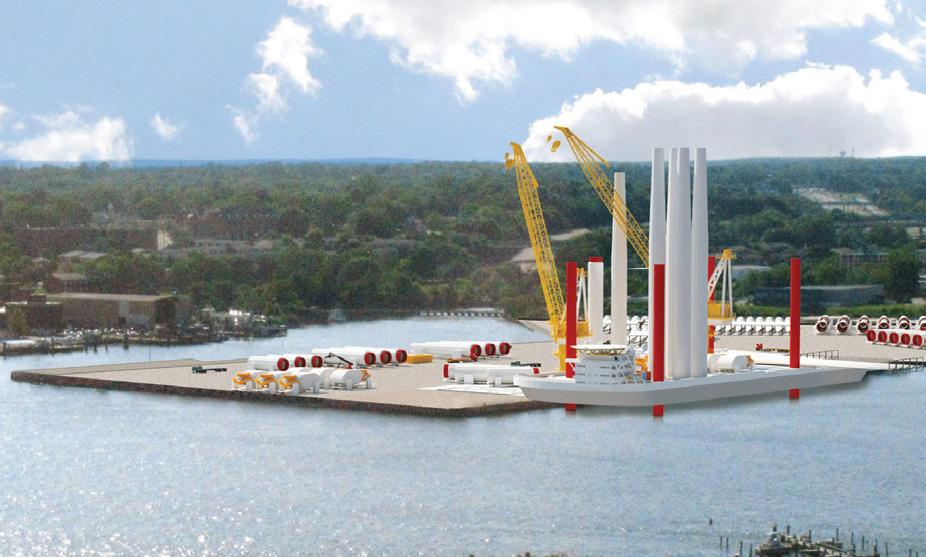
Lyden-Walker says European interests could bring in their own vessels for wind farm construction but would have to demonstrate that the vessels required are not available under the US flag. “It will be fought by labour unions and Jones Act advocates,” she says.
Another problem holding back offshore projects is the lack of available land. “The east coast is heavily developed, and you need space to store the turbines,” says Lyden-Walker. As for permitting, she believes that Europe has done a better job in pulling stakeholders together.
One of the earliest offshore wind proposals, more than 20
US EAST COAST: OFFSHORE WIND 26 | DECEMBER 2022 For the latest news and analysis go to www.portstrategy.com
8 The Connecti cut Port Authority State Pier Project as envisaged on completion – work is advancing on this specialist project to serve offshore wind developments
years ago, was off Cape Cod – but the development never happened. The Cape Wind project was for 130 turbines off the Massachusetts coast but there was strong pushback from key figures, not least the Kennedy family. “They all eventually came around but by the time they did, the contracts for the energy to be produced had withered, so it never came to fruition.”
The United States’ first offshore wind farm – a tiny development of just five turbines – went ahead at Block Island, in Rhode Island state, in 2015-16. That, says LydenWalker, was largely down to the determination of the senator, Sheldon Whitehouse, and the development of a marine spatial plan (MSP), driven by his wife, Sandra Whitehouse, Senior Policy Advisor at the Ocean Conservancy. “This brought together all the stakeholders – fishing interests, cable interests, commercial shipping, and so on, and discussion about how the wind farm could be sited so that it didn’t impact them. Between them, the Whitehouses had political clout and they did it the right way.”
Lyden-Walker became involved in work to expand the
VPA converts container facility
Virginia Port Authority (VPA) is investing US$220m to convert a former container terminal into an offshore wind base.
“Right now we are building the east coast’s primary logistics centre for offshore wind,” says VPA spokesman Joe Harris. “We are leasing the Portsmouth marine terminal, a retired container facility, to Dominion Energy and Siemens Gamesa Renewable Energy; they will do the staging and completion of components for offshore wind, for construction of the Coastal Virginia Offshore Wind (CVOW) project.”
The investment includes berth and landside remodelling and strengthening to be able to handle the heavy components; a new pier will be built, specifically designed to accommodate the large ships bringing in the components. Warehousing is being built to accommodate SGRE’s blade finishing operations.
“We expect the terminal renovations to be done in two years and the project will then take off in earnest,” says Harris. “We are leading the way. A lot of other ports are hustling to get into the game, but we have this terminal available – with deepwater access, no overhead obstructions and no bridges. There are a lot of things in our favour – natural assets, geography and manmade assets – and we are leveraging them to become the mid Atlantic’s logistics hub for offshore wind.”
Louisiana plans
A key action in the Louisiana Climate Action Plan, introduced by Governor John Bel Edwards this year, is to achieve 5 GW of offshore wind generation by 2035.
Since the plan was announced, Entergy Louisiana, Entergy New Orleans and Diamond Offshore Wind have signed an MoU for the evaluation and potential early development of wind power generation in the Gulf of Mexico, in Louisiana state waters.
MSP concept under Obama – designed to expand renewable energy and to bring together stakeholders so they could identify the ‘go/no-go’ areas.
“For example, there was a proposal for siting a wind farm off Virginia that was going to be right in the middle of a shipping lane – had they not done their process, there would have been a problem.”
PORT REVITALISATION
Aside from the obvious climate benefits, the development of offshore wind is having another positive impact, LyndenWalker adds: “A lot of the secondary ports that have been shrinking in the past few years are starting to get a renewed sense of life because of offshore development. There often isn’t room for the large installation vessels at larger ports, so they are accessing the secondary ports. New London is a good example.”
Connecticut Port Authority is investing US$250m to transform State Pier in New London into a heavy-lift capable port suitable for wind turbine staging and assembly. Its partners in the project, Ørsted and Eversource, are contributing US$75m to the work. Three offshore wind projects commissioned by Connecticut, New York and Rhode Island, totalling more than 1700 MW, are already scheduled to be delivered from State Pier.
Other notable port sector initiatives include those featured in the accompanying table.
New Jersey goals
In September, the New Jersey Governor signed an executive order to increase the state’s offshore wind target by almost 50 per cent, from 7500 MW to 11,000 MW, by 2040. The order also directed the New Jersey Board of Public Utilities to study the feasibility of increasing the target even more.
Georgia Port Authority
Georgia Port Authority is evaluating opportunities to use alternative energy sources such as solar, wind, hydrogen, ammonia and renewable natural gas, and is interested in piloting various technologies, says Joanne Caldwell, GPA’s director, risk management & sustainability.
The port authority has so far not been approached by offshore wind developers for any type of assistance: “GPA is open, however, to discussing this fastdeveloping sector with its stakeholders,” says Caldwell.
New York hub
In March this year, New York City Mayor Eric Adams announced an agreement to transform the city-owned South Brooklyn Marine Terminal into one of the largest offshore wind port facilities in the US.
The terminal will be upgraded and expanded as an operations and maintenance base in a deal between New York City Economic Development Corporation, Equinor, BP and SSBMT (Sustainable South Brooklyn Marine Terminal).
It will provide a power interconnection site for the Empire Wind 1 project, heavy lift staging and installation facilities for Equinor and other developers, and support hub for the Empire Wind and Beacon Wind offshore wind farms.
US EAST COAST: OFFSHORE WIND For the latest news and analysis go to www.portstrategy.com DECEMBER 2022 | 27
8 Port Plans Targeting US East Coast Offshore Wind Projects
…it is one thing to wave your magic wand, granting leases, etc., but we don’t have the installation vessels or equipment
‘‘
Europe’s leading commercial marine and workboat exhibition
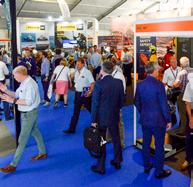

Make the most of marketing & PR support from Seawork, Maritime Journal and our leading commercial marine magazines, in print, online, eNews and via social media.
Showcase your latest innovations in vessels, equipment and services to an international audience of over 100,000 all year on Seawork.com
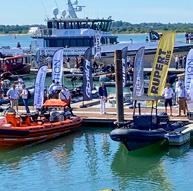
Seawork & Marine Civils exhibition encompasses 12,000m2 of halls featuring 600 exhibitors and over 70 vessels and floating plant.
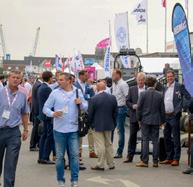

Features include the European Commercial Marine Awards (ECMAs) and Innovations Showcase.

The Seawork Conference programme offers opportunities to explore the challenges, changes and emerging opportunities in today’s and tomorrow’s commercial marine and workboat sector.
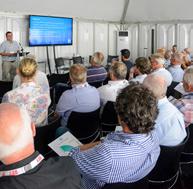

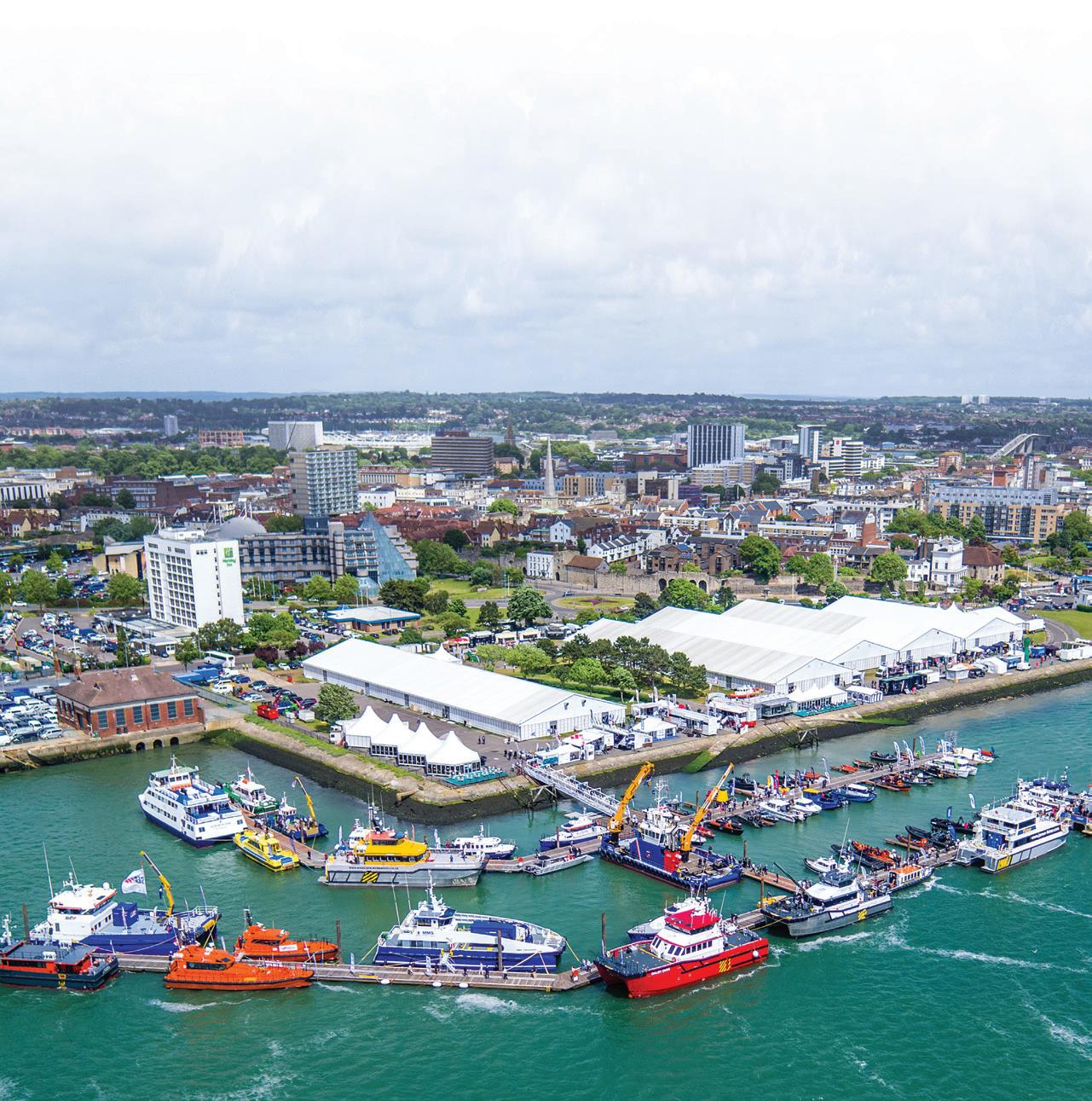
Speed@Seawork Sea Trials & Conference Also returning in 2023 Co-located with: For more information visit: seawork.com contact: +44 1329 825 335 or email: info@seawork.com #Seawork MARITIMEJOURNAL COMMERCIAL MARINE BUSINESS BOATINGBUSINESS THE UK LEISURE MARINE BUSINESS Media partners: JUNE 20 23 Southampton United Kingdom 13 15 TO Seawork is open for business – all year Reserve now for 2023. Keep your full business profile and capabilities in front of your customers 365 days a year. Create meetings with Seawork visitors and build business all year. Hold product launches and host leadership events.
RUSSIA TRIGGERS TRANSITION
Russia’s aggression in Ukraine is providing added impetus to generating clean energy from offshore wind in the Baltic. A J Keyes reviews the pace of development and allied port opportunities
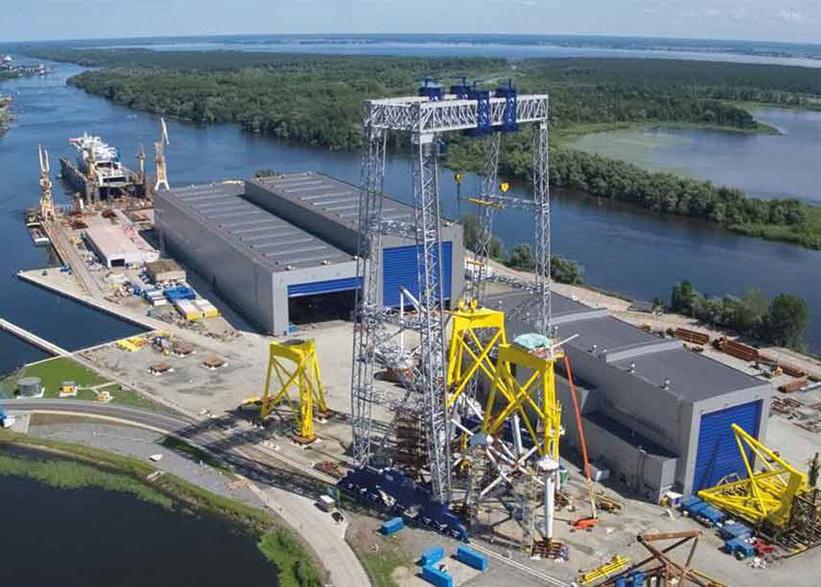
Cleaner sources of energy are gaining ground. Cheap electricity from renewable sources could provide 65 per cent of the world’s total electricity supply by 2030.
For the port industry, renewables represent growing markets to serve, and they have a crucial role to play because the demand for decarbonisation is growing at pace.
The Baltic region is certainly approaching this subject with gusto, with this recently being ramped-up by the Russian aggression in Ukraine.
With Russia halting or significantly reducing the supply of gas to its European neighbours, a total of eight countries that border the Baltic Sea, namely Denmark, Estonia, Finland, Germany, Latvia, Lithuania, Poland, and Sweden, have collectively agreed to raise offshore wind power generation capacity, in order to significantly lower their dependency on energy supplied by Russia.
Mette Frederiksen, Prime Minister, Denmark, notes: “We have agreed to increase offshore wind in the Baltic Sea seven-fold by 2030. In this war Putin is using energy as a weapon and has put Europe, as we all know, on the brink of an energy crisis with skyrocketing energy prices.”
Frederiksen further explains that the Baltic Sea currently has 2.8 gigawatts (GW) of offshore wind capacity in place, with much in Danish and German waters. Adding 20 GW will be enough to supply electricity to two million households and will take advantage of the “great potential for offshore wind,” she added, before confirming, “Putin’s attempt to blackmail us with fossil fuels is failing. We’re accelerating the
green transition. We are getting rid of the dependency on Russian fossil fuels”.
MOMENTUM BUILDS
This latest news is part of a longer-term 2050 aim of Baltic Sea wind energy capacity reaching up to 93 GW, but in the short-term a reduction of over 65 per cent for dependency on Russian gas is targeted for completion by 2030. This will be achieved in conjunction with the renewables energy share increasing to 45 per cent.
This, in turn, builds on the wider EU commitment to the sector announced in late 2021. On 11 December all 27 Member States adopted Council conclusions on “fostering European cooperation in offshore and other renewable energies”. The Council welcomed the European Commission’s Offshore Renewable Energy Strategy and recognised the need for further integration of the internal energy market, asking the Commission to work on an ‘enabling framework’ for crossborder and hybrid offshore projects. Furthermore, in an allied development at the same time the council adopted separate conclusions on building a hydrogen market for Europe, supporting the Commission’s EU Hydrogen Strategy of July 2020. These conclusions stress that renewable hydrogen, produced from renewables such as wind and solar, should be given priority over other forms of hydrogen.
At an individual country level, there is also a growing commitment to the offshore renewables sector, with Denmark and Germany at the forefront.
BALTIC SEA: OFFSHORE WIND
8 The ST3 offshore facility in the Port of Szczecin, Poland - designed for the production of transition pieces, jacket and monopile foundations. Vestas is also establishing a wind turbine factory in Szczecin
For the latest news and analysis go to www.portstrategy.com DECEMBER 2022 | 29
Project Location
Stated Power Capacity Supporting Port*
Baltic Eagle 30km northeast of Rügen Island, Germany 476 MW – power for 475,000 homes Swinoujscie
Baltic II 55km from Polish Coast 25 generators, each giving 14 MW of electricity – power for 350,000 Polish homes
Baltic Offshore Beta East Coast of Sweden 3.3 GW
Ustka
Concept – early planning stage
Timescales
End of 2024
Commissioning from 2026
Baltic Power Polish Coast 23km offshore, near Leba & Choczewo 1.2 GW – power to 1.5 million homes Szczecin/Swinoujscie By 2026
Bornholm Island North Baltic Sea off Swedish Coast 3.0 GW – power to 4.5 million homes Rønne By 2030
ELWIND Kurzeme region, between Liepaja and Ventspils, Latvia/Estonia share in area west of Sõrve
700 MW – 1 GW
Construction from 2028,commissioning from 2030
Energy Island –Bornholm 15km southwest of Bormholm Island 2.0 - 3.0 GW – power for up to 3 million homes Roenne
Studies underway by Danish Ministry of Climate, Energy & Culture
Lithuania Offshore Project 30km-40km offshore 700 MW Klaipeda In 2028
Thor Offshore Wind Farm 20km from Nissum Fjord, Denmark 800 MW – 1 GW
Lemvig Havn / Skabelsens Port Before 2030
Veddum Kaer Onshore Wind Farm Mariagerfjord Municipality, North Jutland, Denmark 48.8MW – mix of wind and solar power Aalborg During 2023
Denmark is a recognised pioneer in the energy renewables sector and continues with its ambitious plans to reduce greenhouse gas emissions by 70 per cent from its 1990 levels by 2030, with 100 per cent of electricity from renewables by the end of this decade. This is on the back of solar and wind energy already supplying half of national electrical demand, representing the highest wind production per capita of any OECD country. Currently, there are 19 different wind-related projects planned by the government within the next five years, representing a total investment of around US$10bn.
Germany is one of the world’s leading offshore wind energy providers, with 7.7 GW of capacity, but there are confirmed, if somewhat ambitious, plans to increase this by almost 300 per cent to 30 GW by 2030 and then keep increasing to 70 GW by 2045. This means a target of 80 per cent renewable energy for its electricity consumption in 2030. To help meet the targets, recent governmental plans
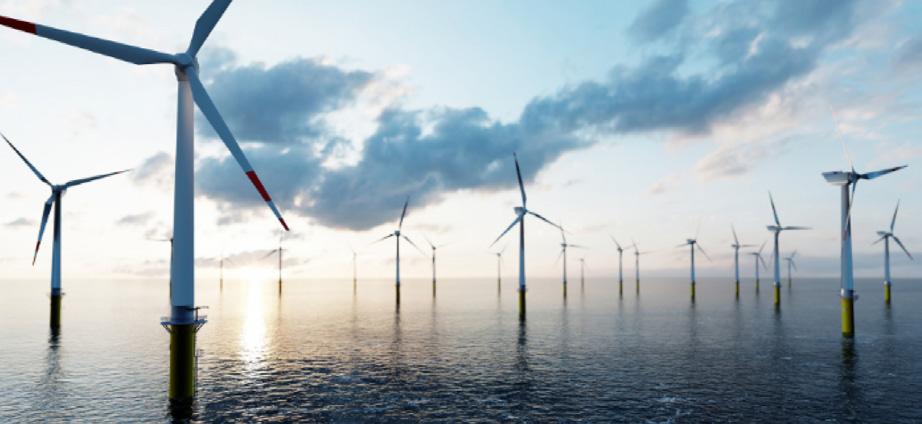
include a strong rise in its offshore wind ambitions with over 10 GW of new wind energy annually after 2025.
However, this may actually be a conservative estimate. The Fraunhofer IWES research institute has published a new study that explains how up to 82GW of offshore wind could be realised in the German North and Baltic Seas, through various scenarios including harnessing the benefits of new power technologies.
Regardless of the exact amount that could be realised, there is no doubt that the Russian invasion of Ukraine has accelerated plans in the sector, with Christian Lindner, Finance Minister, German Government, describing renewables as “freedom energies.”
While the majority of existing renewables facilities are in the German North Sea, where there are also a high number of known projects under further consideration, according to the Centre for Strategic and International Studies (CSIS) in
Source: BPO, data&, reported plans
8 Table 1: Select New and Planned Renewables Offshore Wind Power Projects in Baltic Sea
Note: Includes both confirmed ports and estimates based on geographic location. MW = megawatts
8 Denmark and its neighbours around the Baltic Sea, Sweden, Finland, Germany, Poland, Latvia, Lithuania and Estonia, signed a declaration on 30 August that aims to rapidly expand offshore wind power capacity
BALTIC SEA: OFFSHORE WIND 30 | DECEMBER 2022
to www.portstrategy.com
For the latest news and analysis go
Washington DC, the Baltic coast is the future focus. The CSIS says that offshore wind activities can “help revitalise coastal communities that host construction, operations, and maintenance activities.”
This is certainly true at Mukran Port in northeast Germany. The newly built Offshore Terminal South is supporting offshore wind farms, “EnBW Baltic 2” and “Wikinger” while the “Arkona Beckon” operation is underway by energy supplier, EON. The port confirmed that it has constructed a new port area solely for this industry and is targeting 25-year support services.
Poland also has a prominent position in the sector, with over 90 different projects. The Polish State National Energy Policy (PEP2040) assumes offshore wind energy capacity in the Polish Exclusive Economic Zone of the Baltic Sea growing to 5.9 GW by 2030 and 11 GW by 2040.
According to the National Reconstruction Plan released in Poland in 2021, Ustka and Łeba are the two ports on the central coast to offer facilities for offshore wind farms being built on the Słupsk shoal, approximately 30 nautical miles out to sea.
Eventually more than 300 turbines will be built here, but initially 100 units over 200m high will be supported via Łeba, providing power to around two million homes. The use of this port has been confirmed by Equinor, which has acquired a site here to serve as the operations and maintenance (O&M) base for the Polish Baltic Sea offshore wind projects. Together with joint venture partner Polenergia, a new base is being constructed to support the Bałtyk offshore wind projects.
Another project gaining traction is the Baltic II development. It was originally developed by Baltic Trade & Invest (BTI), before it was acquired by RWE Renewables in 2018. Construction is slated to commence in 2024, with commissioning during 2026. A service station for the operation and maintenance of this wind farm is being developed at the Port of Ustka, with a 25-year lease signed in 2021, with the aim of making sure the service station is ready by 2025.
WIDESPREAD PORT SUPPORT
The Port of Gdańsk recently launched a new tender to lease an area within its Outer Port boundaries related to the construction of an installation terminal to support an offshore wind operation that had originally been earmarked for the Port of Gdynia.
The move follows the Polish government choosing to switch the location between its two leading ports. The Port of Gdańsk expects the facility to be operational in 2025.
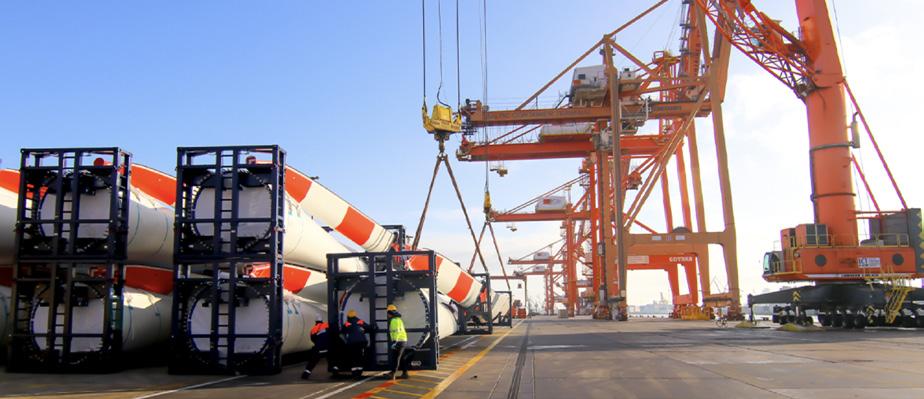
The Baltic Container Terminal in Gdynia has, however, already established its expertise at handling wind turbine
components and has an active presence in the sector. It has achieved the status of the main hub for handling components for inland wind farm projects and is already engaged in discussions regarding offshore farm projects.
The port of Szczecin/Swinoujscie is also getting involved. The Baltic Power offshore wind farm project has prompted the development of a new terminal platform in Swinoujscie plus Vestas is setting up a new turbine factory in Szczecin. The 20ha terminal, with two quays, is expected to be operational in 2025. The quays will facilitate the pre-assembly of wind turbine towers over 100m high and weighing around 1000 tonnes each.
To help put the development of energy renewables into perspective, Table 1 (p30) highlights a select number of new or confirmed, largescale plans for the Baltic Sea area.
For ports in the region there are further opportunities to support a growing industry, a view endorsed by the Baltic Ports Organisation (BPO) in October 2022.
There are other projects across the region and ports will play an integral role. Latvia’s National Energy and Climate Plan is raising its current total onshore and offshore wind capacity from 70 MW to 800 MW by 2030. In September 2022, the Latvian Government stated that the Investment and Development Agency of Latvia (LIAA) will take charge of its involvement in the 1 GW “Elwind” project, an offshore cross-country development with Estonia. Latvia has in the past made some moves regarding the development of offshore wind farms but none have come to fruition – there are, however, now clear signs momentum will build.
This initiative ties in with the Port of Tallinn in Estonia spending US$56 million on a new 310m quay, with a 10ha yard area in Paldiski South Harbour to offer capacity to receive high-draft special-purpose vessels for the construction of offshore wind farms and the transport of wind turbine components, before subsequent loading to ship. Tallinn is also expected to develop maintenance facilities to support the offshore wind industry by 2028.
It is clear that the ongoing Russian aggression in Ukraine is prompting Baltic Sea countries to accelerate and expand renewable energy plans. This, combined with the other sector drivers, is presenting the region’s ports with some interesting new business opportunities.
BALTIC SEA: OFFSHORE WIND For the latest news and analysis go to www.portstrategy.com DECEMBER 2022 | 31
8 The Baltic Container Terminal, Gdynia, has established itself as the main hub for inland wind farm projects and is ready to support offshore wind farm development
Putin’s attempt to blackmail us with fossil fuels is failing. We’re accelerating the green transition
‘‘
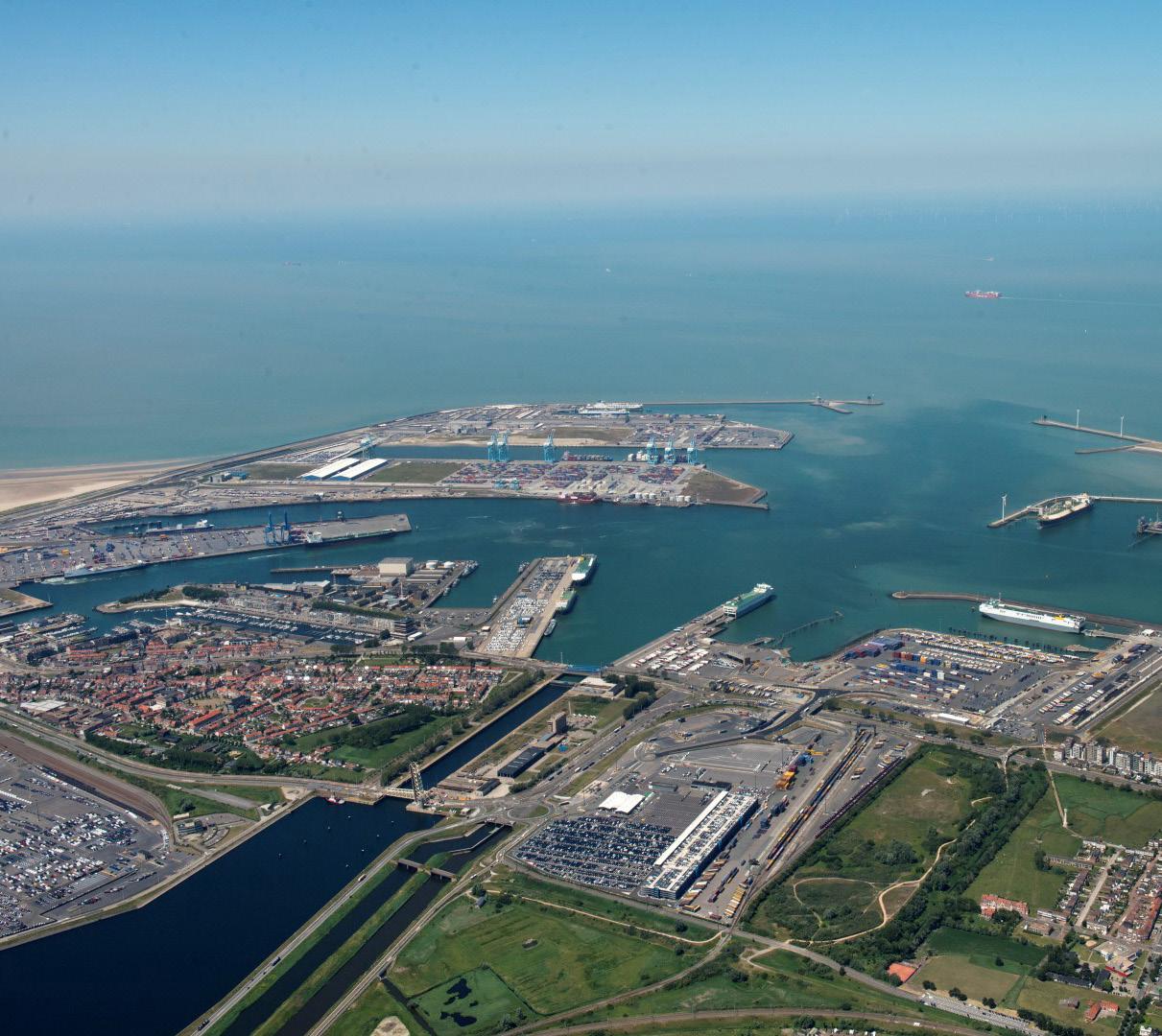






Downloads available now! Did you miss the world’s leading conference on balancing environmental challenges with economic demands? Greenport Congress & Cruise complete download including on-demand content 310 EUR Programme highlights incuded: • Fuel & energy provision for shipping & cruising • What’s next for the cruise industry – taking a look at the latest in sustainable cruise ships • Green Corridors - A pathway to net zero • Monitoring - How ports can monitor their emmisions • Ports/Terminals: Transitioning to Clean Fuels –The key Steps To make your purchase: visit: portstrategy.com/greenport-cruise-and-congress contact: +44 1329 825335 or email: congress@greenport.com Media Partners: PORTSTRATEGY INSIGHT FOR PORT EXECUTIVES GREENPORT INSIGHT FOR PORT EXECUTIVES #GPCongress Supported by: Sponsored by: Host Port:
TOUGH TIMES FOR MPV MARKET
The war in Ukraine, the knock-on effect on food and energy, and high inflation are feeding into a weakening multipurpose and heavy lift shipping market, according to a recent webinar organised by Drewry.
Susan Oatway, Senior Analyst, Multipurpose and Breakbulk Shipping, said that despite weakening rates, there was – in the short term – some positive news for both carriers and shippers. “For carriers, although rates are weakening, they are still very high. For shippers, there are weaker rates but also more capacity and better relationships, so the pressure is slightly less there.”
Having bounced back in 2021 with 4.5 per cent growth, dry cargo demand (including bulk, container, general and project cargo) is expected to see slower growth of one per cent over 2022. It is still averaging two per cent growth heading into 2023, so there is still positive growth, said Oatway. The specific MPV market share rebounded strongly in 2021 with seven per cent growth – that is expected to slow to nearer four per cent in 2022 and 2.25 per cent in 2023.
“The MPV market benefited from the desperate search for space which led to cargo coming out of containers to MPV/ breakbulk; that effect has already started to slow and will continue to weaken into 2023. MPV demand is expected to grow at an average rate of 2.1 per cent from 2018 to 2023, she said. Growth for 2023 is forecast at three per cent - “still growth, just slightly weaker than we had previously been expecting”.
Other than this, it was hard to find an optimistic note. The global economic position is worsening as Covid-19 lockdowns in China and the conflict in Ukraine continue, said Oatway. Meanwhile, more than 40 per cent of the current multi-purpose vessel (MPV) fleet is over 20 years old and scrapping is at an all-time low. “Where is that ageing fleet going and where is the investment in a potential new fleet –who is going to carry those wind blades of the future?”
Drewry’s multipurpose time charter index showed a continued decline in September, losing 10 per cent in value since the peak of the first quarter 2022. The decline was at a much faster rate than had been predicted.
“Rates fell over our basket of investors by some 5.4 per cent and that took the index to an average US$10,075 per day. Our prediction for October is more of the same. Increasing global uncertainties and continuing small shifts in demand are expected to further weaken the market – our current prediction is a further five per cent decline over the coming months.”
She pointed out that global growth projections had been revised down by almost two per cent per year over the past 12 months.
Time charter rates, having risen by 148 per cent from the low point in June 2020 to the high point in March 2022, fell by about five per cent in the following six months. “Although rates are weaker, they are still at historical high levels in all sectors.”
Drewry expects period charter rates for the MPV sector to continue to weaken into 2023, albeit at a slower pace. “This is a function of the market share being eroded, increasing competition, and capacity increasing. We expect that to continue over the medium term as well, but we do expect rates to remain above pre-pandemic levels, even as they are weakening.”
GLOOMY OUTLOOK
Oatway’s analysis of the key risks to the outlook were not cheerful. “There is little to any upside to our base case scenario. Any upside would rest on some fairly dramatic geopolitical events,” she warned. “Unfortunately, we are much more able to imagine a worsening forecast, with increasing uncertainty due to high inflation and commodity prices, reduced investor confidence, weaker demand and increased competition for cargo. All of these could take rates back much closer to 2019 levels in the longer term.”
MPV Order Book reflects the market and remains slim
In reply to a question as to why the fleet is under-invested, Oatway said: “This sector was in decline for some ten years prior to the pandemic; rates in 2019 were barely above operating costs. The Beluga case and the withdrawal of the KG schemes have meant that there is little, if any, outside investment for this sector.
“Operators have had 12-18 months of high rates – it is not long enough to finance a building boom – but for some of the larger carriers, the few newbuildings we have seen
are linked to long-term cargo commitments, specifically in the renewables sector. That is likely to be the way forward for operators in this sector, to look at longer-term contracts that offer shippers schedule reliability and stable rates and give the carriers the incentive to modernise their fleet.”
MPV fleet supply graphs show a clear bulge in newbuildings across the sector between 2007 and 2013. Then the lack of recent deliveries is clear, said Oatway,
especially in the project carrier and heavy lift vessel segments. “In this sector there is barely anything in 2017-21, then we have maybe half a dozen newbuildings in 2022, but it really is very thin on the ground. The orderbook schedule picked up in the third quarter 2022 but represents just four per cent of the operating fleet.”
Although the MPV fleet has been in decline, due to low scrapping levels it actually grew in 2021 and that will happen again in 2022, she said.
MULTIPURPOSE VESSEL MARKET PROSPECTS
For the latest news and analysis go to www.portstrategy.com DECEMBER 2022 | 33
With the current multi-purpose vessel fleet ageing and little newbuilding activity, Drewry asks the question who is going to carry the wind blades of the future? Felicity Landon reviews the premier findings of a recent Drewry webinar assessing MPV market prospects
… where is the investment in a potential new fleet –who is going to carry those wind blades of the future?”
‘‘
THE DOVER AGENDA
UK talks one-on-one with Felicity Landon and spells out the port’s frustrations, challenges, projects and aspirations
Doug Bannister, CEO, Port of Dover, wants the UK government to get a grip on the implementation of new biometric controls which he fears could cause more upheaval next year.

Dover would get the blame for any delays, says Doug Bannister. “But we can’t prepare for something we don’t know.”
The freight and passenger ro-ro port has been settling down since the mega-queues in July (2022) which kept Dover in the headlines. It’s two years since the Christmas chaos when France closed its borders to stop the spread of Covid. As he says, the port remained open and operating through Brexit, Covid, French border closures and summer getaway weekends, “and that that has meant that the nation keeps the supplies rolling”.
However, now another major headache is on the horizon –the implementation of new biometric controls. The EU’s new border control IT system, EES (Entry/Exit System) is due to be implemented in May 2023.
This will require anyone entering the EU – drivers and passengers alike – to register fingerprints and a photo with their passport details. Dover has already had to adapt to post-Brexit requirements for British travellers’ passports to be stamped, not just waved through by the French border police (Police aux Frontières, or PAF). The EES has been on the cards for four years, says Bannister – but the details have yet to be specified.
“There will be two stages to the process. Registration, when you have your biometrics put into the system alongside your passport, by a police officer. Validation – every time you cross the border, your biometrics will be validated. The
challenge is that we don’t know anything about this process – it hasn’t been defined and the technology hasn’t been tested or trained on. So, we are in a period of the unknown.”
Dover has heard that registration will take two minutes per passenger and two minutes per car; that, of course, translates into more than 10 minutes for one car carrying four people.
The current process for stamping passports takes 1.5 minutes per car. “In an operation where we talk about shaving seconds off, this will have a material impact,” says Bannister.
There have even been suggestions that the process would require passengers to present themselves in a queue at the kiosk. “Imagine – late night, raining, people asleep in the back of the car. We can’t allow people to exit the vehicles in the busy lanes – it is too dangerous. This process needs to be done while people are in their cars.”
As 70-80 per cent of truck drivers passing through Dover are EU nationals, this side of the operation should be smoother; but given that 80 per cent of tourists are British, the implications are clear. At the end of the day, gridlock for one is gridlock for all.
“We are facing implementation in May next year but we still don’t know exactly what it is going to be,” says Bannister. “There is little that the port itself can do – all we do is host the process. It is an EU-defined process and their relationship with the UK is via the Home Office. While we can tell them what will/won’t work, we need our government to work with the French government and the EU. We need our government to grip this issue and work with the French and EU authorities to deliver a solution that will work for a fast turnround ferry port.”
As he notes, May is not the best time – just as tourist travel
DOVER FOCUS 34 | DECEMBER 2022 For the latest news and analysis go to www.portstrategy.com
8 The velocity model – Dover turns its berths over 10 times a day and its land six times a day
Doug Bannister, CEO, Port of Dover,
is cranking up for the peak season. There may be a soft landing or transition period which could help, “but we need to know – what are the rules of the game, what’s the technology, who will operate the technology and do we have to train people on it?”
Dover has been highlighting this as an issue for years, says Bannister. The EES will have its impact on destination ferry terminals and airports in Europe, but Dover is unusual because of the system of juxtaposed border controls, which means entry to France is controlled on the UK side. The benefit of that is that all the processes are upfront, before travel; the disadvantage is that Dover hosts two lots of potential delay. “Elsewhere, when you take a flight, for example, you turn up two hours before, drop bags, go through security, wait, get on the plane. On the other side, you get off the plane, go through immigration, get your passport stamped, and so on.” People should look at the ‘end-to-end’ disruption of a journey in order to make a fair comparison.
THE VELOCITY MODEL
Bannister underlines, Dover’s business model is based on ‘velocity’. “The main reason that the market has chosen this route is the efficiency we have. Our ferries can complete up to five round-trips a day. We turn our berths over ten times every day and turn over the land six times a day. Looking at capacity, we don’t have the geographical footprint of other ports. Felixstowe, the UK’s largest container port, handles about 4.5mTEU a year, operating on about 400 hectares including roads, buildings, quays, etc. We do 2.5m trailers –the equivalent of 5.5mTEU – through our facility and our ferry terminal has a footprint of 40 hectares. The key thing is velocity – we look to shave minutes and seconds off each movement. We look at everything – routes, roads, sister ports, anything that could affect us.”
Some 11m passengers pass through Dover in a year –equivalent to the third or fourth busiest regional airport in the country, he points out. “And airports just do foot passengers; we do cars, caravans, taxies, bicycles, horse boxes, buses.”
Throughout post-Brexit planning, Dover made clear that it did not have room to build new border control post facilities, or to handle additional Customs documentation and paperwork. The full Customs checks were implemented from 1 January this year; the paperwork is done before arrival at the port but even so, there were delays for a couple of months when businesses were still getting accustomed to the requirements. “That has smoothed out now but we do know it is impacting the wider supply chain.”
The government built the Sevington inland border facility to serve the port and Eurotunnel, keeping BCP processes away from Dover.
Bannister says that in the July disruption, the port was back to normal after 36 hours; even in the Christmas 2020 chaos, when there were 3500 trucks waiting at Manston, the backlog was cleared within a week. “The message is that while there may be queues on very busy travel days, the resilience and capacity of the port is such that we clear the backlog very swiftly,” he says.
The port and all of its staff have had a ‘pretty challenging period’. Bannister says he has ‘extreme pride’ in the port and its people. “Whether harbour board or stevedores, ferry operators or Border Force – everyone’s whole ethos, DNA, is to keep the traffic moving. When the chips are down, everybody rallies.”
The Port of Dover has invested £200,000 in new infrastructure to smooth processes for trucks and passenger traffic – and it wants to move forward with a £50m-plus project to relocate and reorder the border control plaza deeper into the port. “This is a huge project and we are still talking to the government about funding,” says Bannister.”
LOOKING AHEAD
There is no doubt that Dover was very internally focused during the Brexit period and Covid-19 pandemic, says Bannister. “But in the past 12 months, we have been starting to lift our head and look forward.”

In April 2022, the port released its sustainability agenda. It has set a target for net carbon zero port operations by 2025 and has already converted all its landside vehicles and assets from diesel to HVO, and it is working on plans to become part of the UK’s first ‘green logistics corridor’, extending the focus to emissions from ferries and vehicles in the supply chain.
“We are taking firm control of our leadership position as the premier port in the UK; one-third of all trade with the EU comes through our facility,” notes Bannister. “We have pulled together a powerful coalition – ferry operators, sister ports in France, local, regional and central government in the UK, regional government in France, and academics including at the University of Kent. We benefited from a grant from the Clean Maritime Demonstration Competition. Now we are in the process of securing about a million pounds in round two [of CMDC], to help us understand what it is going to take to achieve our goals.”
A big focus is on future power requirements, not only for cold ironing but for recharging the electric ferries of the future. It has been established that Dover needs 4 MW for present operations – while the total capacity coming into the Dover region is 8 MW “and a lot of it is consumed”, says Bannister. If cruise ships were to ‘plug in’ for onshore power, 7-11 MW would be required. To recharge electric ferries, trucks and equipment, the figure jumps to 150 MW.
CMDC1 gave “the frightening numbers and clarity” while CMDC2 will consider “how do we provide it”, says Bannister.
“Could we go for hydrogen instead of electric? Maybe the ferries could go fuel cell or methane. But no matter what it is going to be, it will be a complete change of infrastructure to
DOVER FOCUS For the latest news and analysis go to www.portstrategy.com DECEMBER 2022 | 35
New biometric controls are a looming problem with little clarity from government about the new arrangements and IT systems to be deployed
‘‘
8 “In the past 12 months, we have been starting to lift our head and look forward” – multiple projects are on the agenda
Doug Bannister, CEO, Port of Dover
AVOIDING RUSSIAN ROULETTE
The role of Russia’s St Petersburg port as a Baltic Sea powerhouse has been declining in recent years, but with the tyrannical approach deployed by President Putin in the Ukraine this has effectively put the port on its knees. With volumes in St Petersburg seeing an 85 per cent decline this year, this is not just a problem, but a complete collapse. It additionally highlights the incentive for other regional ports to field alternate strategies to offset lost Russian cargo.
While the outcome of Russia’s invasion of Ukraine is not yet known, key Baltic container market trends are apparent and in particular the demise of Russia-linked transshipment. The period of reliance on transshipment into Russia, either directly via St Petersburg or transit via the Baltic States, has passed – at least for the present. Indeed, as long as sanctions continue on Russian cargoes no recovery can be anticipated.
Prior to recent upheavals the Baltic container port market had grown by an average of 2.9 per cent between 2011 and 2021, rising from 7.14 million TEU to just over 9.50 million TEU. Using estimates for 2022, it can be seen in Table 1 how much the decline in Russian cargoes is expected to impact the region, with St Petersburg traffic decimated.
Among the other regional containerports, Gdansk is clearly the stand-out performer. For the Q1-Q3 2022 period the port has seen volumes rise 15.5 per cent over the same nine months of 2021, while increases can also be noted for Gothenburg (which saw a six per cent rise to end of Q3 2022 vs end of Q3 2021), along with Maersk Line-supported Aarhus, and Klaipeda.
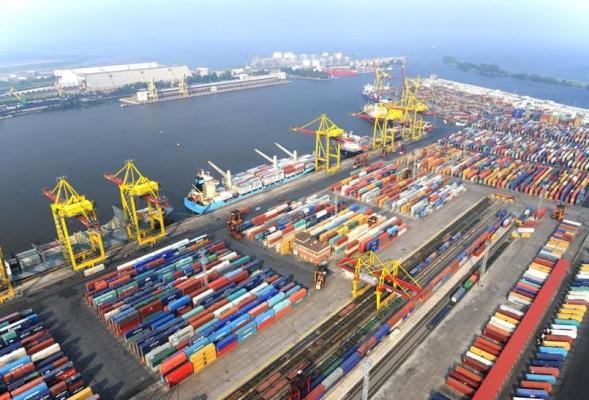
Traditionally, the longer sailing time beyond the major north European hubs and more limited infrastructure, especially water depth, has meant that ports in the Baltic Sea region were not direct deep-sea calls, but instead part of a hub-and-spoke transshipment operation utilised by shipping lines. Indeed, the possibilities for routing the largest vessels into the eastern Baltic are very limited and port development programmes reflect this reality.
Overall, the collapse of the Russian transshipment and transit markets brings challenges – a strong alternate/new
DCT GDANSK REBRANDING
DCT Gdansk remains the fastest growing facility in the Baltic Sea region and its strong volume increases over the past decade have been due to its role as a transshipment hub port for Russia and the Baltic region, as well as reflecting the strong position of the Polish economy and resulting domestic demand growth.
However, this port is now re-focusing its primary role. The sanctions on Russia mean that the amount of transshipment traffic being handled by the port has dropped, at least for the short-term. Dean Davison, Head of Maritime Advisory, Infrata, explains further: “For 2021, transshipment at DCT Gdansk probably accounted for about 30-35 per cent of its (growing) total volume, but the fall-out from the situation involving
8 Table 1: Development of Total Container Volumes by Baltic Sea Port 20112022e, in ‘000 TEU
business focus for allied transshipment hubs and a heightening in the competitive temperature between ports/ terminals overall.
BALTIC CONTAINERPORTS 36 | DECEMBER 2022 For the latest news and analysis go to www.portstrategy.com
8 Falling Russian cargo is impacting all Baltic container ports and prompting the development of new business strategies
A need to change strategy is required for Baltic Sea container ports due to lost Russian cargo. AJ Keyes looks at the situation and what some of the major ports are doing to meet the challenge 2015 2016 2017 2018 2019 2020 2021 2022e CAGR ‘15-’21 CAGR ‘15-’22e Gdansk 1,091 1,299 1,581 1,578 1,930 1,931 2,092 2,416 11.5% 12.0% Gdynia 685 642 693 715 810 905 986 952 6.3% 4.8% St Petersburg 1,715 1,500 2,514 2,131 2,222 2,099 2,100 315 3.4% -21.5% Gothenburg 820 798 644 750 763 772 775 830 -0.9% 0.2% Aarhus 445 475 513 561 610 658 718 724 8.3% 7.2% Helsinki 431 451 491 510 526 510 467 448 1.3% 0.6% HaminaKotka 555 628 687 650 670 621 594 560 1.1% 0.1% Kaliningrad 179 189 239 276 324 281 437 292 16.0% 7.2% Tallin (Muuga) 209 204 230 240 239 230 252 200 3.2% -0.6% Riga 355 386 446 475 472 454 416 444 2.7% 3.2% Klaipeda 387 441 472 749 705 640 667 872 9.5% 12.3% Regional total 6,872 7,013 8,510 8,635 9,271 9,101 9,504 8,053 5.6% 2.3% Source: Ports, data&
Russia will see this figure fall to no more than 20-25 per cent. The benefit of an increased dependence on import/export boxes has sharply increased average revenue per move across the quay, so that is appealing.”
In recent years DCT Gdansk has been seeking to lower its reliance on transshipment activity and instead focus more on its competitiveness in serving inland markets, as Davison outlines: “While DCT Gdansk was originally planned as a transshipment hub port, volume growth is now occurring because of its dynamism in the Polish markets and transit activity to Central and East European hinterlands. This change will more than offset any losses caused by a fall in boxes moving via feeders to Russia.”
This is further evidenced by DCT Gdansk adopting its new branding of ‘Baltic Hub’ as part of what it describes as its ambition to be “THE hub for the region, both by land and by sea.”
While there are currently two terminals collectively offering 1300m of quay, 14 ship-to-shore (STS) cranes and a capacity of 2.7 million TEU per annum (putting utilisation at more than 80 per cent and increasing), the new T3 project, due by 2025, will add a further 717m of quay with 17.5m depth alongside, served by seven new STS units and 20 semiautomated Rail Mounted Gantry cranes (RMGs) in the yard.
To support its aims to grow hinterland markets and connectivity to Central and Eastern Europe, rail capacity is also being increased, from 750,000TEU per annum to in excess of one million TEU per annum. This will facilitate serving key locations such as the Czech Republic, Slovakia, Hungary, and Germany.
Of course, the real question is whether the Russian transshipment market can return and, if so, when? This simply cannot be answered at present, as the next move in the war in Ukraine and the strategy adopted by Putin (indeed, if there is an actual strategy) is completely unknown.
The continued success of DCT Gdansk will also likely further impact Hamburg, which has also traditionally been a major link to Poland. Indeed, the domestic hinterland success of Gdansk has been at the expense of the historic western Poland markets served by the German port.
Hamburg has increased and improved water depth and vessel access on the River Elbe for large container vessels but to increase its overall volumes, while offsetting the loss of traffic to Russia via feeders, means a need to increase inland competitiveness. Davison offers a conclusion on this subject: “Hamburg will need to lift its game for inland markets, but this raises the question, what can it do that is
different or will set it apart from, for example, DCT Gdansk, and if it has a strategy, why has it not adopted it already?”
DCT Gdansk is not the only port in Poland’s Baltic market moving forward. With the Port Authority of Gdynia recently extending the port’s turning basin and entrance to 140m the Baltic Container Terminal (BCT) is now able to accommodate larger vessels and has recently handled MSC Gaia – 366m long and MSC Ivana MSC Ivana – 363m long. Also now just starting is the dredging of the approach track to the port to 17m and inner basins to 16m depth.
BCT is both a port for direct services and a feeder port moving cargo to/from the large West European hubs and as such it has felt no significant impact from the war in the Ukraine. Direct services include the recently added Scan Baltic – USA service which offers a 13-day connection to New York and other calls in Philadelphia and Norfolk. Additionally, MSC now offers the North West Continent to India-Pakistan service direct from Gdynia.
BCT’s versatility also adds to its strength with it regularly handling general and project cargo. The latter includes the specialised handling of military equipment for the US Army, stationed in Poland in conjunction with NATO’s enhanced forward presence, and the handling of inland wind farm components with BCT now recognised as the main hub for this activity.
For the smaller Baltic country ports, such as those in Lithuania, Latvia, Estonia, Finland etc., the big challenge is to replace lost Russian transit cargo. Local cargoes in these ports alone are insufficient to justify significant investment, unless there is an ability to diversify – as discussed on p29 where opportunities in conjunction with offshore wind projects are considered.
8 An extension of Gydnia’s turning basin and enlargement of the port entrance is seeing larger vessels call at the Baltic Container Terminal – the MSC Gaia, pictured, has a LOA of 366m
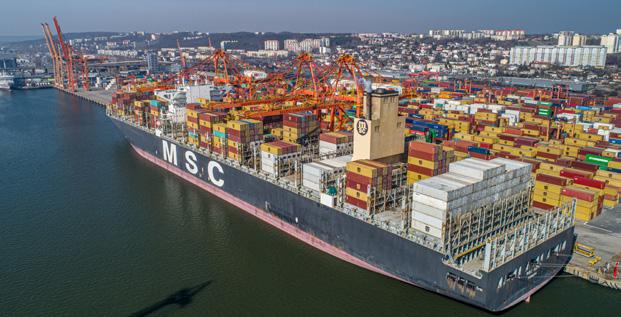
Gothenburg: Hinterland Penetration and Deeper Draught
The Port of Gothenburg has confirmed that for the first half of 2022 it recorded a 53 per cent share of the total Swedish container market, reflecting a rise of three percentage points over the comparable period for 2021.
On this basis, and if this trend continues, then Gothenburg is negatively impacting the likes of Gavle and Stockholm’s new Port of Nynäshamn. Hutchison Ports opened a new facility at Nynäshamn in 2020, offering 16.5m water depth and 450m of quay line, and while it technically could attract direct deep-sea vessels, to date this has not occurred.
One important area for Gothenburg, where momentum is being gained, is the
movement of rail container volumes. The volume increased to 385,000TEU for the first three quarters of 2022, reflecting growth of 13 per cent on the 340,000TEU noted for the comparable period of 2021. The Port Authority highlights that long-haul traffic to/ from Stockholm and northern Sweden represents a major growth area for the movement of cargo on rail.
Moving forward, Gothenburg is deepening and widening access channels for larger ships. APM Terminals is the operator of this facility and also a partner in the project, which it noted as “essential” with work commencing before the end of November
2022. Importantly, this initiative will help alleviate the current situation whereby the very largest ships in service can only call part-loaded.
If things proceed according to schedule, Skandia Harbour will be able to welcome fully laden container vessels of up to 24,000TEU into the Port of Gothenburg by 2026, by offering a maximum draught of 17.5m (compared to the existing 13.5m) and ships that are 430m LOA and with a 65m beam.
The challenge moving forward remains workforce volatility, which has hampered Sweden’s port industry in recent years. At present, the jury is still out on this.
BALTIC CONTAINERPORTS For the latest news and analysis go to www.portstrategy.com DECEMBER 2022 | 37
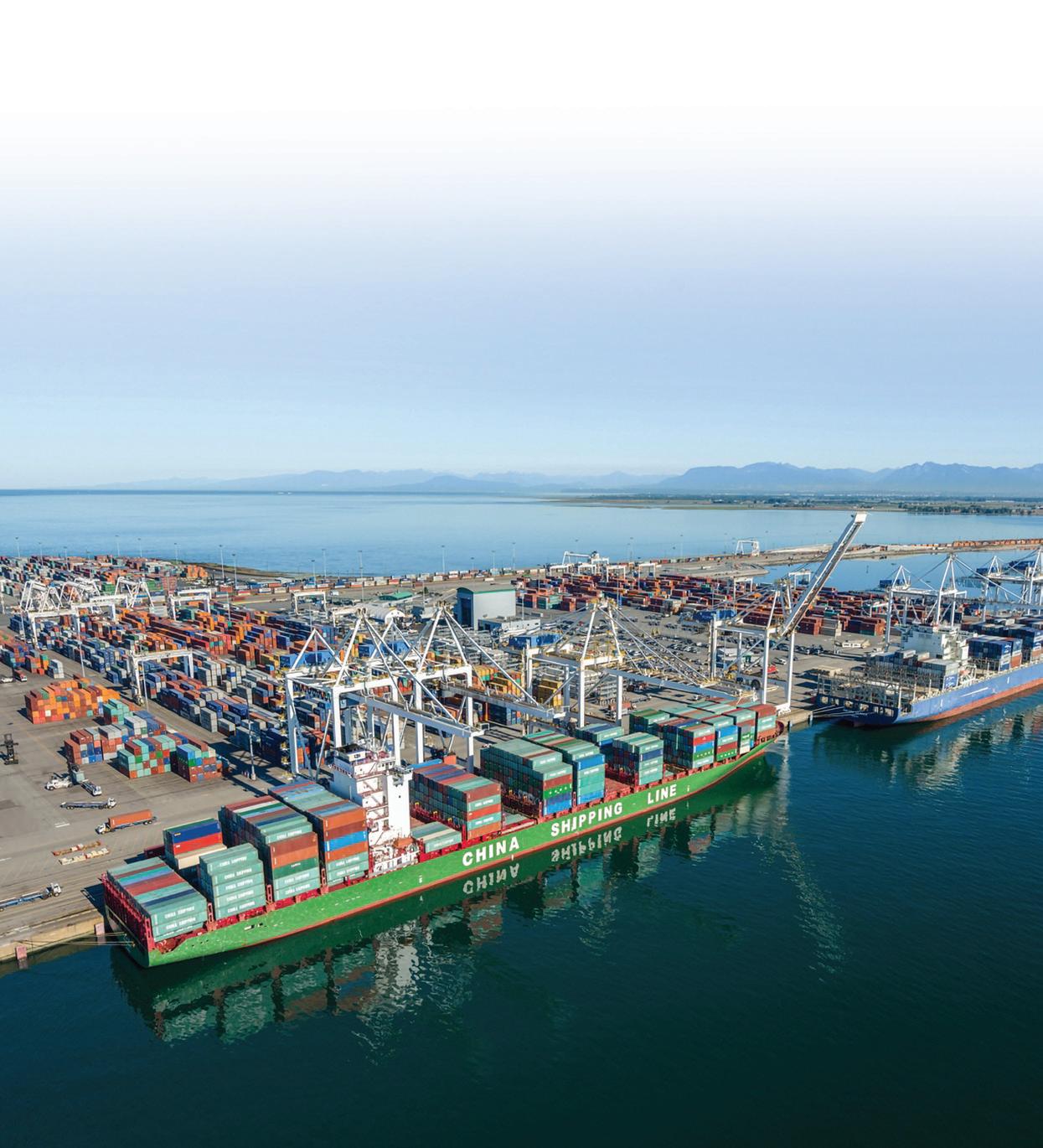


Meet and network with over 200 attendees representing port authorities, terminal operators and shipping lines. For more information on attending, sponsoring or speaking, contact the events team: visit: greenport.com/congress tel: +44 1329 825 335 email: congress@greenport.com #GPCongress OCT 2023 Southern Europe Date for your diary in 2023 Join the world’s leading conference on balancing environmental challenges with economic demands See you next year Green Solutions for Sustainable Ports by 2030 18 TH 2023 Media Partners: PORTSTRATEGY INSIGHT FOR PORT EXECUTIVES GREENPORT INSIGHT FOR PORT EXECUTIVES
KALININGRAD WALKS TIGHTROPE
With road and rail transit capacity cut as a result of the application of sanctions the Russian exclave of Kaliningrad finds itself in a worsening position. Oleksandr Gavrylyuk reports
On 18 June this year, Lithuania, a European Union memberstate, halted the rail transit of cargoes subject EU sanctions between mainland Russia and its Kaliningrad exclave via Lithuanian territory. Three days later, Lithuania took the same course of action with the road haulage of sanctionhit goods.
The EU-imposed sanctions covered some 30-35 per cent of the overall traffic between the mainland and exclave region, including such essential cargoes as construction materials, cement, wood, fertilisers, spare parts and some others.
The Kremlin responded with threats. Vladimir Dzhabarov, First Deputy Head of the Russian Senate’s Committee for International Affairs, stated that Lithuania’s “blockade of the Kaliningrad region” could lead to a military conflict with Moscow.
While he did not elaborate, Russia’s “independent experts” made no secret of a possible “unblocking”. As long as Belarus, which is a natural land bridge between Lithuania and mainland Russia, remains under the Kremlin’s control, Moscow will always be considering a chance to link its exclave with the satellite state.
“The most efficient solution of the Kaliningrad problem” would mean a simultaneous attack on Lithuania from both the exclave and Belarus with the objective of establishing a 100km long overland corridor along the Lithuanian-Polish border.
Alternatively known as the Suwalki Gap, it is one of NATO’s worst nightmares, as this would initially enable Russia to cut off Lithuania, Latvia and Estonia from the rest of the alliance and then to occupy all three Baltic countries.
On 13 July 2022, the European Commission gave a green light to the rail transit of certain sanction-hit cargoes via Lithuania, but only within limited volumes. On 22 July 2022, official Vilnius succumbed to the pressure. However, the traffic of military and dual-use goods and technologies, as well as the road haulage of sanction-hit goods, remained strictly prohibited…
While the Soviet Union remained a single entity, Kaliningrad’s status was not a big problem. However, after the dissolution of the USSR, the region found itself sandwiched between Poland and Lithuania, the two independent states, which eventually joined both the NATO and EU.
As long as Moscow tried to keep itself within the international legal framework, its neighbours did not interfere with the transit of goods. However, with the advent of the Kremlin’s brutal war in Ukraine, continuous threats to other parties in the region and saturation of the exclave with mass destruction weapons everything has changed.
CAPACITY CUTS
During the first three quarters of the current year, the total volume of cargoes railed to/from the Kaliningrad region via Lithuania comprised 1.7 million tonnes out of the 3.1 million tonnes permitted by the European Commission, according to Kotryna Dzikaraite, Communications Partner of LTG, Lithuania’s national railway operator. For example, only 26% of the approved volume of foodstuffs, 35% of wood, 37% of coal, 59% of ferrous metals, 60% of oils, 100% of cement and 31% of other cargoes were moved by rail.
With road haulage, 200 to 300 trucks a day used to enter the region through a border terminal prior to 18 June 2022. After this date, they had no choice, but to embark on a transBaltic maritime service. This, however, is not an effective solution. There are only a couple of aged ro-ro/train ferries operating between the mainland port of Ust-Luga Russia and that of Baltiysk in the exclave. As the available capacity was far from sufficient, the shortfall generated months-long queues of trucks and made trans-Baltic transportation 1.5 - 2 times more expensive than the overland options.

To tackle the problem, Moscow has mobilised the resources of several public and private ship operators, including those from other sea basins. In addition to the UstLuga-Baltiysk service, one more liner service has been initiated connecting Kaliningrad with Saint Petersburg’s outer harbour of Bronka.
With a number of vessels transferred from the White and Black Seas, the overall fleet deployed under the two services has expanded to 17 (as of 1 November 2022). However, only two of them (Marshal Rokossovsky and General Chernyakhovsky) are large-tonnage ferries of a relatively new design, with the remainder being small and mediumsized bulkers and ro-ro/lo-lo ships.
To change the situation dramatically, the region needs to have at least 22 large-tonnage vessels, in the opinion of Anton Alikhanov, Governor, Kaliningrad. Additionally, to make the sea freight rate equal to the rail one, he has asked the federal government to help subsidise maritime transportation. The Kremlin has earmarked over 1.37 billion roubles (around US$22 million) to ensure the shipping of up to 900,000t of various cargoes to/from the exclave by the end of the year. Next year, the subsidies may grow up to five billion roubles (US$81 million).
Meanwhile, as many Kaliningrad-registered enterprises are short of supplies and lack raw materials, they have been forced to either stop their operations or plan to do so in the near future.
TRANSPORT LINKS AND EU SANCTIONS
8 With Lithuania enforcing EU sanctions, Russialinked truck traffic has shifted to transBaltic maritime routes but this is not an effective solution
For the latest news and analysis go to www.portstrategy.com DECEMBER 2022 | 39
MARKET FUNDAMENTALS TURN
Container shipping lines now face a markedly different market situation.

Felicity Landon highlights the findings of a recent Drewry Webinar on this key subject
How far will rates fall, where will they settle and how long will the profits from a ‘super cycle bonanza’ keep carriers going through tougher times ahead?
Drewry’s recent container market outlook webinar raised difficult questions as the industry cycle turns once again.
“The current state of the market is undeniable. Arrows are pointing down wherever you look, whether it is spot rates that have fallen 30 weeks in a row or charter rates that have dropped by around two-thirds since their peak – or, indeed, slackening port and trade volumes in most regions,” said Simon Heaney, Senior Manager, Container Research, and Editor of Drewry’s quarterly container forecast report.
Not long after Drewry announced the beginning of the end of the carriers’ bull run in June, carriers began to announce even more inflated profits for the second quarter, setting a new quarterly record with estimated industry-wide earnings before interest and tax of US$84bn, with an average EBIT margin of nearly 55 per cent, he noted.
“Just to show how wild the ride has been over the past two years, since the second quarter 2020 the industry’s rolling EBIT profit is running at over $400bn and counting.” Drewry believes that is more than the container industry has made in the entirety of 50-plus years of containerisation, he said.
It is predicting EBIT profit for the industry of $275bn in 2022, reducing to ‘only’ US$100bn in 2023 – “but financials are, of course, lagging indicators.”
SHORT-TERM OUTLOOK
Looking at the short-term outlook, Heaney said he was focusing not on the timing of the market shift but rather how carriers are going to manage the obvious decline. “Calling the
market was the easy part, but the harder forecast challenge is to predict how far rates will fall and where they will settle.”
The task has been made harder by a weaker outlook for port handling, he added. For 2022, Drewry has downgraded the port handling outlook from 2.3 to 1.5 per cent growth, and it is predicting 1.9 per cent for 2023, “on the back of heavily downgraded GDP predictions”.
“There is a palpable sense that things are falling apart,” said Heaney, with the world lurching from a once-in-acentury global health crisis straight into an economic crisis with barely a pause. With energy and food costs rampant, consumers are likely to prioritise basics. “Carriers cannot exert any influence on demand; carriers have no choice but to focus on one thing they can control – supply. The problem is there is simply a lot of it.”
First, latent capacity that was ‘lost’ due to the supply chain and port congestion issues is going to return to the market as bottlenecks ease. Second, shipowners cashing in on the windfalls of the past two years have spent a lot of these profits on new container ships.
“We see about 2.6mTEU of newbuild capacity expected to arrive next year. We have said for a long time, these twin capacity streams are going to shift the market from being under to oversupplied.”
In a world where port congestion magically clears up overnight, productivity returns to 2019 levels and there is unabated delivery of newbuildings ordered, zero scrapping and zero idling, capacity overall would soar by 34 per cent year on year, according to Drewry’s calculations. “We know this situation is a virtual impossibility, but we can view it as a maximum possibility.”
CONTAINER MARKET PROSPECTS 40 | DECEMBER 2022 For the latest news and analysis go to www.portstrategy.com
8 The container shipping market has turned with oversupply now in prospect
However, he said after years of almost zero scrapping in the sector, “we believe it is going to come back with quite a bang in 2023. Our forecast is for about 600,000TEU of scrapping next year, approximately 2.5 per cent of the end-2022 cellular fleet and close to the record of 660,000TEU in 2016.”
CONGESTION STILL A FACTOR
Port congestion may be lessening but it remains a significant factor, with bottlenecks stripping seven per cent of capacity from the market – and on top of this, labour disputes and strikes are gaining frequency and bringing disruption.

The idle fleet is expected to rise to nearly 6 per cent next year, “passing on some of the pain from carriers to independent owners”. There is also a window of opportunity for more ships to go into drydock for repairs and maintenance. This will reduce some capacity on a sporadic basis, but we have yet to see a shift to long-term anchoring, said Heaney. “Rates are still going to be attractive enough to lure some operators to continue running their ships.”
As for newbuild orders, until recently carriers wanted to get their hands on new capacity at the earliest possible opportunity – now it would be much more prudent to kick the can down the road as much as possible, said Heaney.
The speed with which the market has turned has led Drewry to believe that carriers are going to ‘fight back’ with more proactive capacity adjustments than previously envisaged.
“In our analysis, we argue that following consolidation and alliance restructuring, carriers are much better placed to face these danger years than they ever were before,” said Heaney. “But are they going to pull the right capacity levers to promise a soft landing?
“The fact is that carriers have not yet halted the precipitous drop in spot market rates, but rates are still profitable even after diminished levels. Some are predicting a much harder landing and we may be giving carriers too much credit that they changed their spots. But I don’t think you can say this is a classic case of container market boom and bust.”
Even if the market does perform worse than it did in 2019, carriers are not going to lose anything close to the US$400bn they have banked in the past two years, he said: “If they lose a little bit of money in 2023-24, frankly it is a trade-off – they will take that every single time.”
As the market returns to overcapacity in 2023, carriers will be looking for ways to reduce capacity, said Heaney, but he warned that any stringent capacity reducing measures would be liable to challenge by regulators, who are much more watchful of carriers and ‘any whiff’ that they are curbing potential trade and doing damage.
“There is a way for carriers to keep the market in an undersupplied position but we think that is going to be a step too far for regulators and therefore less likely to happen.”
The bust to come may be typical of previous cycles, or even worse, but the boom was not ordinary – it was supersonic, said Heaney. He feared that carriers may have waited too long to stop the rot. “Carriers have definitely ceded bargaining power to ascendant shippers and they have harmed their potential return to the next round of longterm contracts.
“I think ultimately, carriers put short-term greed and opportunism ahead of a long-term profitability vision – it is understandable, but a fairly short-term view. The group think amongst carriers has been to milk the profits for as long as possible before starting to cut back on capacity when rates sink close to a level that is going to be acceptable in the long run.”
Having said that, Drewry’s view is that the industry is going to do enough to keep vessel utilisation at levels that will support rates at a higher level than they were pre-pandemic. “We can’t expect to see the type of rates of 2021-22 again, unless there is another pandemic or another shock that no one wants, but there is a path available to them to make substantially more money than they did in the past. We are
MARKET PROSPECTS For the latest news and analysis go to www.portstrategy.com DECEMBER 2022 | 41
8
Port congestion is still a factor with it stripping seven per cent of available capacity from the market according to Drewry
CONTAINER
Even if the market does perform worse than it did in 2019, carriers are not going to lose anything close to the US$400bn they have banked in the past two years
‘‘
ELECTRIC POWER PLAY
With terminal operators pursuing alternative energy and emission-free goals, electric and hybrid reachstackers are fast gaining in popularity with this position complemented by a broadening of the sources of supply.
One option in the latter respect is market newcomer and Sweden-based Camblift. Alongside other reachstacker models in its product range, the company reports it has introduced a completely electric machine employing a Li-ion battery for power. Precise specifications are not reported but Carl-Olof Eckerbom, CEO, Camblift says the design offers high performance in a sustainable way.
The product range incorporates reachstackers with a lift capacity of up to 46 tonnes and three different wheelbases. Annual output is forecast by Camblift to account for 40 to 50 machines.
Established manufacturers have also been busy evolving their clean energy reach stacker designs.
Jan Willem van den Brand, Director, Global Market Development, Hyster, explains that the first Hyster development project featured a 52-tonne capacity unit powered by a lithium-ion battery. However, he points out that lithium-ion batteries alone are not a suitable power source for every application. “This project has, therefore”, he elaborates, “been followed by developments utilising the power of hydrogen fuel cells. A Hyster hydrogen fuel cell powered laden container handler,” he points out, “is now in testing at Fenix Marine Services in the Port of Los Angeles. The truck is powered by two 45kw hydrogen fuel cells from Nuvera Fuel Cells. The hydrogen fuel cell works in tandem with an onboard lithium-ion battery to either power the equipment directly or charge the onboard battery.”
Hyster is also developing a zero-emission reachstacker featuring a hydrogen fuel cell for the Port of Valencia, as part of the European Horizon 2020 programme and H2Ports project. Additionally, Hyster recently announced a nonbinding Memorandum of Understanding to provide Hamburg terminal operator Hamburger Hafen und Logistik AG (HHLA) with two Hyster electric container handling vehicles, including the first-ever empty container handler powered by fuel cell technology in a real-world application.
Kalmar introduced its fully electric portfolio in December 2021. “We offer a choice of electrically powered reachstackers with a wide range of lifting applications, battery solutions and 42 to 45 tonne lifting capacities,” says Mette Kjems Baerentzen, Head of Sustainability, Kalmar. “We are not yet offering the empty container handling reachstackers (10-14 tonnes lift capacity) in an electric version but have an electric forklift for empty container handling offering a lift capacity of up to seven tons.”

Baerentzen says that Europe is the main growth market regarding zero emission reachstacker technology adoption with the Nordic countries taking the lead: similar to what can be seen with electric passenger vehicles. “Countries with “green” incentives and high fuel prices in combination with reasonable electricity costs are the front runners. However,” she says, “there are customers globally that have local incentives or requirements from the local municipalities that request the electric option.”
Kalmar’s order book includes the delivery of Sweden’s first
electric reachstacker to the Port of Helsingborg. The port plans to build a new container terminal by 2028 (to cope with growing demand for container volumes and logistics services in Southern Sweden) and the facility will be developed with sustainability a key goal. This will include automation and electrification, with the 587kWh battery pack-powered reachstacker an important addition.
The current order book includes an electric reachstacker and combined charging system for Norwegian terminal operator, Westport. The unit is scheduled for delivery in the fourth quarter of 2022. Like Helsingborg, Westport’s new acquisition will help to achieve its target of zero emissions by 2030.
THE CHALLENGES
Baerentzen explains that although there is big interest in the electric reachstacker, as it requires on-site adaptation of the infrastructure, it entails what is effectively a new buying process for customers. It takes more time to prepare for the adoption of the system and especially in places with grid capacity challenges.
REACHSTACKERS 42 | DECEMBER 2022 For the latest news and analysis go to www.portstrategy.com
8 Under charge a Kalmar electric reachstacker –average charging times are expected to come down as development proceeds
John Bensalhia tracks the advance of the electric reach stacker system including product R&D, trials, recharge issues and solutions, the order book and the cost equation
An allied challenge is managing peak power demand, as battery-powered electric vehicles rely on the electrical grid. Van den Brand explains that the same grid brings electricity to homes and businesses daily, with the average household using 28.9 kWh and the average business using 70 kWh per day. “Charging a single container handler,” he says “with, for instance, a 260-kWh battery pack, uses significantly more. If a fleet has 100 vehicles and they each get charged once a day, that’s over 20,000 kWh: enough demand that could overload grid capacity.”

Against this scenario, Van den Brand, further notes that hydrogen fuel cell filling station usage can be easily planned. “For large equipment with big hydrogen tanks, it is expected to take up to 15 minutes to fill an empty tank which may be enough for eight to 10 hours of continuous run time. This means that hydrogen-powered units do not need to refuel as frequently as their battery electric counterparts need to recharge, nor do they spend nearly as much time parked at refuelling stations.”
With respect to the cost difference between electric and conventional diesel models, Baerentzen says that the answer is higher CAPEX, but lower OPEX. “Depending on the cost difference between diesel and electricity, most total cost of ownership calculations show that the electric reachstacker is the best alternative after four to five years.”

However, the best choice of power option completely depends on the specific application. “A “battery-only” approach will suit applications with a low to medium-duty cycle where there is suitable energy infrastructure and a strict charge management regime for opportunity charging. Whereas an alternative such as a hydrogen fuel cell powered machine may better suit larger fleets, due to the high demand on the electricity grid, or where multiple trucks would need to be charged at the same time,” says van den Brand.
THE RECHARGE EQUATION
In terms of a typical operational period for electric models before recharging is required, van den Brand says that the run time always depends on the specific truck and application. But he notes that: “If the right equipment is selected, it should deliver across shift.” And interestingly, he further states that, “Testing has shown that the electric and hybrid machines in development offer comparable, or potentially even better, performance to the equivalent IC models and provide excellent energy efficiency.”
If suitable charging power is available, Hyster expects that it may be possible to implement technology to charge container handler batteries of a certain size in as little as one hour. “This will be particularly important for efficiency, as battery capacity will not be sufficient for one day of operation so charging must be planned during the container handler’s normal daily operation. However, with the level of charging power more typically available, charging could take up to five hours, and deliver usage of four to eight hours.”
Sany’s electric reachstacker is capable of working continuously for five hours after one fully charged session. In
cases when the reachstacker cannot be charged, an alternative is the range extender. For example, in challenging working conditions (poor weather), the range extender can allow the reachstacker 20 hours of operation.
The Sany electric reachstacker includes a dual gun charging port that can realise high-power fast charging. It also meets the national standard GBT 20234.1-2015 electric vehicle conductive charging connection device requirements.
The typical operational period for electric models before recharging is required depends on both the battery size and the duty, as high productivity requires more energy. “An average example would be an operational cycle of 250 metres/move, 15 tons/move and a productivity of 16 moves/ hour,” outlines Baerentzen. “For this, the driving time before requiring charging would be from 3,5 to 8 hours, depending on the battery size.”
Alternative power for reachstackers is a relatively new market segment and many manufacturers are still in the research, development and testing phase. Van den Brand says that some parties are keen to explore electrification, whereas others are interested in hybrid solutions, and those featuring hydrogen fuel cells. “Regardless though, “he underlines, “of how the machine is powered, there are some enduring trends affecting the design of container handlersfor example, operator ergonomics, visibility, and productivity are as important as they are when selecting an ICE truck.”
REACHSTACKERS For the latest news and analysis go to www.portstrategy.com DECEMBER 2022 | 43
8 Hyster is developing a zero-emission reachstacker featuring a hydrogen fuel cell for use in the Port of Valencia, as part of the European Horizon 2020 programme and H2Ports project
…electric and hybrid machines in development offer comparable, or potentially even better, performance to the equivalent IC models
‘‘
Jan Willem van den Brand, Director, Global Market Development, Hyster
SECOND TIME AROUND
8 High lead times on new equipment and price increases are prompting users to search more intensively for used port equipment –pictured a Hyster RS45 31CH Reach stacker in stock at Forkliftcenter
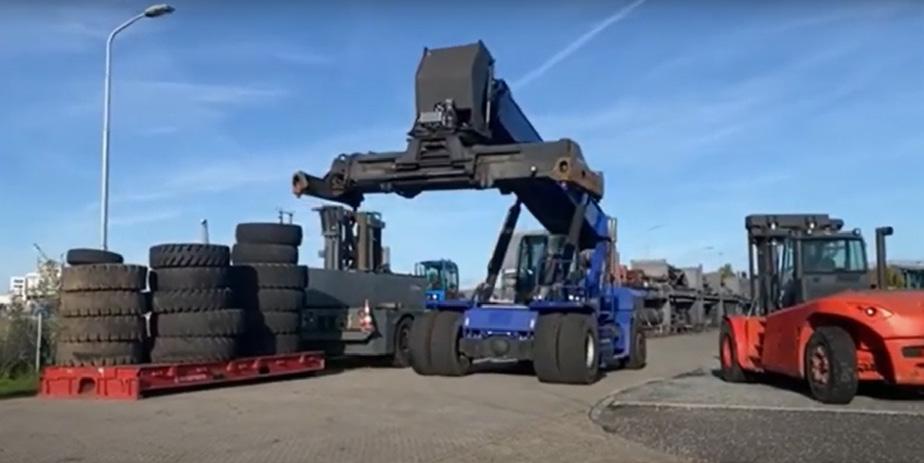
There is strong demand for second hand equipment sales and there is a broad base of suppliers but there are challenges, not the least of which is the longer retention of machines by their original purchasers impacting available stock.
“There are a number of key factors for the increase in the demand of used port equipment,” says Carlos Kohler, Owner, Port Solutions SL, Spain. “These include the Increase in the price of raw materials, longer delivery time for components, Covid lockdowns and the Ukraine war. High lead times on new equipment and significant price increases also prompt customers to search more extensively for used port equipment.”
Cees Halling, Sales Manager HQ, Forkliftcenter, agrees that lengthy delivery times for new machines play a part in the choice of second-hand equipment. But notes: “While there are lots of prospects for second-hand machines, it is difficult to source such machines with low hours and better condition. With long delivery times for new equipment, potential second-hand machines stay longer with original purchasers before being moved on.
Port Solutions SL, Spain’s, main business is the sale of used port equipment such as mobile harbour cranes. Carlos Kohler is also the dealer for Spain for Sany (reach stackers, forklifts, empty container handlers etc.), Verstegen (grabs), Phoenix Lightning (LED lighting) and Safetycage (safety cages for grab use).
Forkliftcenter also sells both new and used machines to its customers, who are mostly port-side terminal operators. The company reports some immunity to economic conditions: “For us, there is no difference,” says Halling. “High economies or low economies are both good for us, since we also can do rental in case our clients cannot finance a purchase”
Developing nations are taking advantage of second-hand cargo handling products and accompanying services –although this positivity is tempered by some restrictions. “The developing world has always been a good market,” says
Halling. “But we notice a lack of lower priced machines, and more countries only allowing machines to be imported from a certain year of manufacture.”
An example of a niche second-hand equipment supplier is Alatas which recently undertook an equipment supply project on a turnkey basis.
Alatas Middle East undertook the sourcing, commissioning and refurbishing of a Sea Hercules SH2000SEM crane. The unit was required to replace the client’s existing ageing barge crane. The replacement unit found was only five years old and with 4000 running hours on the clock. Following dismantlement and shipment to Jebel Ali, Alatas’ workshop crew then inspected, tested, rebuilt and installed the crane with minimal disruption to operations.
ALTERNATIVE PROVIDERS
As well as specialist second hand port equipment dealers, there are other parties active in this sector.
APM Terminals Asset Category Management buys and sells used port equipment, including used ship-to-shore cranes, mobile harbour cranes, rubber tyred gantries, straddle carriers, reach stackers, terminal tractors and top handlers. This relatively new division of a global terminal operator represents an interesting initiative – effectively it has a ready-made platform to operate from; i.e. the sale of its own used equipment. It further promotes alongside second hand equipment sales provision of support via its affiliated company APM Terminals Crane and Engineering Services, also established as a standalone entity.
Leading industry cargo handling equipment manufacturers are also active in second hand equipment sales – Liebherr, Kalmar and Konecranes are prime examples.
Liebherr reports it offers a wide choice of used cranes, which, depending on the condition, can be sold as is, with repairs or with a complete overhaul. Liebherr works to each customer’s individual requirements. Tests and detailed inspections are
SECOND HAND CARGO HANDLING EQUIPMENT 44 | DECEMBER 2022 For the latest news and analysis go to www.portstrategy.com
John Bensalhia looks at the market trends, players, expertise and cost savings now on offer in the second hand equipment sector
carried out by a team of experts, who investigate elements such as welds and load-bearing components. Among the services offered are repair or replacement of individual components (including replacement of telescopic booms in the event of damage), servicing and cleaning.
In a financial context, there is the option of bringing existing equipment into the equation for the purposes of part exchange.
Kalmar claims the advantages of offering a wide range of used machines with each unit offering “the reliability of a new machine” but “with more stories to tell.” The company delivers over 1000 units of used equipment annually via its network of transporters.
The company states each second hand unit is carefully scrutinised and inspected to ensure quality and reliability. The inspections encompass the overall condition of the machine, checks of important components as well taking due account of its past usage. Detail is provided for Kalmar customers in the form of comprehensive documentation and (in the event of Kalmar conducting the past service), the machine’s service history.
The used equipment Kalmar global web site provides an overview of all categories of second hand machine, and of individual units with pricing.
Konecranes has particularly enjoyed some success supplying second hand mobile cranes which can be supplied with conversion and upgrade works implemented if required. A second hand mobile crane project that Konecranes cites as indicative of its sector expertise is the supply of BMF Port Burgas EAD’s two used Konecranes Gottwald Model 6 Mobile Harbour Cranes to BMF Port of Bourgas, Bulgaria. The cranes were supplied against a background of BMF continuing the modernisation of terminal facilities post privatisation and increasing demand across a range of cargo sectors including general cargo and container traffic. The order for two Model 6 units was followed up by an order for a Model 3 crane – a unit sourced by Konecranes with just 12,000 working hours recorded.
UPGRADE AND TRANSPORT
When selling second hand equipment, as indicated above, the option invariably exists for the client to refurbish and upgrade equipment.
Liebherr’s range of services includes the chance to upgrade machines with contemporary technology. This can be agreed with the client on a bespoke basis, as is the case with the majority of parties active in the sector.
Forkliftcenter upgrades its machines up to its FLC Checked & Service Standard. Cees Halling notes: “In FLC Checked & Serviced Condition (FLC C&S), we deliver a complete check on the machine; for the machine to be supplied without leakages; and that all options on the machine will be in functional condition and repaired if necessary.
“In addition, the machine will get a 1000-hour service and will be supplied with a maintenance manual and English user manual. Plus, if customers wish, there can be a cosmetic refurbishment (painting etc.) plus specialised works such as the installation of monitoring systems”
The sale of second hand units is one thing but transportation to the final destination can be another area of
challenge, particularly with the larger units such as mobile cranes. An increasingly common trend is for the companies to offer shipping arrangements of the products themselves.
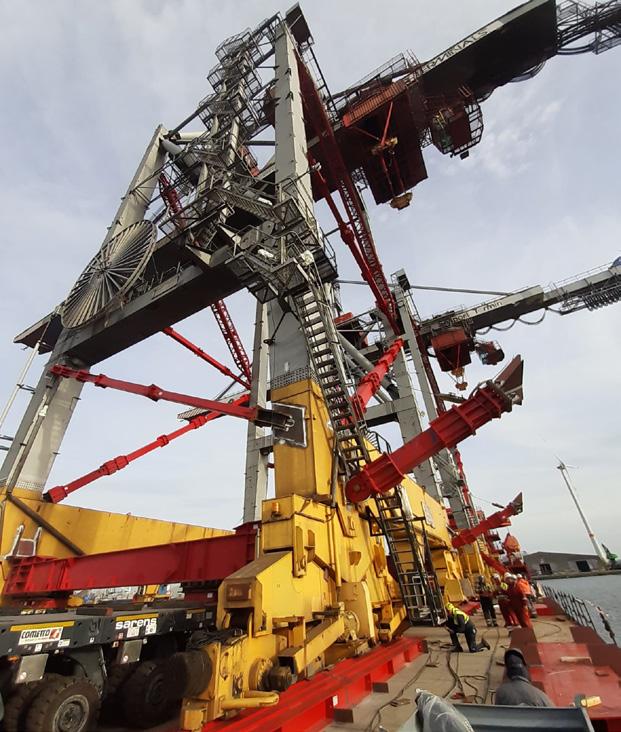
“Transport conditions are the key to a good sale at the moment,” says Kohler. “For this reason, I sell Ex Works (EXW), in which the buyer of a shipped product pays for the goods when they are delivered to a specified location.”
Halling states: “We have delivered during the last eight years to 138 different countries and each year, we have an average of 60-70 countries where we supply our machines. In 95% of all deals, we are providing the transport as well.”
Invariably, shipment by these and other companies is made either by offering a tender for the transportation work or inviting quotes or in conjunction with a regular transportation service provider. Safety considerations are a key factor as part of the transportation process, not an insignificant consideration with projects such as cranes on a heavy lift ship or a barge being towed.
BOTTOM LINE
Bottom line, there remains ongoing demand for a wide range of second hand cargo handling plant. Recently, the supply of this equipment has been negatively impacted by prevailing conditions – for example Covid lockdowns and other Covid influenced logistics – due to the original owners of plant retaining it longer than is usual, as a result of longer delivery times for new equipment and other influential factors. The basic appeal, however, of lower cost plant – often up to 50 per cent or more when compared to new equipment – will nevertheless continue to drive demand and encourage an increasingly professional supply sector. Indeed, this promises to particularly be the case in the short-term future with much of the world sinking into troubled economic times.
SECOND HAND CARGO HANDLING EQUIPMENT For the latest news and analysis go to www.portstrategy.com DECEMBER 2022 | 45
8 Port Solutions is a major player in the sector –transportation arrangements are a key consideration and the more so the larger the plant involved
‘‘
Second hand equipment supply may enjoy a boost in activity as the world heads into tough economic headwinds
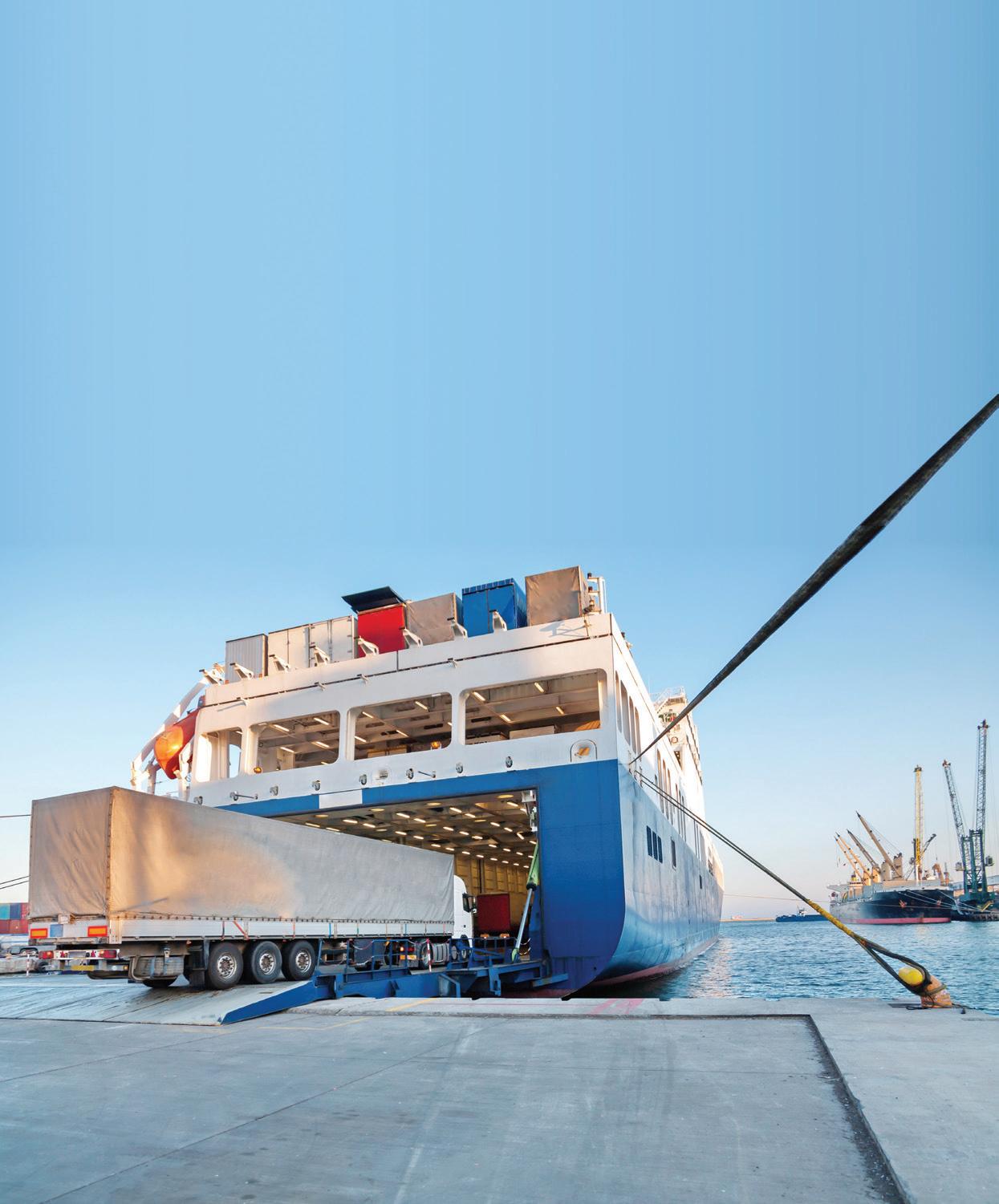






This year’s topics include: Delegate place includes: • Conference attendance including lunch & refreshments • Technical Visit • Electronic documentation • Conference Dinner (Premium Package) • Presentation download (Premium Package) Meet and network with international attendees representing shipping lines, ports, logistics companies, terminal operators and freight organisations. For more information on attending, sponsoring or speaking contact the events team: visit: coastlink.co.uk contact: +44 1329 825335 or email: info@coastlink.co.uk #Coastlink A pan European conference focussed on Growing Sustainable Supply Chains between Short Sea Shipping & Intermodal Transport Networks Book your place now • Market Sector Overview - the new normal in an adapting market • How to promote growth and deliver resilient end to end supply chains • Freeports: Driving change for coastal shipping and the supply chain • Sustainability & the Energy transition –a route to shipping freight sustainably Media partners: GREENPORT INSIGHT FOR PORT EXECUTIVES MOTORSHIP MARINE TECHNOLOGY THE Supporters:
Hosted by:
NEUERO Industrietechnik GmbH

Specialist for pneumatic ship unloaders and mechanical ship loader. NEUERO follows the MADE IN GERMANY quality tradition. Now with more than100 years of tradition in the manufacture of reliable and high-quality conveyor systems worldwide.
Email: neuero@neuero.de Tel: +49 5422 9 50 30 neuero.de/en/
B ULK
HANDLING
Bedeschi S.p.A
For more than a century, Bedeschi is providing effective and reliable solutions in a wide variety of industries (bulk handling, marine logistics and mining), capitalizing on synergies and cross competences.
Via Praimbole 38, 35010 Limena (PD) – Italy
Tel: : +39 049 7663100 Fax: +39 049 8848006 Email: sales@bedeschi.com Web: www.bedeschi.com

The BEUMER Group is an international leader in the manufacture of bulk material handling systems: Overland Conveyor Pipe Conveyor Stacker & Reclaimer Shiploader Tel.: +49 2521
240 E-mail: info@beumer.com

ARGO HANDLING EQUIPMENT
Over 60 years supporting Container Terminals in port operations: we create strategic value and increase profitability through solid and reliable STS Portainer® and RTG Transtainer® cranes, services & Advanced Port Technologies.
PACECO® CORP. World Headquarters 25503 Whitesell Street Hayward, CA 94545 Tel (510) 264-9288 email@pacecocorp.com www.pacecocorp.com

ONNECTION SOLUTIONS
As one of the leading manufacturers of quick connector systems,Stäubli covers connection needs for all types of fluids, gases and electrical power.

Tel: +33 4 50 65 61 97 connectors.sales@staubli.com www.staubli.com/en-de/ connectors/
To advertise in the Port Strategy Directory
Contact
Telestack

SAMSON Materials Handling Ltd specialises in the design and manufacture of mobile bulk materials handling equipment for surface installation across multiple industrial segments. Designed for rapid onsite set-up and continuous high performance SAMSON equipment provides an excellent return on investment.
SAMSON Materials Handling Ltd specialises in the design and manufacture of mobile bulk materials handling equipment for surface installation across multiple industrial segments. Designed for rapid onsite set-up and continuous high performance SAMSON equipment provides an excellent return on investment.
Gemini House Cambridgeshire Business Park, 1 Bartholomew’s Walk, Ely Cambridgeshire CB7 4EA England, United Kingdom (UK)
Tel: +44 1353 665001 Fax: +44 1353 666734 sales@samson-mh.com www.samson-mh.com

Taylor Machine Works, Inc.
Taylor Machine Works designs, engineers, and manufactures more than 100 models of industrial lift equipment with lift capacities from 4,000-lbs. to 125,000-lbs.
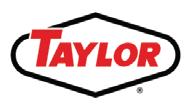
YOU CAN DEPEND ON BIG RED! 3690 N Church Avenue Louisville, MS 39339 USA +1 662 773 3421 contact_sales@taylorbigred.com www.taylorbigred.com
LASE Industrielle Lasertechnik GmbH

LASE offers innovative and productive solutions for ports by combining state-of-the-art laser scanner devices and sophisticated software applications. We are specialised in the fully automated handling of containers, cranes or trucks.
Rudolf-Diesel-Str 111 D-46485 Wesel, Germany
Tel: +49 (0) 281 - 9 59 90 - 0 info@lase.de www.lase.de
#WeHaveTonnesToTellYouAbout
HANDLING SYSTEMS :
– Portable grains pumps
– Pneumatics continuous barge and ship unloaders 100-1200 tph
– Simporter twin-belt unloader up to 2500 tph
– Loaders up to 2500 tph
Complete turnkey projects VIGAN Engineering S.A. Belgium Tél.: +32 67 89 50 41 www.vigan.com/info@vigan.com
12:03 A
P4.1 e-chain® Energy chain with optional intelligent wear monitoring for double the service life, travels of up to 1.000 m, speeds of up to 10 m/s and fill weights of up to 50 kg/m.
LECTRIFICATION SOLUTIONS
igus® GmbH Spicher Str. 1a D-51147 Köln, Germany Tel. +49-2203-9649-0 info@igus.eu igus.eu/P4.1

igus® GmbH Spicher Str. 1a, 51147 Köln, Germany Tel. +49-2203-9649-0 info@igus.eu igus.eu/P4.1
13 15
TO JUNE 2023 Southampton United Kingdom

Rohde Nielsen A/S
Specialising in capital and maintenance dredging, land reclamation, coast protection, Port Development, Filling of Caissons, Sand and Gravel, Offshore trenching and backfilling

Nyhavn 20 Copenhagen K. DK-1051 Denmark +45 33 91 25 07 mail@rohde-nielsen.dk www.rohde-nielsen.dk
VAHLE PORT TECHNOLOGY
VAHLE is the leading specialist for mobile power and data transmission
Westicker Str. 52, 59174 Kamen, Germany Email: port-technology@vahle.de Web: www.vahle.com

PRODUCTS & SERVICES DIRECTORY
C ARGO HANDLING SYSTEMS
C OMPONENTS
Staubli_Directory Mar
15:49 C
D REDGING E
2021.indd 1 25/02/2021
Neuro Directory Jan-Feb 2020_Neuero 29/
Web: www.beumer.com Beumer Directory Jan 2021.indd 1 27/01/2021 11:29
VAHLE provides the solutions to reduce the carbon footprint while increasing the productivity. RTGC electrification including positioning and data transmission making RTGC ready for Automation. C
B
ULK HANDLING
Directory June
1 26/05/2021 12:20
the latest news and analysis go to
DECEMBER 2022 | 47
Telestack are a leading global manufacturer of equipment for the bulk material handling industry including Ship Loaders/Unloaders, Hopper Feeders, Truck Unloaders, Bulk Reception Feeders, Stockpiling Conveyors, Link Conveyors and Telescopic Stackers. Tel: +44 (0)2882 251100 Email: sales@telestack.com www.telestack.comw
2021.indd
For
www.portstrategy.com
DRY AGRIBULK MATERIALS
Vigan ID.indd 1 25/01/2022
UTOMATION TECHNOLOGY
ifm electronic gmbh ifm is one of the world’s leading sensor companies in the automation of measurement and control, optimizing technical processes in almost all industries. +49 201 24 22 0 info@ifm.com www.ifm.com
Arrate Landera
1329
Gemini House Cambridgeshire Business Park, 1 Bartholomew’s Walk, Ely Cambridgeshire CB7 4EA England, United Kingdom (UK) Tel: +44 1353 665001 sales@samson-mh.com www.samson-mh.com
+44
825335 www.portstrategy.com
Heavy duty rol e-chain® P4HD.56R The new heavy-duty rol e-chain meets all the relevant requirements for container cranes of the next and next-but-one generations. Longer and longer travels, greater dynamics, short stress cycles, zero failures.
For more information visit: seawork.com contact: +44 1329 825335 or email: info@seawork.com
Fogmaker develops, manufactures, and markets fire suppression systems for engine compartments with high pressure water mist. Fogmaker is a market leader for automated fire suppression systems with 200,000 installations in more than 50 countries since 1995.
Tel: +46 470 77 22 00 info@fogmaker.com www.fogmaker.com

MRS Greifer GmbH

Grabs of MRS Greifer are in use all over the world. They are working reliably and extremely solid. All our grabs will be made customized. Besides the production of rope operated mechanical grabs, motor grabs and hydraulic grabs we supply an excellent after sales service.

Talweg 15-17, Helmstadt-Bargen 74921, Germany Tel: +49 (0)7263 - 91 29 0 Fax: +49 (0)7263 - 91 29 12 info@mrs-greifer.de www.mrs-greifer.de
H ANDLING EQUIPMENT
Orts GMBH Maschinenfabrik
Over 40 years experience constructing and manufacturing a wide range of grabs, including electro-hydraulic grabs (with the necessary crane equipment) radio controlled diesel hydraulic grabs, 4, 2 and single rope grabs all suitable for bulk cargo.
Schwartauer Str. 99 D-23611 Sereetz • Germany Tel:+49 451 398 850 Fax: +49 451 392 374 soj@orts-gmbh.de www.orts-grabs.de
Künz GmbH
Founded in 1932, Künz is now the market leader in intermodal rail-mounted gantry cranes in Europe and North America, offering innovative and efficient solutions for container handling in intermodal operation and automated stacking cranes for port and railyard operations.
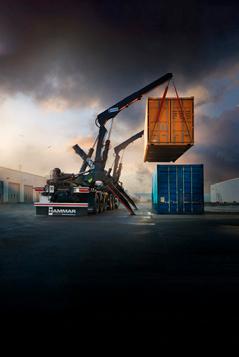
Gerbestr. 15, 6971 Hard, Austria T: +43 5574 6883 0 sales@kuenz.com www.kuenz.com
TPORT
AUTOMATION
CAMCO Technologies NV


IDENTEC SOLUTIONS



SANY Europe GmbH offers a broad spectrum of high-performance mobile port machines such as Reach Stacker, Empty Container Handler, Heavy Duty Forklift Trucks and Material Handler

Sany Allee 1 D-50181 Bedburg Tel: +49 2272 90531 100 Email: info@sanyeurope.com www.sanyeurope.com Sany ID.indd 1 25/01/2022 11:42
Sany Allee 1 50181 Bedburg, Germany Tel: +49 2272 90531 100 Email: info@sanyeurope.com www.sanyeurope.com
Technologielaan 13 Leuven, Belgium +32-16-38-9272 +32-16-38 9274 info@camco.be www.camco.be
Visual- and Micro Location- assisted process automation solutions for container, ro-ro and rail terminals worldwide. Accurate crane, gate & rail OCR systems and Gate Operating System software helping terminals accelerate terminal and gate activity. Siwertell
is an industry-leading, trusted partner in managing and monitoring reefer containers and optimizing entire terminal operations through solutions like Reefer Runner and Terminal Tracker.
Contact: Stephan Piworus, Global VP Sales Marine & Ports, spiworus@identecsolutions.com; Mobile: +49 151 74122606 www.identecsolutions.com


Conductix-Wampfler
The world specialist in Power and Data Transfer Systems, Mobile Electrification, and Crane Electrification Solutions. We Keep Your Vital Business Moving!
Rheinstrasse 27 + 33 Weil am Rhein 79576 Germany Tel: +49 (0) 7621 662 0 Fax: +49 (0) 7621 662 144 info.de@conductix.com www.conductix.com
VISYOy
Visy systems reduce expenses, optimize safety & security, and increase throughput capacity via process automation. Our singleplatform gate operating system and OCR solutions manage all cargo, assets & personnel movements via quay, rail or road to keep operations moving.
VISY takes pride in solving operational problems, specialising in gate automation and access control solutions in ports and terminals. Their solutions streamline processes resulting in saving money and increasing productivity. Tel: +358 3 211 0403 Email: sales@visy fi Web: www.visy.fi/
IDELIFTER/SIDELOADER
TVH is a global player in the field of spare parts and accessories for heavy forklifts, reach stackers, container handlers, spreaders and terminal tractors.
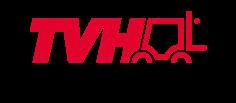

With over 96,000 references in stock and more than 644,000 known references, TVH offers quality replacement parts for many brands and makes, including the hard-to-find ones.
Tel: +44 2476 585 000 sales.team.uk@tvh.com www.tvh.com
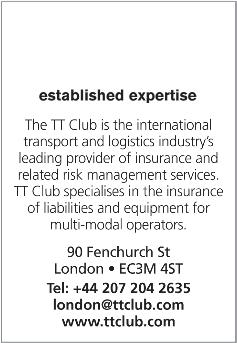
S PARE PARTS PRODUCTS & SERVICES DIRECTORY 48 | DECEMBER 2022 For the latest news and analysis go to www.portstrategy.com
I NSURANCE P ORT
AUTOMATION S
G RABS
F IRE SUPPRESSION SYSTEMS TT Club Directory March 2021.indd 1 01/03/2021 14:40 I
Fogmaker Directory.indd 1 01/02/2021 13:12
Directory
Ship Unloaders Category.indd 1 12/05/2020 14:12 20 15 17 TO Seawork Directory Filler.indd 1 30/03/2021 10:12 TT Club Directory March
-
2021.indd 1 01/03/2021 14:40 Camco ID June 2021.indd 1 19/05/2021 14:16
P OWER TRANSMISSION
To advertise in the Port Strategy Directory Contact Arrate Landera +44 1329 825335 www.portstrategy.com To advertise in the Port Strategy Directory Contact Arrate Landera +44 1329 825335 www.portstrategy.com The world leading manufacturer of Sideloaders, self-loading semi-trailers for versatile & efficient container handling. www.hammarlift.com info@hammarlift.com For more information visit: seawork.com contact: +44 1329 825335 or email: info@seawork.com 13 15 TO JUNE 2023 Southampton United Kingdom For more information visit: seawork.com contact: +44 1329 825335 or email: info@seawork.com 13 15 TO JUNE 2023 Southampton United Kingdom
ELME Spreader AB
ELME Spreader, world’s leading independent spreader manufacturer supports companies worldwide with container handling solutions that makes work easier and more profitable. Over 21,000 spreaders have been attached to lift trucks, reach stackers, straddle carriers and cranes.

Stalgatan 6 , PO Box 174 SE 343 22, Almhult, Sweden Tel: +46 47655800 Fax: +46 476 55899 sales@elme.com www.elme.com
ERMINAL OPERATIONS SYSTEMS
Navis understands that as ships get larger and operational processes become more complex - efficiency, collaboration and productivity are essential. As a trusted technology partner, Navis offers the tools and personnel necessary to meet the requirements of a new, and ever-evolving, global supply chain.

World Headquarters 55 Harrison Street Suite 600 Oakland CA 94607 United States
Tel: +1 510 267 5000 Fax:+1 510 267 5100 Web: www.navis.com
ERMINAL OPERATIONS
SYSTEMS
Tideworks Technology provides comprehensive terminal operating system solutions for marine and intermodal terminal operations worldwide. Tideworks works at every step of terminal operations to maximize productivity and customer service. info@tideworks.com +1 206 382 4470 www.tideworks.com

T RACTORS
The Brain of Logistics
With more than 30 years experience in IT Solutions and Business Operation Consultancy DSP offers a large portfolio of professional services and products to support terminal operations processes and system.
DSP Data and System Planning SA Via Cantonale 38 6928 Manno, Switzerland

Tel: +41 91 230 27 20 Fax: +41 91 230 27 31 info@dspservices.ch www.dspservices.ch

For the latest news and analysis go to
Solvo Europe B.V.
Solvo’s software solutions such as TOS or WMS help container and general cargo terminals take full care of their cargo handling processes and make sure the clients expectations are exceeded.
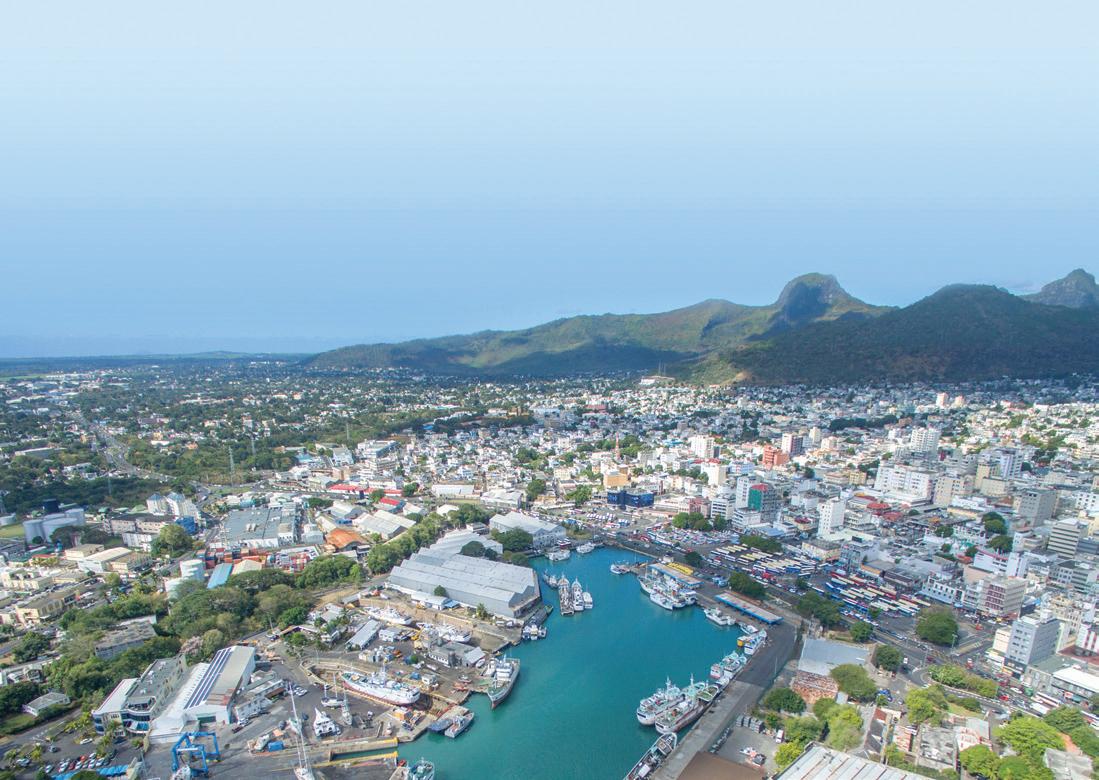
Prinses Margrietplantsoen 33, 2595AM, The Hague, The Netherlands Tel: +31 (0) 702-051-709 Email: sales@solvosys.com www.sovosys.com
TGI Maritime Software is a Terminal Operating System editor and integrator specialized in the support of Small to Medium Terminals. Its expertise is built on 34 years of experience within the maritime sector. TGI provides comprehensive services to its customers all along their projects. OSCAR TOS and CARROL TOS have already been successfully handled by 40 container and RoRo terminals worldwide.
Tel : +33 (0)3 28 65 81 91 contact@tgims.com www.tgims.com
MAFI Transport-Systeme GmbH

Specialised in the development and production of heavy-duty equipment for transporting containers, semi-trailers, cargo/roll trailers and special container chassis in ports and industry.

Hochhäuser Str 18 97941 Tauberbischofsheim, Germany
Tel: +49 9341 8990 sales@mafi.de www.mafi.de
W IRE ROPES
Brunton Shaw UK is a successful manufacturer of high quality wire ropes for a wide range of applications. The company effectively combines more than 130 years of experience and tradition with an up to the minute range of products, and a customer service package ideal for the modern market place.
Tel: +44 1909 537626 Email: info@brunton-shaw.co.uk
www.brunton-shaw.com
PRODUCTS & SERVICES DIRECTORY
For the latest news and analysis go to www.portstrategy.com/news DECEMBER 2019 | 53
T
S PREADERS T
Mauritius Maritime Week 2022 Continues to be the Biggest Annual Container Ports, Shipping and Transport Logistics Exhibition and Conference in the Indian OceanRegion Mauritius Maritime Week 2022 Continues to be the Biggest Annual Container Ports, Shipping and Transport Logistics Exhibition and Conference in the Indian OceanRegion Follow us on: enquiries@transportevents.com www.transportevents.com +852 2157 3907 +852 3895 0948 The Ravenala Attitude, Mauritius Tuesday 13 December to Thursday 15 December 2022 NETWORKING RECEPTION NETWORKING DINNER LOCAL DELEGATES DISCOUNT 250 CONFERENCE DELEGATES INTERNATIONAL EXHIBITION INTERNATIONAL CONFERENCE TECHNICAL SITE VISIT Associate Member Follow us on: Official Carier Strategic Partner Supporting Partner Hosted By T ERMINAL OPERATIONS SYSTEMS
POSTSCRIPT
MARKET SHARE VERSUS PROFITS
Mature markets today bring new challenges in delivering major new port capacity, especially in a competitive climate. The issue is how to reconcile the economic impact-orientated agenda of port landlords with the profit motive of terminal operators? Andrew Penfold investigates.
As the port market begins to approach some degree of normality post-COVID-19, the question of capacity expansion is once again coming to the fore. Large scale investment plans by port authorities in mature markets have been dusted down again and it seems certain that major investment in Europe and North America will once again proceed.
However, a major question remains in conjunction with this: will capacity match demand? Local vested political interests have quite different concerns from terminal operators. The horizon of the former may well be 30 years plus, whilst the terminal operator will only be looking either at the concession period he has or, quite often, just the loan payback period. There is a frequent mismatch between the two.
This matter of perspective is well known, but bigger challenges emerge when two – usually state-owned – ports are competing for the same or significantly overlapping hinterlands. The motive for the port authority is primarily market share and the resulting economic spin-off benefits from anchoring significant business locally. There’s an extensive literature on the magnitude of these benefits but a conservative view is that a factor of at least three needs to be applied to the basic revenue generated by simply handling a container. This is all very well but if localised overcapacity results from these statebacked policies then it becomes very difficult for the concessioned operator to define accurately a unit revenue for their activities. This is a major problem when bidding for a new concession, with the position made worse by the frequent presence of nonindustry infrastructure investors.
Port authorities have always been swayed by these considerations and various policies have been suggested to try to mitigate some of the grossest resulting over-capacities. The saga of the EU’s Seaport Policy has been running for years and remains basically unresolved. The need to demonstrate ‘commercial’ terms is all very well, but always difficult to define in the real world.
The situation in Antwerp is interesting with long term planning once again focusing on development of the Saeftinghe Dock which would provide massive new deepsea capacity at the port. At the same time, although the Maasvlakte II project infrastructure at Rotterdam is now in place, the actual pace of expansion for the current operators – APM and DP World – remains unclear. How the commercial return from the current two terminals can be squared with the enormous costs of the entire project remains
unclear. Both locations are (essentially) covering the same hinterlands. Adding to the capacity equation is the recently announced plan by MSC in association with Hutchison to develop a major new container terminal in the Europahaven, Rotterdam. Specifically, the terminal will be developed where the north side of the Hutchison Ports ECT Delta terminal and Hutchison Ports Delta II (the former APMT-R site) are located.
There are plenty of other locations where ports share overlapping hinterlands and where expansion plans may generate the problematic effect of too much capacity too soon. Another prime example in the Europe zone is the ports of Gdansk and Gdynia, both pursuing large scale expansion plans. On the other side of the world, the port of Newcastle, New South Wales has just had restrictions removed from participating in the container handling business which could see overall capacity issues arise between it and the Botany Bay container handling centre.
Superimpose on this capacity issue the question of defining the actual markets that are being served and the stability of the major line customers over time and you have a very difficult investment argument for the terminal operator. If the premiss for investment involves a high share for transshipment, then yields will be weak and place great pressure on potential scale of investment.
Similarly, the current shipping line alliance structure has been in place for some time with only limited adjustments. Over the timeframe of these large-scale investments, we can’t be sure of this remaining the case. Factoring all of this into an effective bid is always complex, but if other interests are focused on market share at the expense of commercial returns the position leans towards untenable.
The days when an investor (port or private) could rely on continued container trade growth may well have passed – time to take a serious look again at these issues. Its true that ‘a rising tide lifts all boats’, but what is the state of the ocean at present?

50 | DECEMBER 2022 For the latest news and analysis go to www.portstrategy.com
8 MSC/Hutchison’s terminal development plan for the Europahaven, Rotterdam adds further complexity to the task of achieving rational capacity expansion in a competitive marketplace
…bigger challenges emerge when two – usually stateowned – ports are competing for the same or significantly overlapping hinterlands
‘‘

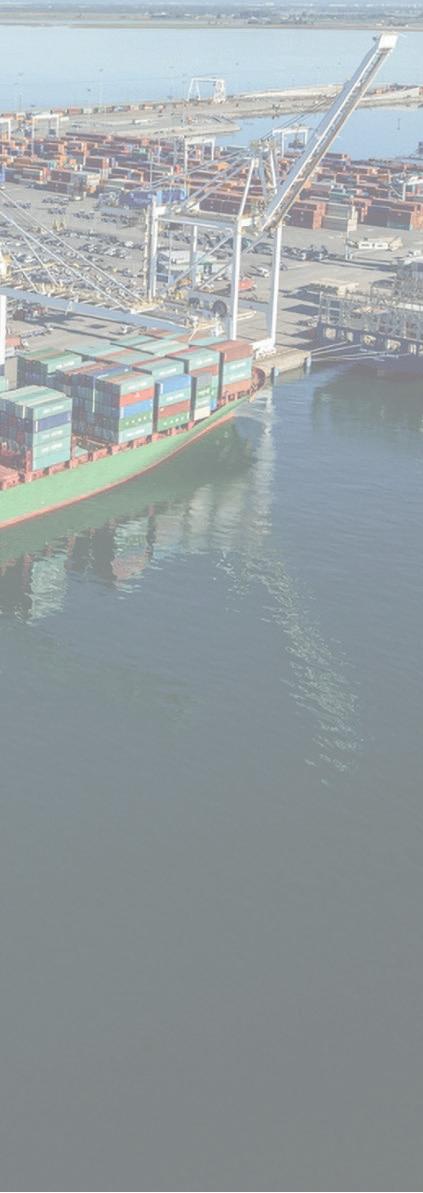
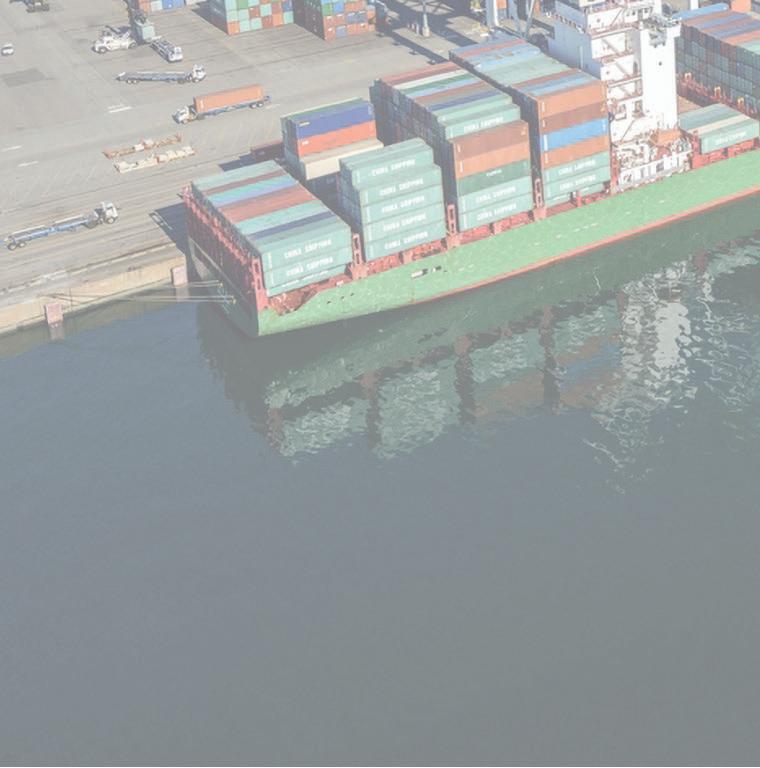







It’s more important now than ever to deliver your marketing message and business competencies to your desired audience. It’s our mission to engage with our audiences through multi-media platforms, offering our commercial partners a wide range of opportunities for campaign delivery. We deliver bespoke packages and quantifiable ROI. Let us be part of the solution – Contact Tim Hills, Brand Manager, (+44) 1329 825 335 or email sales@greenport.com Find out more about the marketing packages GreenPort have to offer. Contact us today GREENPORT INSIGHT FOR PORT EXECUTIVES MAGAZINE RECIPIENTS OPT-IN ENEWS SUBSCRIBERS PAGEVIEWS PER MONTH 14,400 13,300 18,100 Reach industry professionals with GreenPort
Sustainable & Smart Mobility Strategy - Ricardo Batista, Policy Officer, Directorate-General for Mobility and Transport European Commission. Development cycles towards ammonia-fuelled two-stroke engines - Dr Andreas Schmid, General Manager Technology Development, WinGD. Will “multi-fuel” propulsion engines be the solution to solve the “future fuel” uncertainty? - Rolf Stiefel, Regional Chief Executive, Bureau Veritas Marine & Offshore Economic and Ecological Considerations for Wind-Assisted Ship Propulsion Systems - Karsten Hochkirch, Head of Ship Performance Center, DNV




















MOTORSHIP MARINE TECHNOLOGY THE Organised by: #MotorshipPFF 22 24 Hamburg Germany NOV 2022 2022 43RD Headline Sponsor
Link to purchase and download: www.motorship.com/propulsion-and-future-fuels-conference/buy/pff-2022-conference-papers Contact: +44 1329 825 335 Or email: conferences@propulsionconference.com Supported by: Sponsored by: Headline Sponsor Silver Sponsors Did you miss it? 76 Presentations, Papers and videos from over 40 industry-influencing professionals. Now available to purchase and downloads.
includes:
:
Content









































































































































































